

The Ultimate Munich Public Transport Guide: Ticket Prices, Deals & Zones (2023)
March 20, 2023
*FYI - this post may affiliate links, which means we earn a commission (at no extra cost to you) if you purchase from them. Also, as an Amazon Associate, I earn from qualifying purchases. For the full scoop on what this means, feel free to check out our Privacy Policy and Disclosure.
Confused by the Munich public transport system? Looking for a Munich zone map and an up-to-date list of fares? Let us simplify that for you!
This simple guide was created to help you understand Munich’s (somewhat confusing) public transport system in a simple and concise way. Los geht’s!
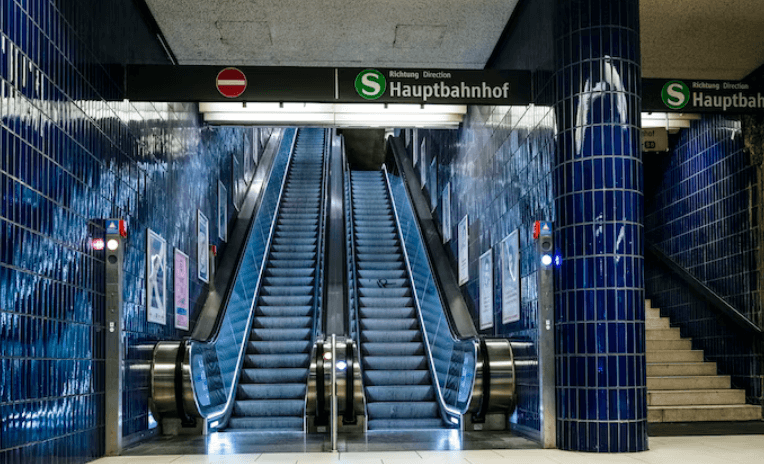
How to Use Munich Public Transport
Munich operates on an honour-based fare system, which means there are no entry gates/barriers to any U-Bahns, S-Bahns, trams, or buses.
Instead, ticket controllers conduct random inspections for tickets (often dressed incognito). Those caught without a VALID ticket will be fined, so be sure to validate your ticket beforehand at one of the blue validation machines.
The ticket inspectors in Munich are notoriously merciless when it comes to having the right ticket, so it’s not enough to simply buy a ticket – you must make sure your ticket is the correct one, and properly validated as well.
Where To Buy Munich Public Transport Tickets
The easiest way to ensure you have the right ticket is by using the MVV Journey Planner or MVG’s updated app, MVGO .

MVGO lets you book tickets via HandyTicket ( Deutschland Ticket soon!), get connection information, and see live departure times directly through the app.

The app can be used to show transportation locations in real time, features localized language changes and additional support for those who are mobility impaired – so everyone can have their own personalized Munich public transport guide!
But that’s not all! You can also use MVGO for bicycle, e-bike and e-scooter rentals throughout the city.
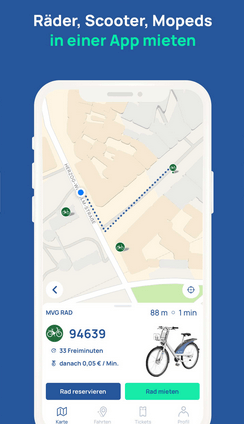
First, you find (through the app) where to find the rental type you’re looking for. Then, you use the app’s QR scanner to scan the specific bike or scooter you want to use, registering it to your ID. After that, the bike is yours to use until you put it back! It’s all part of MVG’s bike extension.
Munich Public Transport Ticket Tariff Breakdown
The ticket you need depends on the following factors:
- How many zones you’re travelling through
- How many stops you’re travelling
- How many trips you’ll need
In terms of zones, Munich is divided into 7 tariff zones – the largest of which is the M-Zone, which includes most of the city centre.

As a tourist, you’d most likely be staying within the M-Zone unless you’re travelling to/from the airport. The more zones you must travel through, the more expensive your ticket will be.
For trips where you are only moving 4 stops maximum on regular buses/trams or only 2 stops maximum on the S-Bahn, U-Bahn or Express buses, you are eligible for a cheaper Short Trip (Kurzstrecke) ticket. Otherwise, you must buy a regular one-way ticket (Einzelfahrkarte).
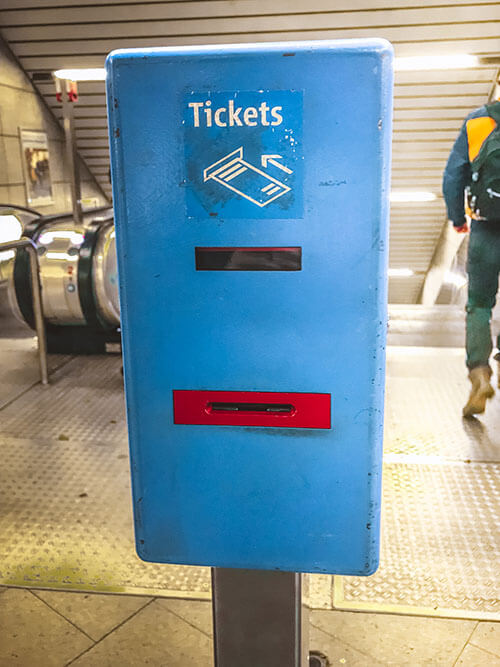
All single tickets in Munich are one-way only. This means you can only use the ticket for a single trip in one direction, regardless of the validity time of the ticket.
Transfers are fine, so long as you are travelling in a single direction). So if you plan to do a single trip, buying a single ticket makes sense.
If however you plan to use public transport multiple times throughout your time in Munich, then getting a stripe ticket, day ticket, or IsarCard (weekly/monthly pass) may make more sense.
Children are of course eligible for cheaper tickets. The discounts are as follows:
- Children under 6: Travel free
- Ages 6-14: Cheaper fares (exact rates below)
- Youth 15-20: Eligible for the cheaper U21 Stripe Ticket
Munich Public Transport Ticket Deals
Of course, there are also perks for passengers and a variety of deals you should definitely be familiar with!
Free Rides On Your Birthday
With your own ID set up, you’ll be able to register when your birthday is on the app, which will record for the free use of the trains on that day!
Therme Erding Ticket

You can purchase a ticket for the thermal bath/water park in the Therme Erding . This ticket includes fare to and from the baths, 4 hours on-site and use of the galaxy slide paradise and wave pool.
If you’d like, once you arrive you may also pay for an extra day pass and access to the saunas. The return fare ticket is good for use until 6 am the following day.
The Bayern Ticket

The Bayern ticket is perfect for groups looking to do some travelling across the countryside, allowing for up to 5 adults to travel at a reduced rate on all regional trains.
The ticket works with a base fare of 26€ and adds 8€ for each subsequent adult up to a total of 5. This ticket is also great for day trips with children, as one adult can ride using this ticket and not pay for any children under the age of 15, no matter how many they have.
The 49 Euro Ticket / Deutschland Ticket

The 49 euro ticket is a new feature coming out in May of this year. This ticket will be good for unlimited monthly rides on any regional train in the country on any day of the week (including holidays!)
The ticket can be purchased online and is recorded digitally to each person’s ID (the ticket is not transferable). Since it is being offered as a monthly subscription model, the ticket can be cancelled at any time, so don’t worry about getting locked into any annual membership costs!
The Munich Card
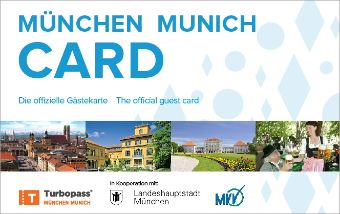
Last but not least, we have the Munich card . The Munich card can be purchased as a single, group, or children’s card with uses for anywhere between 24 hours and 5 days.
This card will give you unlimited travel within the time paid for and up to a 70% discount at over 100 of the top attractions in the city – The Deutsches Museum, the Pinakothek der Moderne, Sea Life and Nymphenburg Palace to name a few.
The card is also good for discounts at the most popular restaurants in the city. You can download the guidebook that comes with the ticket for a full list of discounts available!
Munich Zone Map
As mentioned above, Munich is divided into 7 tariff zones . You can view a colour-coded map of the tariff zones here.
The zones (and their colours) are as follows:
- M Zone (White): Encompasses the majority of the central Munich area
- Zone 1 (Yellow)
- Zone 2 (Red)
- Zone 3 (Light Blue)
- Zone 4 (Green)
- Zone 5 (Orange): Where Munich Airport is located
- Zone 6 (Blue)
Once you know which zones you’re travelling through, buying the right ticket should be simple!
- For a single trip, buy an Einzelfahrkarte for the zones you’re travelling through (or a Kurzstrecke if travelling less than 4 stops on a regular bus/tram or less than 2 stops on the U-Bahn, S-Bahn, Express Bus)
- If you plan to travel multiple times in a day, look into buying a day ticket for your zones
- If you expect to travel multiple times but not necessarily all in the same day, consider buying a Stripe Ticket to validate as you go
- If you expect to travel a lot within a week or month, consider buying an IsarCard
Current Prices for MVV Public Transport Tickets in Munich 2023
- Single ticket short-distance: 1.90 euros
- Single ticket zone M/2 zones: 3.70 euros
- Single ticket children zone M-6: 1.80 euros
- Strip ticket: 16.30 euros
- Strip ticket U21: 8.90 euros
- Group day ticket (zones M to 5): 27.80 euros
- Single day ticket (Zone M): 8.80 euros
- Children’s day ticket: 3.50 euros
- Bicycle day pass: 3.30 euros
- IsarCards: Vary based on time of validity/zones. Full list here
More Questions About The Munich Public Transport?
Let us know in the comments! We hope you found this guide helpful.
- Recent Posts

Leave a Comment Cancel reply
Save my name, email, and website in this browser for the next time I comment.
💌 Contact for a Collab
📑 Impressum
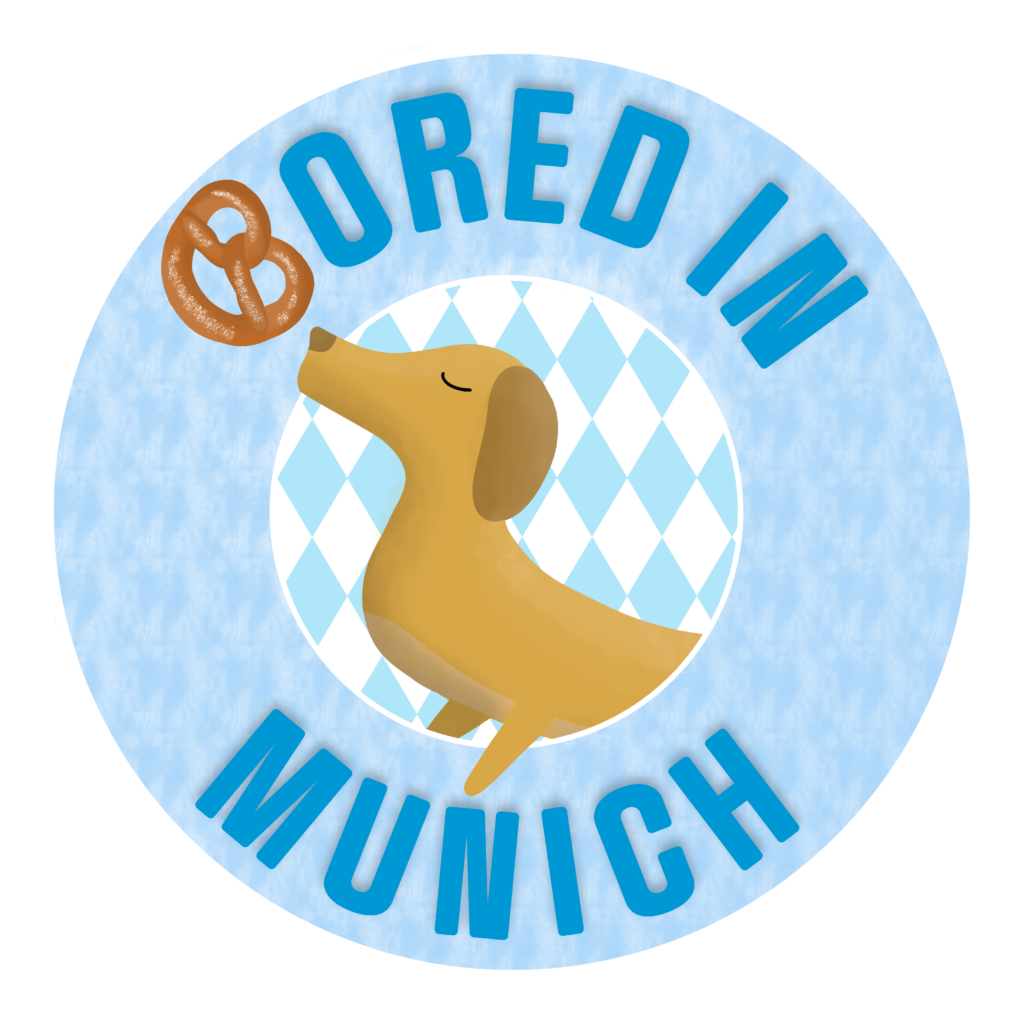
Munich Expat life
📆 Upcoming events
🌈 Queer in Munich
Don't be shy, get social ⤵️
Day Trips From Munich
Top Things to Do
Free Things to Do
Things to Do With Kids
Top Museums in Munich
Munich's English Garden
Complete Guide to Oktoberfest
Top Restaurants in Munich
Best Beer Halls
Top Beer Gardens
Guide to Munich's Hofbräuhaus
Best Time to Visit
Weather & Climate
Munich International Airport Guide
Best Munich Hotels
Public Transportation
Getting Around Munich: Guide to Public Transportation
Naomi Kaye Honova is a freelance journalist and parent. Kaye's work has been featured in Today's Parent, Kveller, Motherly, and other publications.
Munich is an excellent city for using public transit, featuring a comprehensive network of subways, trams, buses, and commuter trains that take you to virtually anywhere you need to go within the city and its outlying suburbs (though transit is more limited out in the ‘burbs). Though a couple of aspects might be a bit confusing at first to those new to the city, it’s relatively simple to navigate and get where you need to go.
How to Ride the U-Bahn
Munich’s U-Bahn , or underground subway system, is probably the transit system utilized most by visitors and also regularly by locals. It’s fast, easy to navigate, and the underground stations tend to be clean and safe—some of them even pipe in classical music!
The main disadvantage to Munich’s public transit system is the price, as it’s expensive. A single ticket within the central zone is 3.30 Euros. You can save money by buying a “Streifenkarte” (striped ticket) for ten individual rides, a daily, weekly, monthly or even yearly pass if you will be using transit frequently. There are also group tickets than can be used by multiple people for certain amounts of time.
Munich has a wide variety of ways to pay for tickets. You can buy tickets from machines at stations, as well onboard trams and buses, using cash, and in some cases also credit card or debit card. You can also opt to buy tickets on your cellphone using the MVG or Deutsche Bahn App , depending on what form of transit you are taking.
The U-Bahn doesn’t operate frequently in the hours of the early morning, so it might be worth looking into the night tramlines if you need to get somewhere at 2 am. During the daytime it is usually reliably frequent and in rush hours additional trains run. Generally speaking, you won’t have to wait more than 10 to 15 minutes max for a subway, usually much less.
If you buy a ticket from a blue MVG machine, make sure to validate the ticket by stamping it in in the stamping machines at subway stations and on buses and trams. Controllers do periodic sweeps to check tickets and if you have not validated your ticket, you will be fined. The other important thing to note is to check your travel zone. Munich transit is divided into rings. Look on the map at the subway station to see where your stop falls into in the ring zones (if you’re staying within central Munich, it’ll be just the first two rings). You will have to pay extra for a ticket that goes further or stamp more stripes on your Streifenkarte if you need to go somewhere, say, in ring six. A one-way ticket in one direction is valid for two hours. You can use it to transfer from, say, a subway to a bus, as long as you stay within your ring zone.
For the most part, Munich subway stations are very accessible for the handicapped or those using strollers or the elderly. There are elevators and escalators and spaces for wheelchairs. Strollers are supposed to be parked near the doors of the subway.
Other Forms of Transit in Munich
Munich is hardly limited to the U-Bahn, with a vast network of buses, trams, and commuter trains. The ticketing system for buses and trams is the same for the U-Bahn, and you can typically buy tickets directly on the bus or tram from a machine, though most take cash only. Note that if you have a stroller or wheelchair, there are designated spots marked on bus and tram doors.
Munich’s bus lines are the primary way to get around in the suburbs and areas not reached by U-Bahn or tram, but there are also a fair number of buses in the city center as well. If you need to get somewhere in a hurry, there are a number of “Express Bus” lines that make only a few stops to prime locations.
Perhaps the most romantic of Munich’s transit options, the trams are another convenient and scenic way to get around town and also serve some of the more far-flung neighborhoods as well as central routes.
S-Bahn (Commuter Train)
Munich’s S-Bahn lines run through the city center and serve the suburbs of Munich, making it a great option for suburban commuters and day trips to some of Munich’s most visited out-of-center sites , such as Lake Starnberg, Dachau, and Andechs monastery. Bear in mind that an S-Bahn ticket to the airport is a separate ticket than the typical ring zone format and make sure you have the appropriate ticket. While the S-Bahn is generally quite convenient and reliable, since it currently has only one central track, there can be significant delays or cancellations if there is construction or bad weather.
Bike Rentals
The MVG bike rental system allows you to rent bikes short-term and return them to stops around U-Bahn and S-Bahn stations. There are a variety of other bike sharing programs in Munich as well, or you can rent bikes long-term from many bike stores across the city. Munich is an extremely bike-friendly city with bike lanes everywhere, it’s a great way to save on time and get some exercise.
Taxis and Ridesharing Apps
It’s easy to hail a taxi in the central parts of town, especially near major train and bus stations; otherwise you’ll need to call for a taxi service. Taxis in Munich are reliable and safe, if a bit pricey. Don’t try to take a taxi to the airport from the city though; it’s very expensive — either take the S-Bahn straight to the airport, the Lufthansa airport bus, or reserve a shuttle or special taxi in advance if you really don’t want to take public transit. Uber also operates in Munich.
Renting a Car
If you’re primarily going to be in Munich and not doing any extensive travel around Bavaria, it honestly doesn’t make a lot of sense to rent a car — it’s expensive, Munich can have bad traffic, parking can be hard to find in some areas and gas is not cheap. However, there are many options for car rental agencies around Munich, and it can be a good option if you are using Munich as a base and venturing into some rural areas around the region. That said, train connections in Bavaria are excellent and you will likely be able to go car-free if you don’t have any significant mobility issues.
Tips for Getting Around Munich
- Avoid driving if you can. Rush hour in Munich can be painful, and certain sections of the city have constant traffic. The city center is small and easily navigable, and the public transit and bike network is excellent.
- Remember that there are no turnstiles. Buses, trains and trams don’t have turnstiles; remember to stamp your ticket in the event a controller makes a random sweep. Exceptions are weekly and monthly tickets that are time-stamped, or tickets purchased from a Deutsche Bahn machine.
- Don’t be afraid to ask for help! Sometimes certain elements of the Munich system, such as ring zones, can be a bit confusing; don’t be afraid to ask someone or a transit worker if you’re confused when buying tickets.
- Check for bargain “combo” tickets. For some destinations, like Therme Erding, you can get a combo ticket that gives you both a discount on transit and on attraction admission. A City TourCard can get you discounts to 80 different Munich attractions combined with transit costs.
- At night, the tram lines switch to “night lines.” Late at night, tram lines often condense to slightly different, less frequent routes. Every tram stop should have a map displaying the night routes.
Getting Around Frankfurt: Guide to Public Transportation
Getting Around Paris: Guide to Public Transportation
Munich Airport Guide
Getting Around Seattle: Guide to Public Transportation
Getting Around Salt Lake City: Guide to Public Transportation
Berlin's Public Transportation: The Complete Guide
How to Visit Munich on a Budget
Nymphenburg Palace: The Complete Guide
Getting Around Beijing: Guide to Public Transportation
Getting Around Vienna: Guide to Public Transportation
Getting Around Nuremberg: Guide to Public Transportation
Your Trip to Berlin: The Complete Guide
Getting To and From LaGuardia Airport in NYC
Berlin's Potsdamer Platz: The Complete Guide
Getting Around Pittsburgh: Guide to Public Transportation
Getting Around Madrid: Guide to Public Transportation
- Central America & Mexico
- Middle East
- South America
- Travel Advice
- Travel Gear & Accessories
- Work With Me
Guide to Munich’s Public Transportation System
When I was in Munich last fall, the one thing that I especially loved about the city was how easily accessible everything was by its transit system. Even though I come from a busy city myself (Toronto), and ride transit regularly, I still find it incredibly overwhelming when traveling to a new country, to try and figure out how to navigate their transit system. Munich, however, was so easy breezy and made it convenient to get everywhere during one of their busiest tourist seasons (Oktoberfest). I thought it is helpful to put together a guide for others planning a Munich visit who want affordable, and convenient ways to travel through the city.
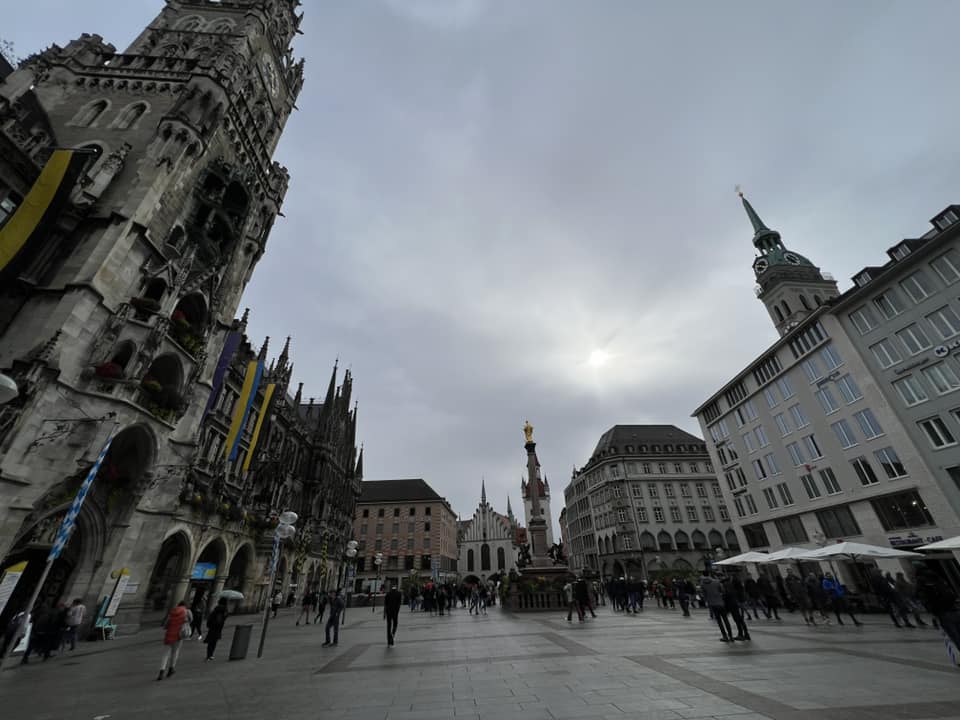
Types of transit in Munich
First things first, let’s address the different types of transit in Munich.
- S-Bahn: Eight lines that travel throughout the city and link Munich to the suburbs. This is what you’ll take from the airport and transferring to the city center is easy on the S-Bahn on lines S1 and S8. You can find S-Bahn stations by looking for a capital “S” on a green background.
- U-Bahn: This is their subway system which has about 100 stations in and around the city. This system is interconnected with the S-Bahn. Stations can be found with the capital “U” on a blue background.
- Bus: Buses also operate in Munich’s metropolitan area. Special night lines also operate and are marked with an “N” in front of the line number.
- Tram: The city has 13 lines that cover a network of over 80km. The tram system interconnects with all other transit options above, and special night lines also operate at night (again marked with an “N” in front of the line number).
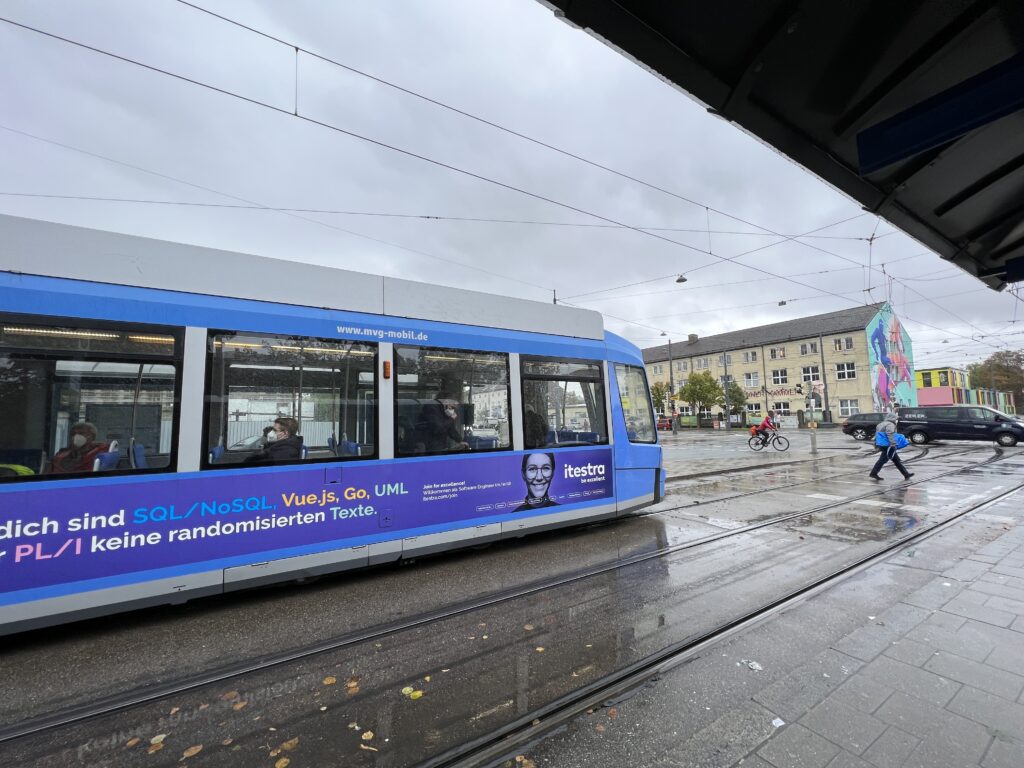
How to buy tickets
Tickets for Munich public transport companies MVV and MVG are valid for all means of transport in their public transport system (listed above). For example, if you buy a ticket for the U-Bahn, and need to transfer to the bus on your journey, you don’t need another ticket. Tickets can be purchased at ticket machines that are at all U-Bahn and S-Bahn stops, in buses and trams (often only accept coins on board), and at several bus and tram stations too. You can also buy them online (you must print a copy) and via the MVV or MVG apps. Note that children under six ride for free.
You’ll often find two kinds of ticket machines – electronic with touch screens that you can easily switch to your preferred language, and a vending machine style that makes it harder when you don’t know the language. The key thing is to remember that when you board transportation you need to validate your ticket.
Remember to validate the ticket before you board! Tickets you bought on board are said to be validated already, but double check what your ticket says just in case they’re not, OR just validate it as the validation machine on board if you want to be extra careful.
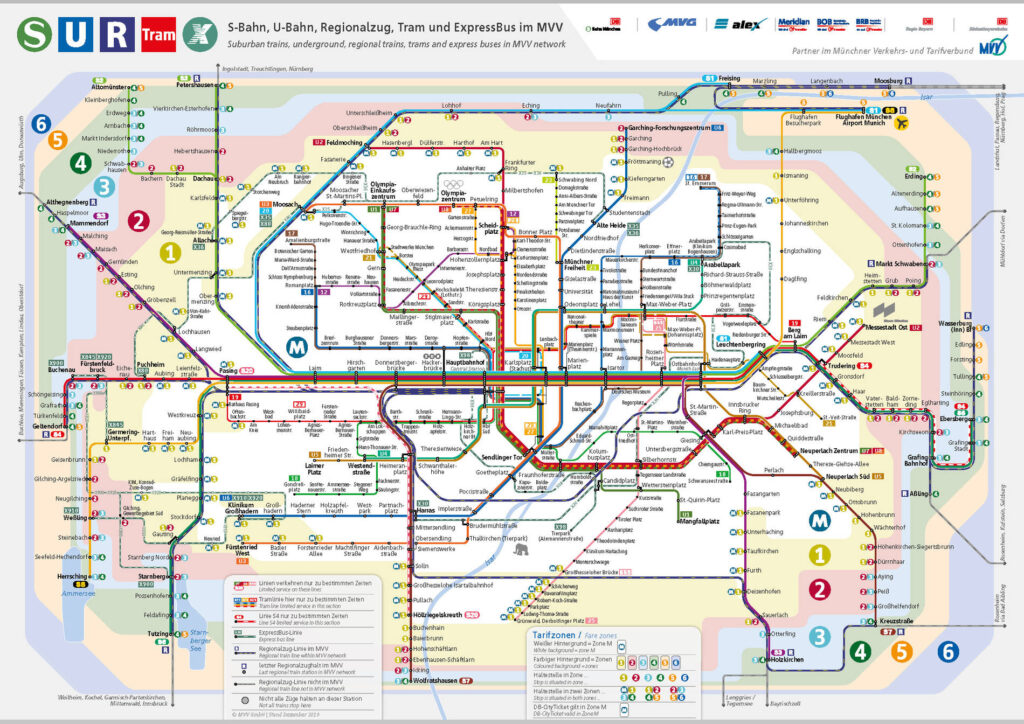
Types of tickets
There are several different types of tickets and you’ll want to ensure you get the right one.
Single Trips
A single ticket is for a single trip in the direction of the destination. You are allowed to change or interrupt (to other trains, buses, or trams) your trip but this is not a round-trip ticket. The cost is associated with how many zones you are traveling. You can find the zones in the above map. They are the coloured borders labeled 1-6. The main city center is zone M, but if you’re traveling to the airport or outside of the centre you’ll need to make sure you select the appropriate zone (the airport is in zone 5).
Stripe tickets are a bit more confusing but essentially they are tickets that can be used multiple times, by multiple people and have ten stripes each. The number of stripes used per trip depends on where you’re going and you validate it each time you use it. We didn’t bother with this ticket type while we were there and primarily stuck with day tickets or the single trip tickets mentioned above depending on how much we were using transit that day.
Day Tickets
If you plan to use transit all day, this is probably the best bang for your buck. There are a few options you can choose from:
- Single Day Ticket : Can be used within the selected area/zone of validity for as many trips as you like in one day
- Group Day Ticket : can be used in the selected area for as many trips as you like on one day for up to five adults (kids 6-14 count as an adult)
- Children’s Day Ticket : Valid for one kid (6-14 years) and you can take as many trips as you like within the whole network
- Airport-City-Day-Ticket: Includes the journey to/from the airport and the city area of Munich (zone M-5). You can get this ticket option as a single or group ticket and is great if you are traveling to or from the airport on the day you also plan to tour around
- CityTourCard: This is a tourist card that acts as both a day ticket within a selected area also offers discounts to more than 80 tourist attractions in Munich
- München Card: Contains a day ticket for public transport within a selected area of the MVV network and discounts of up to 70% of key sights, attractions, shopping, etc.
Tip: Single Trip Tickets, Stripe Tickets & Day Tickets must be validated prior to the start of your journey
We found the Group Day Ticket to be the best for my partner and me. It was the most cost-efficient.
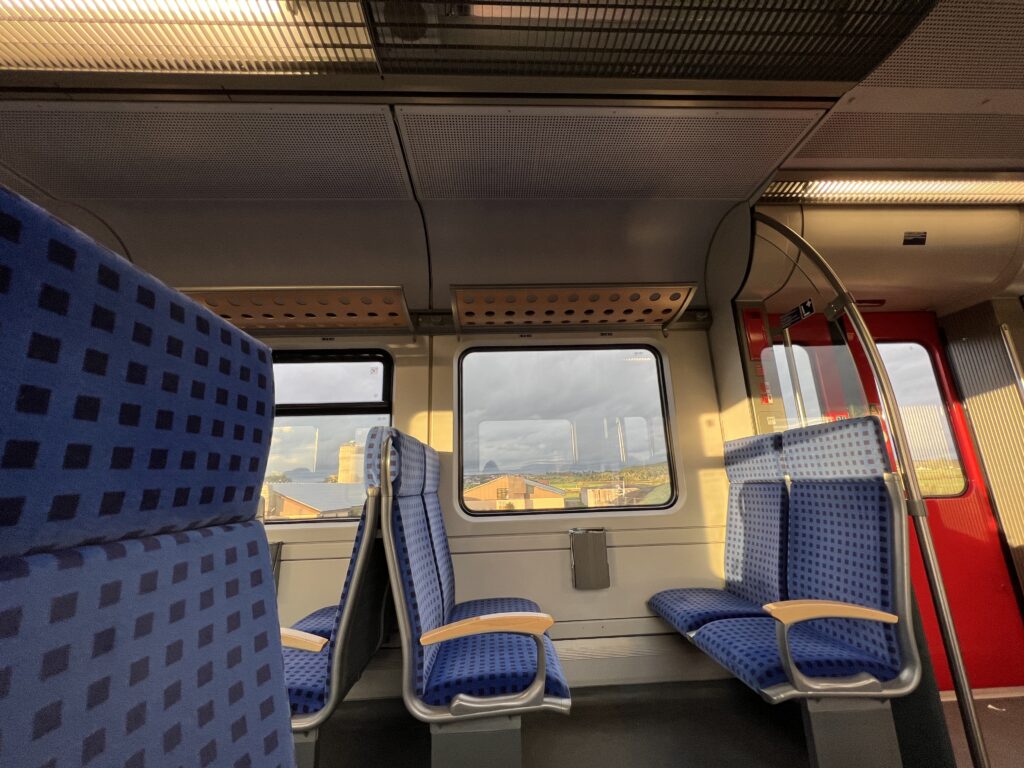
Things to note
- Times of Operation: The U-Bahn doesn’t run frequently during the really early morning hours so you may need to opt for the night lines on the bus or tram
- Navigating: I always download the offline Google Maps of the city I’m in so I can easily switch my directions to “transit” and know what stop I need to get on and off at
- Day Trips: If you plan to go on day trips from Munich, you should look into the Bayern Pass as it’s more cost-efficient and is valid for local transit trains and regional trains
- Use the Apps: It can be less confusing and more confusing to use the systems apps for tracking your route and buying your tickets, however, we found it easy to use the machines at the stops
- Maximum Travel Times: There are max travel times on your ticket depending on how many zones you are traveling aka you have X amount of time to get to your destination. Here is the general rule of thumb: Short Trip Ticket: 1 hour, 1 zone: 3 hours, 2 zones and Single Ticket for children/children (6-14 years): 4 hours
- IsarCard: If you are traveling for more than a week, look into getting an IsarCard as it’s not economically friendly
- Airport: The trip from the airport on either S1 or S8 takes about 35-minutes
I hope you found this guide helpful for navigating the beautiful and historical city of Munich, and if it seems overwhelming, it’s really very easy to figure out once you’re there. We even navigated our way home while drunk from Oktoberfest without any issues!
Other content to read:
- Guide to Munich’s Oktoberfest
- Day Trip to Rothenburg from Munich
- Day Trip to Dachau from Munich
You Might Also Like
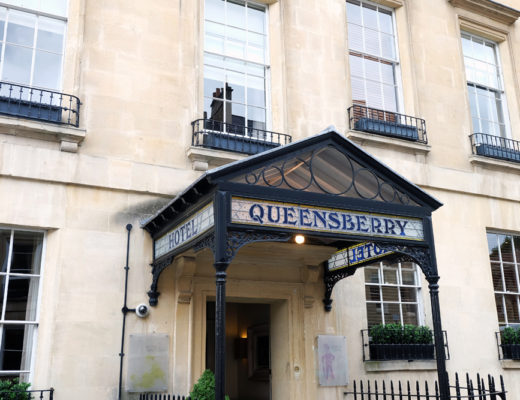
3 Hotels I Probably Won’t Get the Chance to Stay in Again
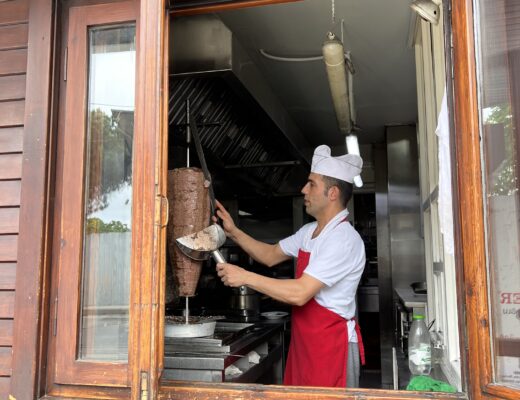
Must-Try Foods in Turkey
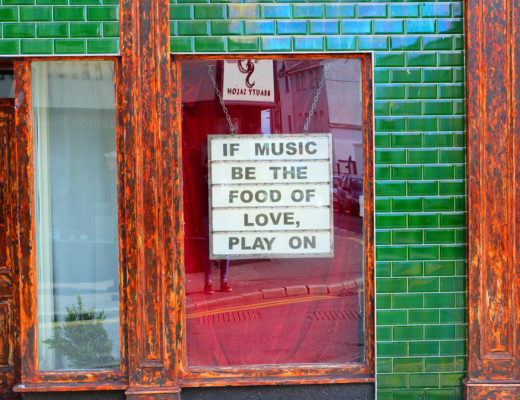
Things to Do in Galway, Ireland
No comments, leave a reply cancel reply.

Explore Munich by U-Bahn, bus, car or bike
Getting around in Munich: Ways of transportation
You can explore Munich via different ways. Asides using your car or your bike, the state capital has an excellently-developed public transport network
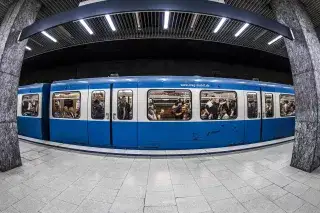
More actions
- Share on Facebook
- Share via WhatsApp
U-Bahn (underground): Stops at all the important places
The U-Bahn (underground train) in Munich stops at almost all the important places in the metropolitan area. Its stations can be recognized by their blue 'U' signs. The trains mostly travel underground, but sometimes aboveground and is not inhibited by traffic - unlike the tram or the bus. In order to use the U-Bahn, you need a valid ticket and you need to know where to get on or off. It's best to refer to the schedule to help work this out - it also tells you the ticket price of your journey. Important : No U-Bahn trains run from 1-4 am (Monday to Friday) and from 2-4 am (Saturday and Sunday).
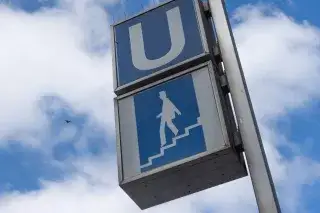
Straßenbahn (tram): Streetcars in Munich
You will spend more time traveling by tram than by U-Bahn (underground train), as the tram stops more frequently. Trams also run through many areas with no subway connection. The tram is unique at night. If the tram line has an 'N' (for example, 'N16' instead of '16'), it means it is a night tram and runs even when the U-Bahn is closed. Since the streetcar runs above ground, the lines in the city center are also suitable for sightseeing.
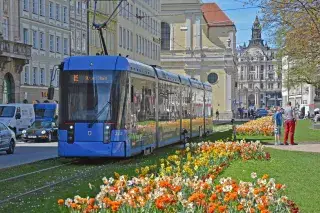
S-Bahn (aboveground city railway): 8 Lines for quick traveling
In contrast to the U-Bahn, tram and bus, the S-Bahn is not run by the MVG (Munich Transport Company), but instead by Deutsche Bahn AG. But other than the red color, nothing else is different for passengers. With a valid ticket, you can use the S-Bahn without any restrictions. The eight S-Bahn (aboveground city railway) lines travel to hotspots like the Hauptbahnhof, Karlsplatz (Stachus), Marienplatz and Ostbahnhof as well as to places outside of the city like Freising in the north or to the lake district in the south. The S1 and S8 lines go to Munich Airport.
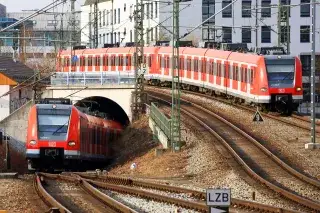
Bus: Reach every destination in the city
The buses are split into three categories: Metrobuses - with two-digit route numbers and connects the large transport hubs in different parts of the city; City buses - with three-digit route numbers and only runs within a single area of the city and connect to areas without much bus connections; Haidhausen, Giesing and Sendling are served by the Expressbus (Route X30). All of the buses that MVG (Munich Transport Company) has put into operation in recent years are adapted to the needs of the disabled and have particularly low-pollutant engines with soot filters.
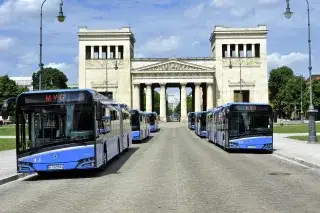
Car: Tips for driving in Munich
The Mittlere Ring (Munich ring road) is the city’s main traffic artery. If you are trying to drive in rush-hour traffic, you may need to be patient. Cars often only inch forward bumper to bumper. The environmental zone is located within the Mittlere Ring. Only cars with green emissions stickers are allowed to drive there. If you would like to park your car in the city, it is best to drive to one of the 24 car parks or the various parking zones in the boroughs. If you are driving from outside the city limits with your car and then using public transport, then the Park+Ride spaces are a good alternative.
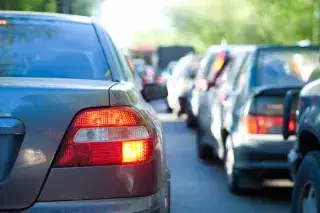
Taxi: What you need to know about cabs
With approximately 2.5 taxis per 1,000 inhabitants, Munich has the highest density of taxis in Germany. So you can conveniently get into a taxi at any corner – either by waving from the roadside, at one of the numerous taxi stands or by phoning one of the Munich taxi companies. However, travelling by taxi is not exactly a bargain in the state capital.
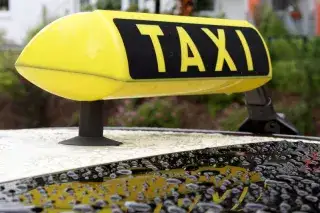
Bicycle: The easiest way of getting around
Cycling is healthy, fun and is often the easiest way of getting around Munich. The cycle paths are continuously being extended. The distances between point A and B are usually not much. If you want more detailed information, the bicycle route planner allows you to find various routes to your destination. If you haven't got the right means of transport, there are plenty of options to hire a bike.
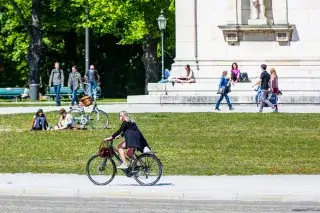
By foot: Start at Marienplatz
f you want to explore the city on foot, you can reach the most important points in the city centre within a short time. For many, Marienplatz is the central starting point. From there, it is only a few hundred metres to the city’s landmark, the Frauenkirche cathedral. Heading further west, the pedestrian area leads through to Karlsplatz , which is called ‘Stachus’ by the locals. You can truly feel the pulse of the city around the traditionally popular Stachus fountain.
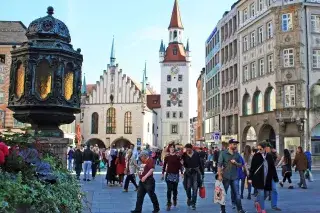
Visitors with disabilities
Munich warmly welcomes tourists with disabilities . For deaf people, there is a special tour guide that includes different routes. This lets you experience the charms of Munich with a tour of Marienplatz, the Alter Hof and past the State Opera. There are accessible toilets in the centre, and in the city centre many of the traffic lights have additional features for blind people. If you have a valid stamp in your disabled person’s pass, then you can use the MVV (Munich's association of public transport authorities) for free.
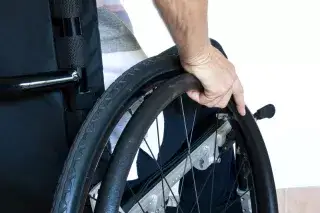
Nomadic Matt's Travel Site
Travel Better, Cheaper, Longer
Munich Travel Guide
Last Updated: August 31, 2023
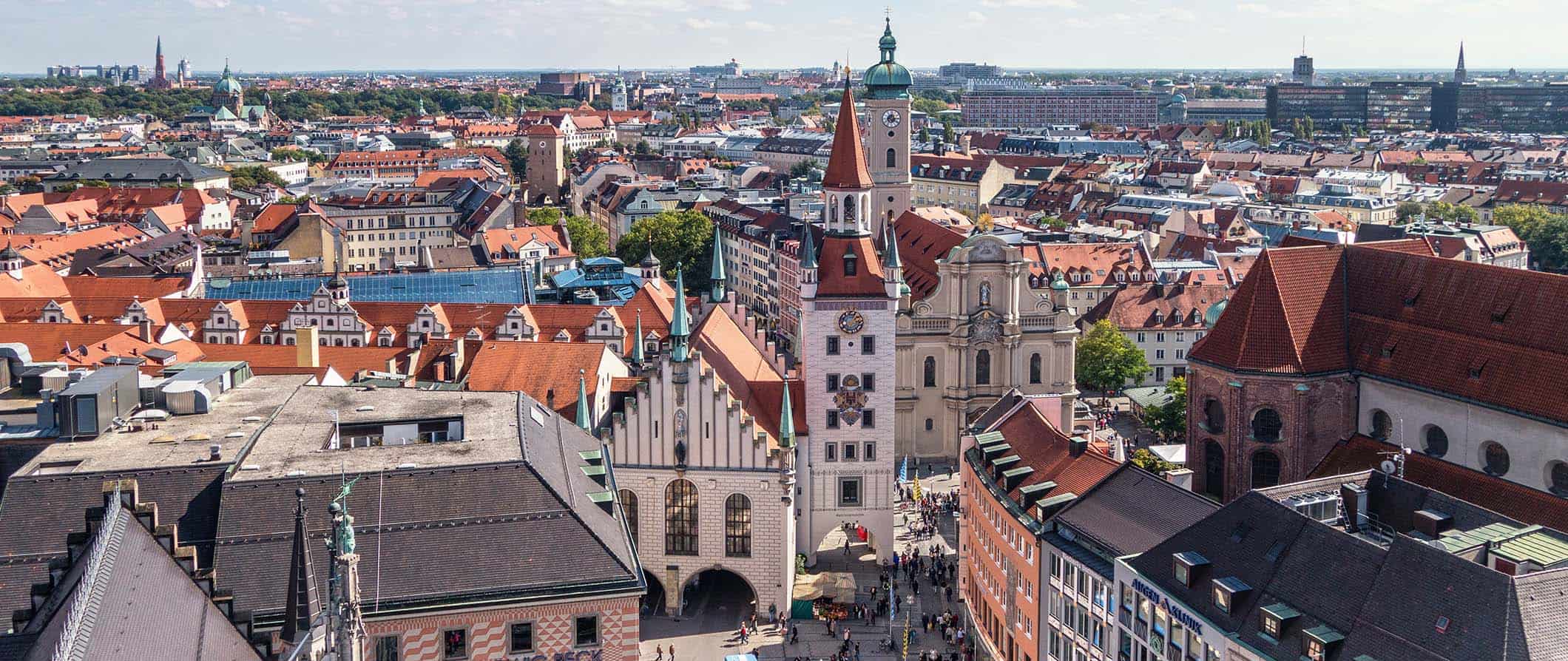
Munich, the largest city in southern Germany and the capital of Bavaria, is famous for its annual beer festival, Oktoberfest. But there’s a lot more to visiting Munich than drinking steins of beer.
The city is host to a beautiful historic city center, an old castle, large parks and gardens, hearty German food, and beer halls galore. There is also Munich’s famous clock, a detailed history museum, and the famous English Garden. In short, the city has something for everyone.
While settlements in the area date back to the Bronze Age, Munich as we know it today traces its roots back to 1158. Over the centuries, the city grew into an important cultural and economic hub. After World War I, it was here where the Nazi party took root (their first concentration camp was nearby in Dachau). The city was heavily bombed during the war, though it was completely rebuilt in the post-war era following the same grid pattern.
Today, Munich is a place of beauty, art, and history. I love traveling there. The city has a lot to offer travelers and is also an incredible base for visiting other places in Bavaria. It may lack the youthful edge of Berlin but, to me, that’s a benefit!
This travel guide to Munich can help you plan your trip, get off the beaten path, and help you make the most of your visit!
Table of Contents
- Things to See and Do
- Typical Costs
- Suggested Budget
- Money-Saving Tips
- Where to Stay
- How to Get Around
- How to Stay Safe
- Best Places to Book Your Trip
- Related Blogs on Munich
Top 5 Things to See and Do in Munich
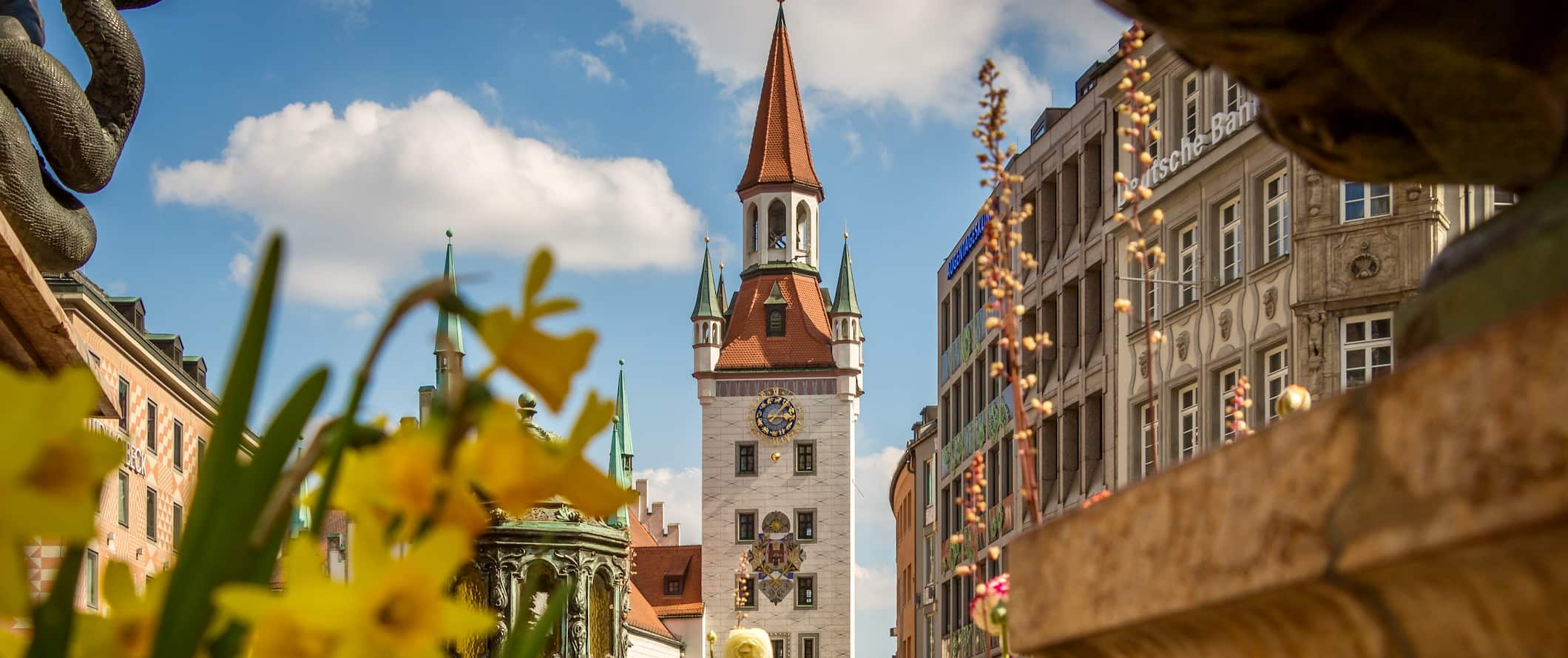
1. See Alte Pinakothek
This important art museum is home to over 800 works from 14th-18th century German masters. It features one of the world’s largest exhibits of Rubens’ paintings as well as works by Titian, Frans Hals, Altdorfer, Albrecht Dürer, and others. Admission is 7 EUR (1 EUR on Sundays).
2. Stroll the English Garden
With nearly 80 kilometers (50 miles) of trails, the English Garden is a massive park that offers numerous places to picnic, hike, and relax. Near the entrance is a river where people can “surf” as the water flows out under the bridge. There’s also a great beer garden in the center too with a Chinese tower (a wooden building resembling a pagoda).
3. Experience Oktoberfest
Oktoberfest is a two-week-long drinking festival that occurs at the end of September. Every year, an estimated 6 million people descend on the city to spend the time dressed in Bavarian clothes, drink huge liter-sized beers called Maß, and eat roasted chicken and massive pretzels. It’s a huge, huge party. Here’s an example .
4. Tour the Dachau Concentration Camp
Dachau was the site of Germany’s first Nazi concentration camp, opening in 1933. You can come and bear witness to this tragic episode in human history. There are over 30,000 documented deaths in the camp, though the number is likely much, much higher. It is a very sad place to visit but one that everyone should see. It’s located 16 kilometers (10 miles) outside the city and takes a full day to see. Entry is free.
5. Visit the Nymphenburg Palace
This Baroque palace was the summer residence of Bavaria’s royalty. It features a lavishly decorated interior, a breathtaking banquet hall, and is surrounded by extensive gardens. Two of its most famous features include the “Gallery of Beauties” and the former bedroom of King Ludwig II (1845-1886). It’s a nice place to wander around enormous gardens and the locals often picnic here.
Other Things to See and Do in Munich
1. visit the church of st peter.
Munich’s oldest parish church features art dating back six centuries, including ceiling frescoes and a giant gilded altar. You can also climb the 299 steps for lovely views of the city from the tower. On a clear day, you can see all the way to the Alps. Admission is 5 EUR.
2. Tour the BMW Museum & BMW Welt Munich
The BMW Museum is housed next to BMW’s head office in northern Munich. The company was founded in 1916 and the museum features exhibits about the history of BMW cars and motorcycles, with historic vehicles and prototypes, plus displays on alternative fuel and traffic management. It’s a bit out of the city but if you’re a car lover, I highly recommend a visit. Admission is 10 EUR.
3. Hang out at the Hofbräuhaus
The world’s most famous beer hall is one of Munich’s top attractions and a visit here is a must if you love beer. The Hofbräuhaus was built in 1607 and was originally used as a brewery, with the restaurant portion opening in 1828. Beer was produced here until 1896, at which point, the brewery outgrew its original home and beer production moved to a new, bigger site in the suburbs. While much of the beer hall was damaged or destroyed during World War II, reconstruction in 1958 restored the building in its original style. More than 100 active groups of regulars visit Hofbräuhaus, and the oldest regulars have held their table for 70 years. It’s the most popular beer hall during Octoberfest too and regularly hosts year-round events and live music.
4. Shop at the Viktualienmarkt
This food market in the middle of the city has been operating for over 200 years. With over 100 vendors, this popular local shopping spot is a great choice of fresh fruit and vegetables, cheese, and antipasti. It’s not very expensive either so stock up here if you are cooking for yourself. The market is open Monday-Saturday from 8am-8pm, though some stalls close earlier than the official closing time. Some stands are also closed on Mondays.
5. Visit the Deutsches Museum
One of the largest technical museums in the world, this museum is host to a huge array of exhibits focused on science and technology. For anyone interested in construction, engineering, aerospace, and the natural sciences, this is a great attraction. There are sailing ships, windmills, space probes, robots, lifeboats, submarines, interactive exhibits, and more! It’s a great place to visit if you’re traveling with kids. Admission is 15 EUR.
6. Partake in Maibaumaufstellung
The first of May is a public holiday in Germany, and every year, maypoles are erected all over the country amidst many festivities. May Day is especially important in Bavaria, with many traditions particular to the region. Small villages go head-to-head, attempting to steal the maypole of rival villages. If one is stolen, it must be “purchased” back with beer and food. Another Bavarian tradition involves a competition in which climbers try to scramble up a Maypole that’s been slicked down with soap. Whoever reaches the top gets the prize of pretzels and sausages hanging there. As the capital of Bavaria, Munich always has an interesting array of activities on this day, including plenty of music and dancing. A giant maypole depicting Munich’s traditions and culture is erected in Viktualienmarkt each year as well.
7. Shop at Kaufingerstrasse
This pedestrian-exclusive shopping area stretches for several blocks between Marienplatz and Karlsplatz. There is a mix of independent boutiques and large-scale department stores to peruse, as well as a slew of restaurants, bars, cafes, and beer gardens to enjoy. Wander down the side alleys for some interesting specialty shops and great people-watching.
8. Bayerische Staatsoper
This is one of the best opera companies in the world and as such, is considered one of the top attractions not just in Munich but all of Bavaria. The company was formed in the 1650s and performs today in the Neoclassical Munich National Theatre. The pieces put on here are primarily composed by Mozart, Wagner, and Strauss. Prices vary depending on the show, dates, and seats, with tickets ranging from 10-200 EUR.
If you want to save money and you don’t mind being less comfortable, you can purchase standing tickets in the upper levels for a hugely discounted price. There are often breaks so if you’d like to get the opera experience without blowing your budget try this option. Be sure to dress up as you’ll see everyone in Munich has put on their best clothes for the opera house.
9. Attend a “Blade Night”
Since 1999, every Monday from May to September is “Blade Night Munich,” which is basically code for a giant street party on rollerblades/roller skates. While these nights started informally, now they’re highly organized events with thousands of participants at each one. Over the course of 1.5-2 hours, the massive group skates together along various pre-determined routes ranging from 12-24 kilometers (7.5-14 miles). There are even “bladeguards” who help any skaters that need assistance. The routes vary each time to keep things interesting too. You can usually rent skate and protective gear for a few euros.
10. Visit Munich Residenz
From 1508 to 1918, the Munich Residenz was the seat of government and residence of the Bavarian dukes, electors, and kings. What started out as a 14th-century castle for the Wittelsbach monarchs has since been converted into a museum. The complex, like much of Munich, was significantly damaged in World War II but was restored in the 1980s. It is the largest city palace in Germany, with ten courtyards and 130 rooms, all offering something different to see. You can visit the opulent royal apartments, serene court chapel and gardens, grand halls, and gilded staterooms, as well as see the art collections from the Renaissance, Baroque, Rococo, and Neoclassic periods. Make sure you see the Italian Renaissance Grotto Courtyard and the Baroque Ancestral Gallery. Tickets for the Residence Museum and Treasury are 9 EUR each.
11. See the Glockenspiel
Munich’s town hall (the Neues Rathaus) in Marienplatz was completed in 1874 and is now the focal point of the city. Its main attraction is the Glockenspiel (a clock), which chimes each day at 11am, 12pm, and 5pm. 32 life-sized figurines tell 16th-century stories about Munich’s history, twirling around in a fun show each time the clock chimes (like a giant cuckoo clock). Shows last around 12-15 minutes depending on the story. The clock contains 43 bells and is solar-powered.
12. See the Asam Church
The Asam Church, built between 1733-1746, is named for its 18th-century designers, the Asam brothers (one was a sculptor and the other a painter). Its Late Baroque interior is extravagant and considered to be one of the best examples of this period. The stuccowork along the church’s naive as well as the colorful frescoes make for some fantastic photography. The church is quite small but the brothers made use of every inch of the interior, covering the confined space in allegorical statues and paintings. The exterior is magnificent as well, with a huge wooden door, multi-story windows, intricately carved reliefs, and golden, star-shaped ornaments. The brothers originally intended to keep the church for their own personal use, but heavy pushback forced them to open it to the public and it was inaugurated in 1746. Admission is free.
13. Bavarian National Museum
The Bavarian National Museum is one of the largest art museums in Germany and one of the most important decorative arts museums in all of Europe. Inaugurated by King Maximilian II in 1855, much of the collection comes from the Wittelsbach family, who ruled Bavaria for centuries. The 40+ rooms showcase items dating from Late Antiquity through the Art Nouveau period, including weapons, armor, porcelain, oil paintings, musical instruments, and more. Their Bollert Collection has an impressive collection of Late Gothic and Renaissance sculpture and the folklore department on the lowest floor hosts a collection of Alpine nativity scenes from the 18th-20th centuries. Admission is 7 EUR and 10 EUR for special exhibitions.
14. Take a Bavarian food tour
Munich Walk Tours offers several specialized tours of the city, with their Bavarian Food and Market Tour being the most delicious. Over the course of 2.5 hours, guides lead you through the historic district, making seven stops to sample and share the history behind Bavarian delicacies. The food you’ll get depends on the season but might include homemade sausages, cheese, pastries, fresh bread with spreads, and pretzels. Tickets are 35 EUR and include the food.
15. Day trip to Neuschwanstein Castle
This 19th-century Neo-Romantic palace is a must on any Germany travel itinerary. It was the model for the Disney castle and is one of the most popular tourist attractions in Europe, with over 1.5 million visitors each year. Perched on a rugged hill in Bavaria near the town of Füssen, the palace was commissioned by “crazy” Ludwig II of Bavaria as a retreat and homage to Richard Wagner. Visitors can walk around outside and admire the stunning exterior for free, but the interior is only accessible by guided tour at specific times, which must be booked in advance. While the palace is 6,000 square meters (65,000 square feet) in size, only 14 of those rooms were ever finished. Interestingly, the majestic rooms were fitted with very modern technology for the time, including central heating, hot and cold running water, automatic flush toilets, and telephones. Admission is 17.50 EUR.
16. Day trip to Zugspitze
Many people don’t realize that just outside of Munich, Bavaria offers stunning mountains and glacial lakes, including Germany’s highest peak, Zugspitze. You can reach this incredible 2,962-meter-tall plateau by taking public transport to Garmisch-Parkinkirchen and getting the Zugspitzbahn train. This incredible scenic journey takes you via Grainau to reach Eibsee, a stunning turquoise Alpine lake. From here the cable car takes you up to the summit for a breathtaking 360° panoramic view at the Panorama 2962 restaurant. Tickets are 63 EUR return and are only available in summer.
17. Day trip to Tegernsee
An hour’s train ride outside of Munich lies the beautiful postcard-worthy Bavarian lakeside village of Tegernsee. The traditional Bavarian homes have colorful flowers cascading from the balconies and the lake itself is surrounded by lush mountains. Anywhere you sit you will have beautiful views of the water. If you’re a beer lover, try one of the local Tegernsee beers at the Herzogliches Schloss Tegernsee brewhouse.
18. Experience the Winter or Summer Tollwood Festival
The Tollwood Festival takes place twice a year during the December Christmas market season at Theresienwiese (where Oktoberfest is held) and in the summer at Munich’s Olympiapark. Unlike Oktoberfest and other local festivals that honor Bavarian tradition, this modern festival is a unique artistic mix of food from all over the world, live music, handmade eclectic crafts, and activities. The Christmas Tollwood is a giant Christmas market with both outdoor places to grab a glühwein (mulled wine) and tasty snacks as well as huge tents inside where you can warm yourself and admire the changing art themes and decorations every year. The summer Tollwood (held in June/July) has live bands and activities where you can enjoy the summer sun sitting outside enjoying Bavaria’s best beer.
19. Hang out like a local by the river Isar
Munich is not known for its cheap bars, so if you want to do what the locals do, pick up some food and beers at the Reichenbachbrücke Kiosk and enjoy the view down by the Isar river. There aren’t any tables or chairs, so bring something to sit on and people-watch at one of Munich’s most popular hangouts.
20. Day trip to Regensburg
Located about 1.5 hours away from Munich, Regensburg is a UNESCO-listed medieval town that’s recently become increasingly popular as a tourist destination. Major sites include St. Peter’s Cathedral, a Gothic cathedral with a treasury featuring relics and reliquaries; the 13th-century stone bridge which was once the only way to cross the Danube in this area; and Porta Praetoria, a Roman gate dating from 179 CE. Train tickets from Munich are 19-26 EUR one way.
For more information on other cities in Germany, check out these guides:
- Berlin Travel Guide
- Cologne Travel Guide
- Frankfurt Travel Guide
Munich Travel Costs
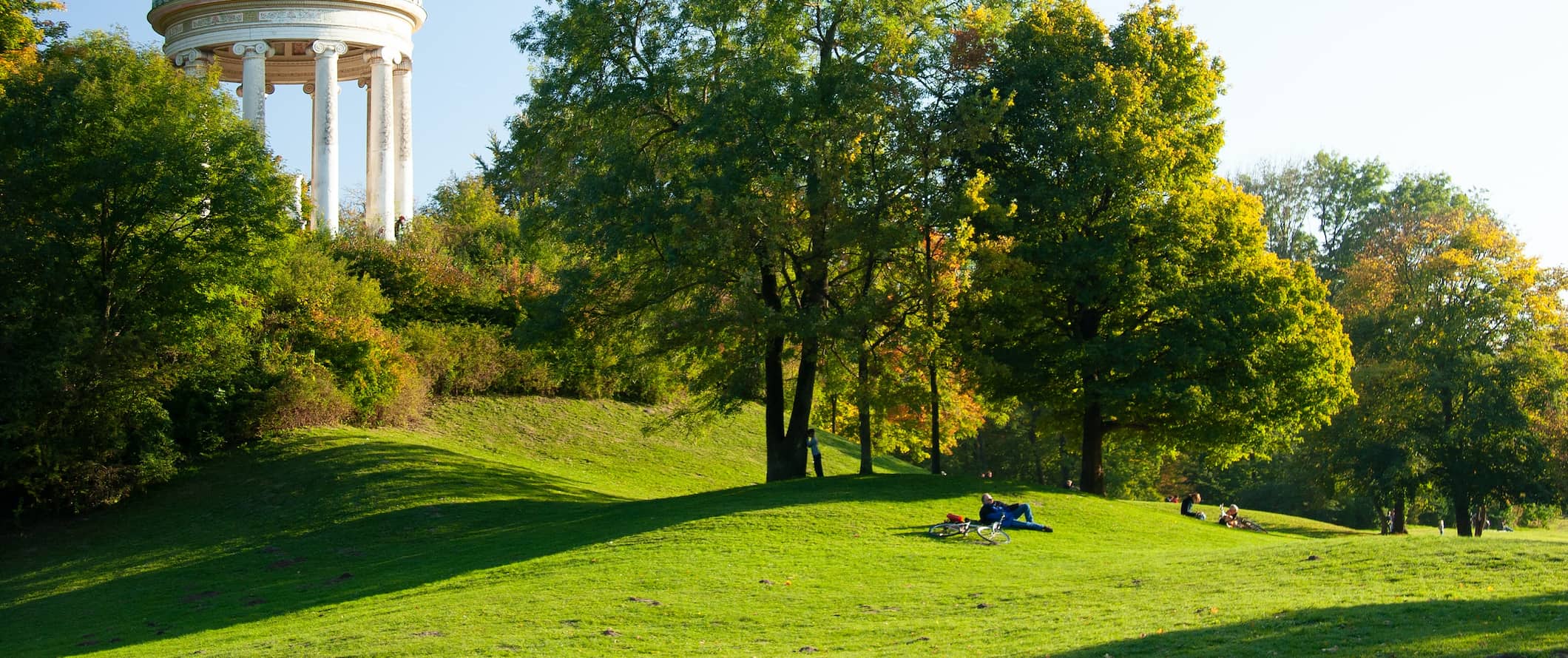
Hostel prices – A bed in a 4-6-bed dorm costs 35-43 EUR per night, while a bed in an 8-12-bed dorm costs 18-22 EUR per night. You can usually find cheaper prices during the winter. Private double rooms cost 70-100 EUR. Free Wi-Fi is standard, and a few hostels also include free breakfast. Self-catering facilities are not too common in the city’s hostels, so if you need a kitchen for your stay be sure to double-check before you book.
Be aware that prices double or triple during Oktoberfest, so book several months ahead if you’re planning on visiting during this time.
The cheapest option during Oktoberfest is The Tent, which is basically one huge communal accommodation with cots but during Oktoberfest cheapest is usually around 50 EUR a person. If you can’t find anything cheap in Munich during that time, consider staying in one of the neighboring cities that are around one hour away, such as Nuremberg, Regensburg, Garmisch, Mittenwald, or Tegernsee. The last trains back to these towns are around 11pm-12am depending on location.
(Be sure to check this before heading into town for Oktoberfest so you don’t end up hanging out at the station until the first trains start around 5am.)
For those traveling with a tent, there are a handful of campgrounds outside the city. They offer basic facilities and prices range from 5-10 EUR per night for a basic plot for two without electricity.
Budget hotel prices – Budget hotels cost around 50-75 EUR per night for a double or twin room. Wi-Fi is generally included, and in many cases, free breakfast as well. If you plan on booking a hotel for Oktoberfest, book well in advance (as in several months ahead) as hotels sell out fast.
There are a lot of Airbnb listings in Munich (though they are more expensive than in other parts of Germany), with private rooms starting at 40 EUR per night. Entire homes/apartments begin at around 85 EUR per night. Prices double when not booked in advance, however, so book early no matter when you visit.
Food – Food in Germany is very cheap (and hearty). Meat is a staple of most meals, especially sausages; there are over 1,500 different kinds of sausages in Germany (sausages here are known as “wurst”). Stews are also a popular traditional choice, as are potato dumplings and sauerkraut. Breakfast is usually composed of bread, cold cuts, cheese, and boiled eggs or Bavaria’s favorite weisswurst and soft pretzels.
Munich is not the cheapest city when it comes to food, but it doesn’t have to break the bank if you’re smart about it. There’s a good variety of street food, from snack bars to food trucks, offering hot dogs, sausages, falafel, and kebab for around 3-6 EUR. A pastry is around 1-2 EUR, which can make a good cheap grab-and-go breakfast.
McDonald’s and other fast-food places cost around 8-10 EUR for a combo meal. Local fast-casual spots offer burgers for around 6-10 EUR and sandwiches for 4-7 EUR.
International eateries, like the many Turkish, Thai, or Vietnamese restaurants, offer affordable fare, with main dishes costing 6-9 EUR.
For German sit-down restaurants, you can generally eat for under 16-18 EUR (the beer halls provide the best value). A homemade sausage dish is around 10-12 while a larger dish such as wiener schnitzel or spätzle (German noodles) is 15-17 EUR. Traditional soups are 5-7 EUR while a huge Bavarian pretzel is 3-5 EUR. I really enjoy eating at the beer hall Augustiner Bräustuben.
For drinks, a pint of beer starts at 4 EUR, a glass of wine is around 4.50 EUR, and a soft drink is 3 EUR. A cappuccino is generally around 3.40 EUR.
Many restaurants also have a “Mittagsmenü” (special prices for lunch on a working day), where you usually pay about 7-12 EUR, choosing from select dishes. This is a great deal and usually quite hearty.
For higher-end dining, a three-course menu starts at 65 EUR per person and goes up from there.
If you plan on cooking for yourself, a week’s worth of groceries including basic items like pasta, rice, seasonal produce, and some meat costs between 50-55 EUR. To save money, go to grocery store chains like Aldi, Lidl, Netto, and Penny.
Munich Suggested Budgets
On a backpacker budget, expect to pay around 65 EUR per day. This covers staying in a hostel dorm, cooking all of your meals, using public transportation to get around, limiting your drinking, and sticking to free activities like free walking tours and enjoying the parks.
For a mid-range budget of 130 EUR per day, you can stay in a private Airbnb, eat out for most meals at cheap restaurants and food stalls, enjoy a few drinks, take the occasional taxi to get around, and do more paid activities such as museum visits or a day trip.
On a “luxury” budget of 235 EUR or more per day, you can stay in a hotel, drink as much as you want, rent a car for day trips, eat out for all your meals, and do whatever tours and activities you want. This is just the ground floor for luxury though. The sky is the limit!
You can use the chart below to get some idea of how much you need to budget daily, depending on your travel style. Keep in mind these are daily averages — some days you’ll spend more, some days you’ll spend less (you might spend less every day). We just want to give you a general idea of how to make your budget. Prices are in EUR.
Munich Travel Guide: Money-Saving Tips
There are plenty of ways to save money in Munich, especially if you skip some of the fancier hotels and more luxurious meals the city has to offer. Here are my tips on saving money in Munich:
- Visit museums on cheap and free days – On Sundays, many museums in Munich offer 1 EUR admission, including the Bavarian Museum, Alte Pinakothek, Pinakothek der Moderne, Museum Brandhorst, and Sammlung Schack, among others. The Haus der Kunst offers free admissions on the first Thursday of the month and the Villa Stuck offers free admission on the first Friday evening of the month. Visit Munich’s tourism website for a full list of museum offers.
- Get a Munich City Card or Pass If you don’t want to worry about visiting museums on specific days, get a Munich City Card or Pass. Both offer free unlimited rides on all forms of public transport, while the Card offers discounts on museums and the Pass offers free admission to all the main attractions. The Card starts at 13.90 for a 1-day pass, while the Pass is 47.90 for a 1-day pass.
- Eat cheap – The quick sausage stands and shawarma places offer a chance to eat for only 3-5 EUR. Food near the central train station is also inexpensive and quick.
- See a cheap movie – On Tuesday, it’s “Cinema-Day” and movie tickets are cheaper (the big cinema at Stachus only is only 7-10 EUR). Munich Opera and ballet tickets for people under 30 years old are only 10 EUR with proof of ID and go on sale at the end of each month for the next month if you can plan ahead.
- Cook your own meals – Eating at restaurants for every meal can really destroy your budget very quickly in Munich. Try and cook some of your meals to save yourself some cash. It’s not fancy, but it’s affordable!
- Avoid bars and beer gardens Beer gardens are fun but expensive. To save money, buy your drinks at the supermarkets and kiosks in Munich and sit outside if the weather is nice. Sit outside like the locals do and have a picnic. Head to English Garden, Isar River by Isartor, Frauenhoferstrasse, and Thalkirchen (by the Zoo).
- Embrace free walking tours – Free walking tours are a great way to explore the city on a budget while learning about its history and culture. Sandeman’s New Europe Munich tour is a good one to start with. Best of all, they are free! Just be sure to tip your guide at the end.
- Stay with a local – The best way to save money on accommodation is to stay with a local via Couchsurfing. Not only will you save a few bucks but you’ll get insider access to the city itself. This is the best way to discover all the hidden gems Munich has to offer!
- Bring a water bottle – The tap water here is safe to drink as it comes from the foothills of the Bavarian Alps, so bring a reusable water bottle to save money and reduce your plastic use. LifeStraw is my go-to brand as their bottles have built-in filters to ensure your water is always clean and safe.
Where to Stay in Munich
Munich has plenty of fun and affordable hostels. Here are my suggested places to stay:
- Euro Youth Hostel
- Jaeger’s Munich
- The 4You Hostel Munich
How to Get Around Munich

Public transportation – Public transportation in Munich is fast, reliable, and safe. One ticket can be used on all the public transportation options: the U-Bahn (underground), S-Bahn (above ground, also goes outside of the city), tram, and buses.
A one-way fare is 3.70 EUR, while a short-trip ticket (valid for 1 hour) is 1.90 EUR. A one-day unlimited pass is 8.80 EUR, which is by far the best deal. You can also get a week-long pass for 18.60 EUR. If you’re in town for 3-4 days, this deal is cheaper than buying day passes.
If you have to switch from the tram to the subway in one journey, you can do so with a single ticket. Just keep in mind that the fare increases the more zones you travel through.
Bicycle – Munich is incredibly bike-friendly. In fact, it’s considered the cycling capital of Germany. You can rent bicycles starting around 16 EUR per day.
If you want more than just a rental, check out Fat Tire Tours . They offer insightful and fun bike tours all around the city. They’re perfect if you want to see a lot of sights and chat with an expert local guide.
Taxi – Taxis aren’t cheap in Munich, with some of the highest tariffs in Germany. The base rate is 5.50 EUR plus an additional 2.30 EUR per kilometer. I’d skip them if you can!
Ridesharing – Uber is available here, but it’s not any cheaper than taxis. In short, stick to public transportation if you’re on a budget.
Car rental – Car rentals can be found for as little as 40 EUR per day for a multi-day rental. You won’t need one to get around the city, though it would be helpful to have one if you plan on exploring Bavaria and doing some day trips. Renters need to be at least 21 years of age.
When to Go to Munich
Munich has so much happening year-round that it’s always a good time to visit. Spring is nice because flea markets are opening and there are several festivals that take place during this time (such as Wannda, an arts festival). However, the weather can sometimes be cold and rainy. Pack some layers and rain gear.
Summer tends to be the most popular time to visit. Temperatures are hot and everyone’s outdoors enjoying the sunshine. People flock to beer gardens or to the nearby lakes for some swimming. This is also the peak season when accommodation prices are much higher. During this time, temperatures are usually around 24°C (75°F) or higher.
Thanks to the famous Oktoberfest, autumn is also a very popular time to visit. From the end of September to early October, millions of people flock here from all over the world to enjoy the most epic beer-drinking festival in the world. The weather during this time is usually just as pleasant as in summer. If you’re planning on attending Oktoberfest, book your accommodations in advance. Way, way in advance. If you want to avoid the chaos, come in early September or late October.
Winter in Munich can be cold, with temperatures as low as -5°C (23°F), but Germany is known for its Christmas spirit and the markets in Munich are no exception. The weather is more unpredictable, and you should prepare for snowfall, but there are plenty of places around the city for sledding and skiing. Accommodation prices are a lot cheaper during this time.
How to Stay Safe in Munich
Munich is a safe city and violent attacks against travelers here are incredibly rare. As in any major city, theft and pickpocketing can still occur so always keep your valuables secure and out of sight (especially in busy tourist areas, at markets, and on crowded public transportation).
Solo female travelers here should generally feel safe, though the standard precautions apply (don’t leave your drink unattended at the bar, never walk home alone intoxicated, etc.)
While scams here are rare, you can read about common travel scams to avoid if you’re concerned.
If you experience an emergency, dial 112 for assistance.
The most important piece of advice I can offer is to purchase good travel insurance. Travel insurance will protect you against illness, injury, theft, and cancellations. It’s comprehensive protection in case anything goes wrong. I never go on a trip without it as I’ve had to use it many times in the past.
Munich Travel Guide: The Best Booking Resources
These are my favorite companies to use when I travel. They consistently have the best deals, offer world-class customer service and great value, and overall, are better than their competitors. They are the companies I use the most and are always the starting point in my search for travel deals.
- Skyscanner – Skyscanner is my favorite flight search engine. They search small websites and budget airlines that larger search sites tend to miss. They are hands down the number one place to start.
- Hostelworld – This is the best hostel accommodation site out there with the largest inventory, best search interface, and widest availability.
- Booking.com – The best all around booking site that constantly provides the cheapest and lowest rates. They have the widest selection of budget accommodation. In all my tests, they’ve always had the cheapest rates out of all the booking websites.
- HostelPass – This new card gives you up to 20% off hostels throughout Europe. It’s a great way to save money. They’re constantly adding new hostels too. I’ve always wanted something like this and glad it finallt exists.
- Get Your Guide – Get Your Guide is a huge online marketplace for tours and excursions. They have tons of tour options available in cities all around the world, including everything from cooking classes, walking tours, street art lessons, and more!
- The Man in Seat 61 – This website is the ultimate guide to train travel anywhere in the world. They have the most comprehensive information on routes, times, prices, and train conditions. If you are planning a long train journey or some epic train trip, consult this site.
- Rome2Rio – This website allows you to see how to get from point A to point B the best and cheapest way possible. It will give you all the bus, train, plane, or boat routes that can get you there as well as how much they cost.
- FlixBus – Flixbus has routes between 20 European countries with prices starting as low 5 EUR! Their buses include WiFi, electrical outlets, a free checked bag.
- SafetyWing – Safety Wing offers convenient and affordable plans tailored to digital nomads and long-term travelers. They have cheap monthly plans, great customer service, and an easy-to-use claims process that makes it perfect for those on the road.
- LifeStraw – My go-to company for reusable water bottles with built-in filters so you can ensure your drinking water is always clean and safe.
- Unbound Merino – They make lightweight, durable, easy-to-clean travel clothing.
- Top Travel Credit Cards – Points are the best way to cut down travel expenses. Here’s my favorite point earning credit cards so you can get free travel!
- Fat Tire Tours – For bike tours, use this company! They have fun, interactive tours led by expert local guides. You’ll get to see all the main sights without breaking the bank!
- BlaBlaCar – BlaBlaCar is a ridesharing website that lets you share rides with vetted local drivers by pitching in for gas. You simply request a seat, they approve, and off you go! It’s a cheaper and more interesting way to travel than by bus or train!
Munich Travel Guide: Related Articles
Want more info? Check out all the articles I’ve written about travel in Europe to continue planning your trip:

The 6 Best Hotels in Copenhagen

The 6 Best Hotels in Florence

The 7 Best Hotels in Madrid

The 6 Best Hotels in Vienna

The Best Walking Tours in Barcelona

How to Be a Digital Nomad in Europe
Get my best stuff sent straight to you, pin it on pinterest.
- Where To Stay
- Transportation
- Booking Resources
- Related Blogs
The ultimate guide to getting around Munich

Jul 7, 2023 • 6 min read
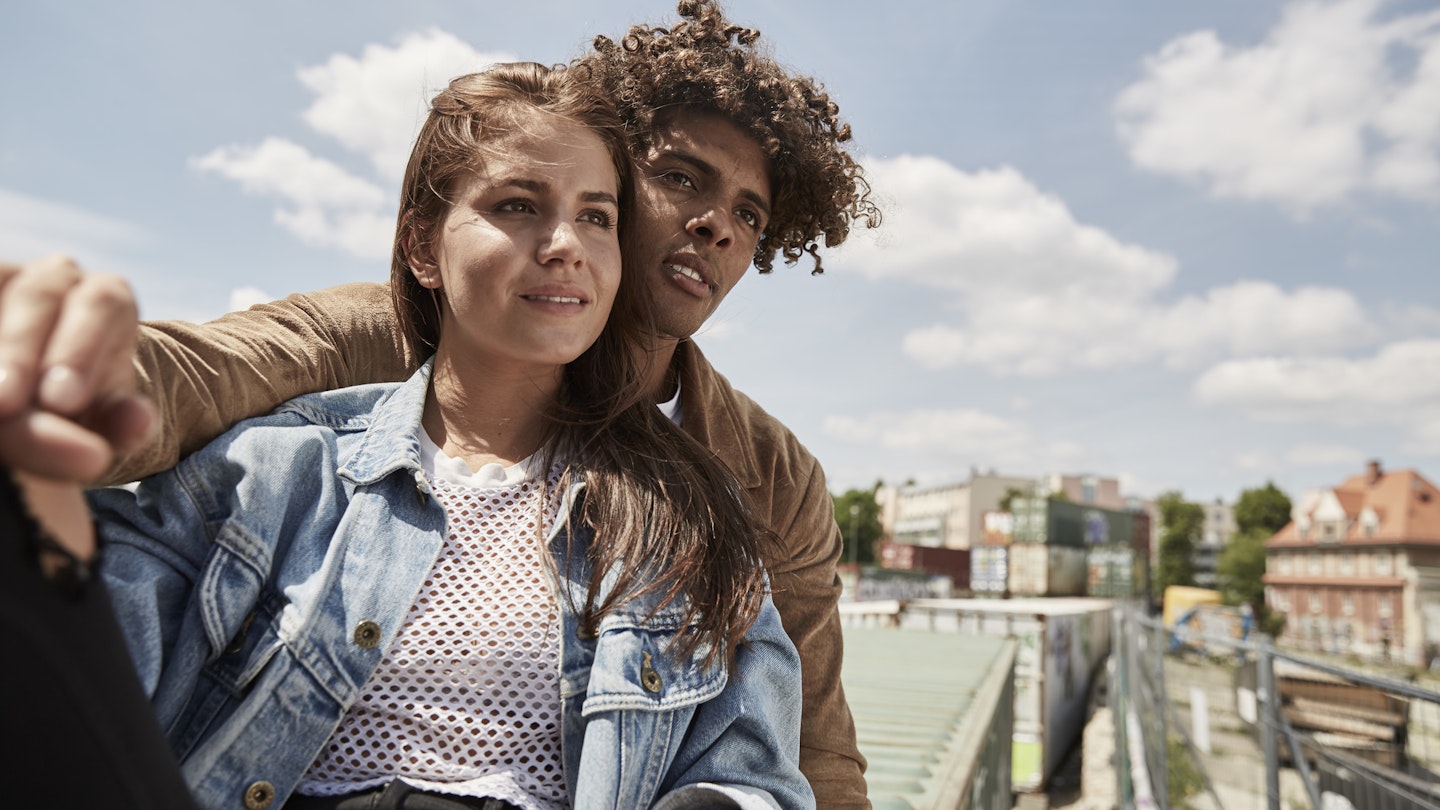
Make the most of your trip to Munich with our guide to getting around the Bavarian capital © Westend61 / Getty Images
Thanks to a great public transport system, an extensive bike lane network and a growing number of shared-mobility initiatives, getting around Munich is not only easy, it's enjoyable. While the Bavarian capital is known for its cars – it's the birthplace of German auto behemoth BMW – they are often not the best option because of traffic and few parking spaces.
Munich’s old town and much of the center can be explored on foot, with nearby neighborhoods and large parks likely to further increase your step count. Here's how to find your way around Munich.
See more of Munich by train, tram or bus
Munich’s public transport system will reliably get you from A to B – most of the time. The U-Bahn (subway) connects many places in the city, with trams and buses helping to fill in the gaps. Eight S-Bahn (urban rail) lines also run through the center before heading out to suburbs and other areas beyond the city limits.
As long as you keep traveling in the same direction, tickets can be used interchangeably on all of these modes of transport within certain time frames. Prices and conditions are based on different zones, but most sights and places of interest are in the central zone, known as Zone M.
A single ticket ( Einzelfahrkarte ) in Zone M costs €3.70 and is valid for two hours in one direction, while shorter journeys cost less and are valid for one hour. While this might initially sound confusing, a lot of helpful information is available on the MVV website .
You won't find any ticket barriers or manual checks in stations, but you might be subjected to random spot checks while traveling. Inspections are carried out by plain-clothed staff and normally begin once you are already moving, meaning there’s no escape from the hefty fines.
Tickets are available from machines at the station, and where these don't exist, which is often the case at bus and tram stops, you can buy them on board. Be aware that some machines are cash only, and some are coin only. If you are out of small change, you can also buy tickets on the MVV app – you’ll need to register first and have your ID on you. Remember to validate ( entwerten ) your ticket if necessary using the blue boxes you’ll see in stations or on buses and trams.
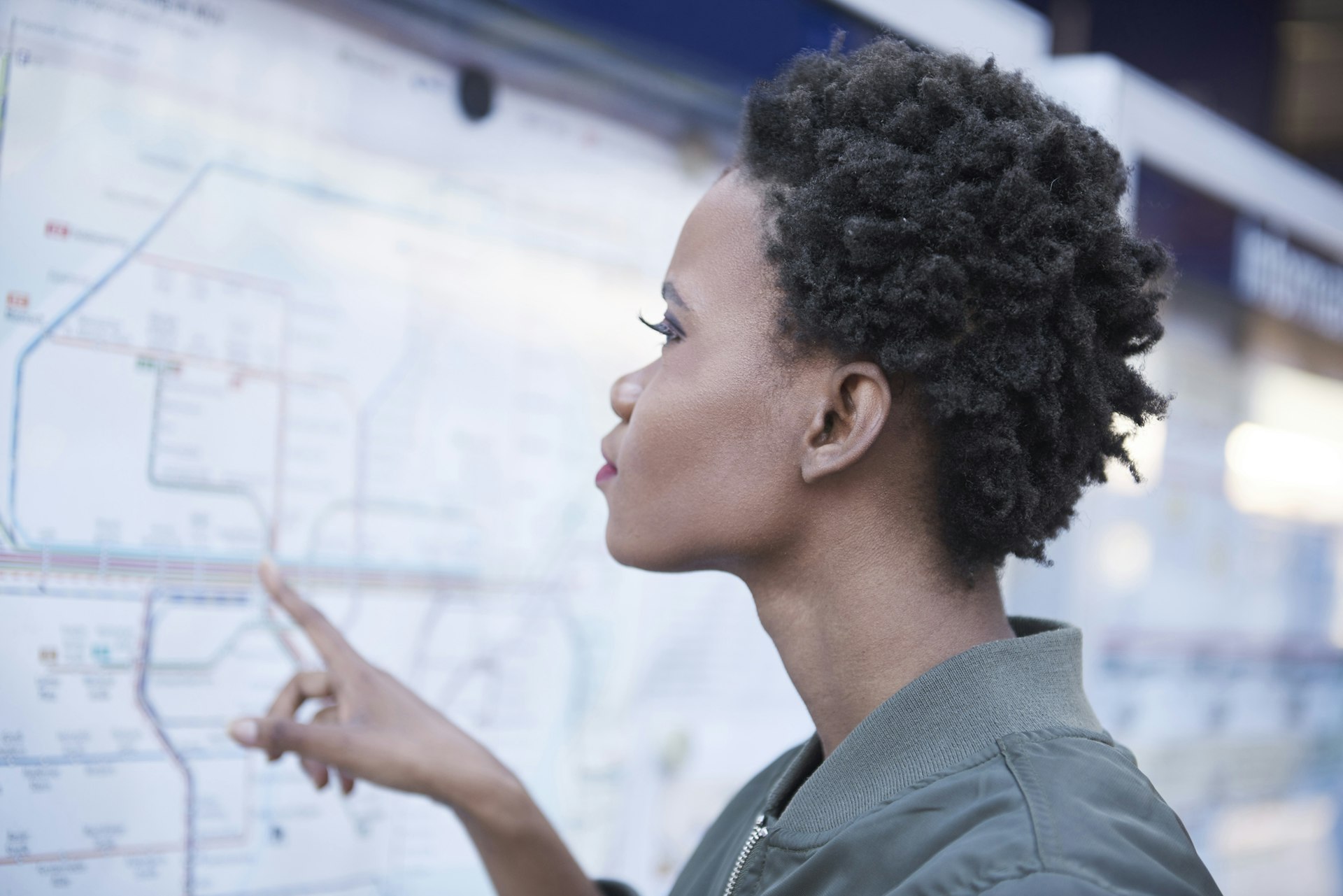
Choose the right transport pass for you
If you take more than two single trips in a day, it’s worth buying a day ticket ( Tageskarte ), available for individuals or groups. And if you’re staying in town for longer, the IsarCard , valid for a week or a month, could help stretch your budget further. A stripe ticket ( Streifenkarte ) is a good option if you only plan to use public transport sporadically during your trip.
There are also tourist deals that combine unlimited public transport with reduced or free admission to many sights and attractions. The Munich Card gives discounts to around 100 sights and tours, while the Munich City Pass includes free admission to 45 sights.
Scoot your way from A to B
E-scooters have been legal in Germany since 2019. Reaching maximum speeds of 20 km/h (12.5 mph), they are a popular way to whizz around town, particularly among the younger demographic. With several different operators in the city, the scooters are readily available and easy to hire. Tier and Voi are both official partners of the Munich Transport Company (MVG) and can be located using the new MVGO app (along with other nearby transport options). Both suppliers also have their own individual apps.
The minimum age for drivers is 14, meaning no driver’s license is required, but a number of regulations are in place. Riders should stick to bike lanes where available, and roads when not. Sidewalks and pedestrianized areas are off limits. Alcohol consumption rules are the same as those for cars, so be careful not to drink and scoot. Helmets are optional but highly advisable.
Electric moped-sharing schemes, such as Emmy , are also available, with helmets provided.
How to pay for your e-scooter
There's normally a fee to release the e-scooters, and then you pay by the minute. Some operators also offer day passes, which cost around €10 and give you a certain amount of time free for each ride.
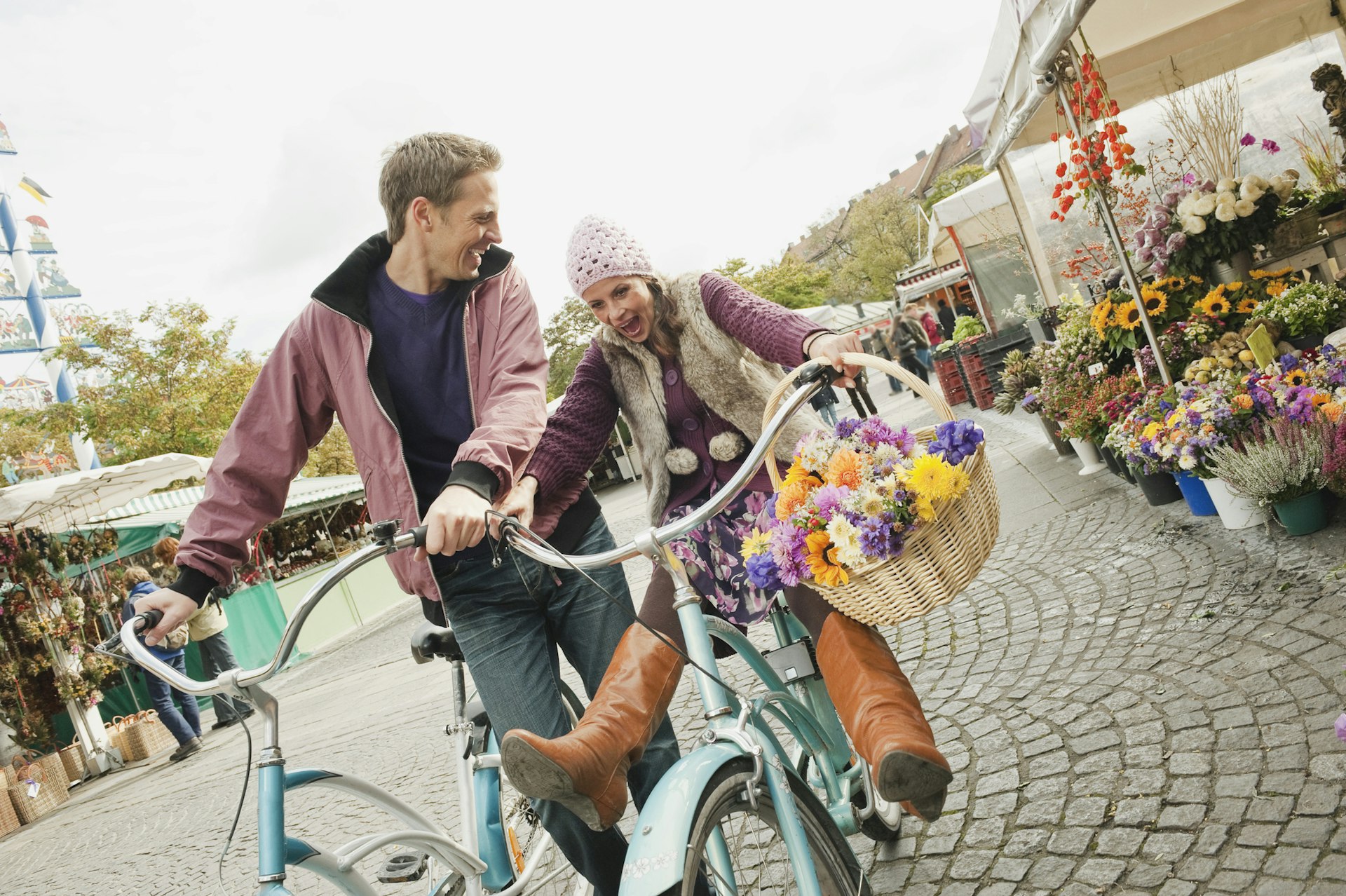
Get around like a local on two wheels
Cycling is one of the best ways to get around Munich. The city has an extensive bike lane network, including several routes through parks and along the river. Many locals favor this mode of transport, opting for two wheels to commute to work, head out for dinner or ferry around kids.
You can rent bikes, including increasingly popular e-bikes, for your whole stay or try out some bike-sharing initiatives. Operators include Deutsche Bahn (look out for red and silver bikes) and MVG (silver and blue bikes). Rather than a system of docking stations for collection and drop-off, it is possible to leave them parked on the street once you're done. While this is very convenient, it can also sometimes mean that the bike you spotted on your app is in fact hidden in someone’s backyard.
Driving in Munich is best avoided
Driving in Munich is possible but not really necessary. It’s sometimes no quicker than taking public transport or even going by bike. The traffic jams are notoriously bad, and finding somewhere to park can test your patience. If you'd like to explore beyond the city limits , you can rent cars from a number of places in the city and at the airport. Alternatively, for short journeys, you can sign up for a car-sharing scheme, such as MILES (where you pay by kilometer) and SHARE NOW (which works on a time basis).
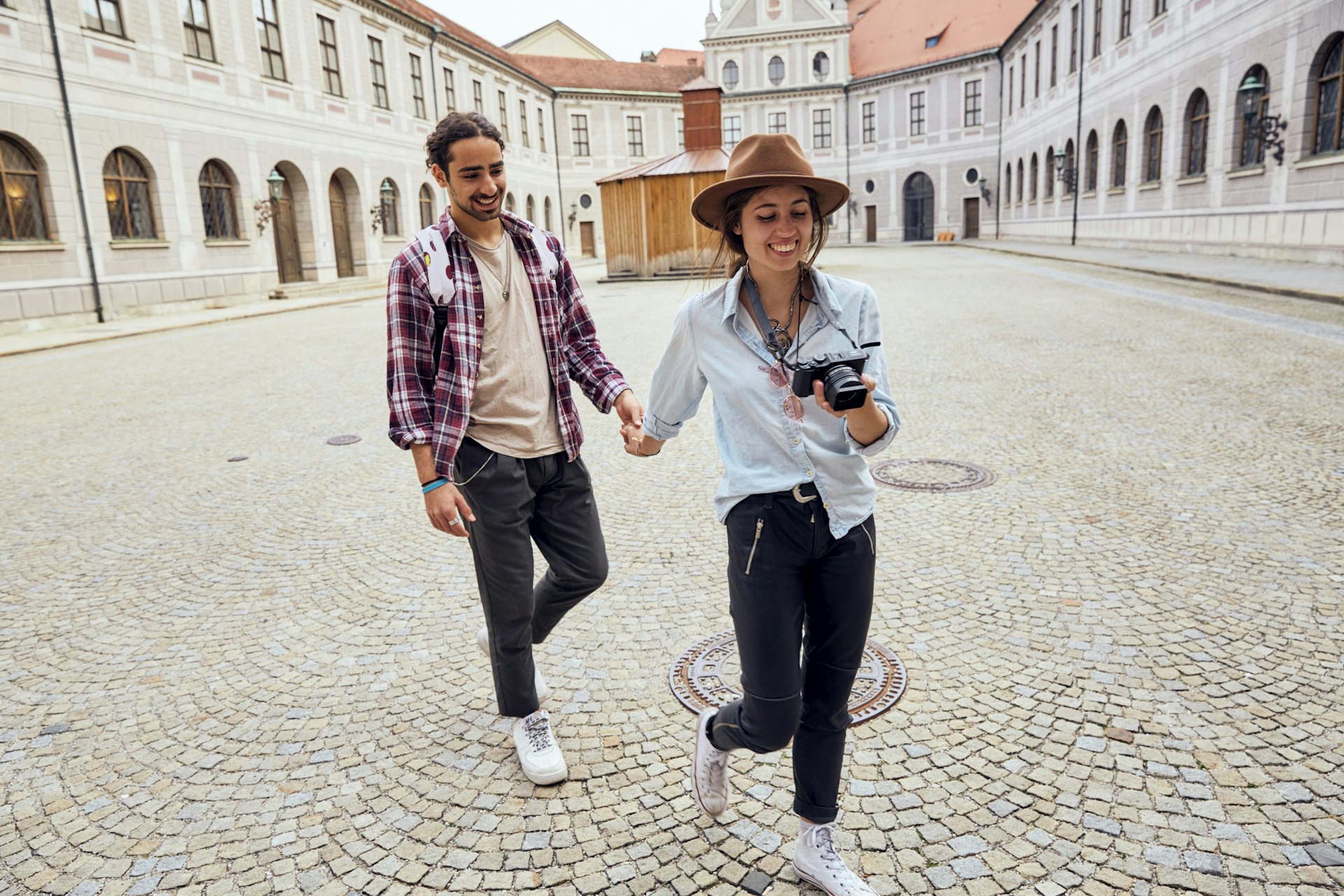
Explore the city's neighborhoods on foot
Munich is an extremely walkable city. The old town and surrounding areas can easily be explored on foot, as can all of the city’s parks , and the main shopping area is completely pedestrianized. Several neighborhoods and districts, such as Haidhausen, Maxvorstadt and Isarvorstadt, are close to the center, meaning you can easily extend your walking tour. Regardless of how you get there, Munich’s inner-city neighborhoods are made for strolling around.
Choose comfort over cost with a taxi
Munich’s cream-colored taxis are abundant. You can hail one on the street if the light is on, head to a taxi stand or use an app, such as FREE NOW, to organize a ride. While convenient, taxis certainly aren't the cheapest way to get around. Tariffs are strictly regulated by the city and cannot be exceeded or undercut. Expect a standard minimum fare (currently just under €5) and rates based on the distance traveled.
Accessible transportation in Munich
Munich’s public transport system has a good reputation in terms of accessibility. All of the U-Bahn stations have barrier-free access to the platforms, as do around 85% of S-Bahn stations. More than 90 stations have been specially designed for passengers with mobility issues.
Should you require assistance when boarding or exiting the S-Bahn or U-Bahn, wait near the front carriage so the driver can see you. On buses, use the red button near the middle doors for assistance.
For full details, check out the barrier-free access section on the MVV website , which includes a map outlining the services available at each station.
Learn more about accessible travel options by downloading Lonely Planet's free Accessible Travel guide .
This article was first published April 2022 and updated July 2023
Explore related stories
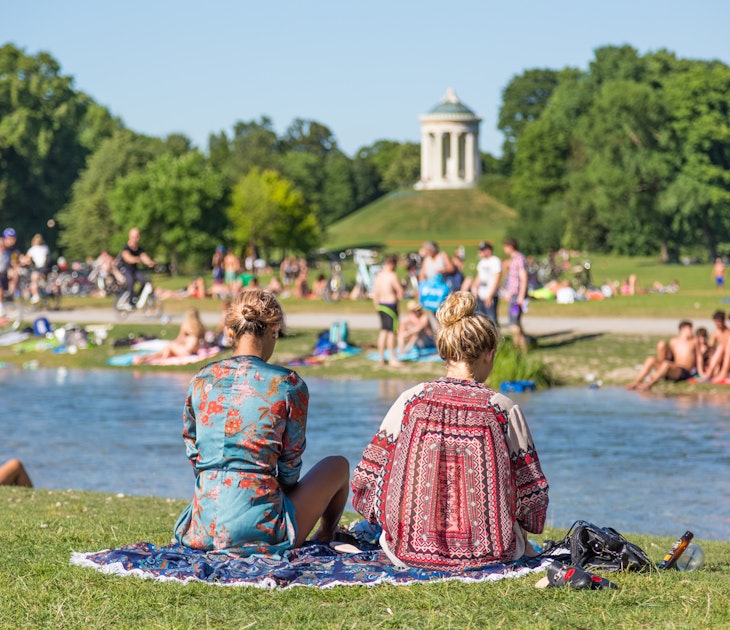
Budget Travel
Apr 27, 2024 • 6 min read
It may be Germany's most expensive city but there are still plenty of ways to visit Munich on a budget if you know how.
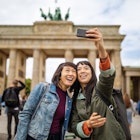
Apr 27, 2024 • 17 min read

Feb 29, 2024 • 2 min read
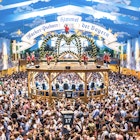
Feb 23, 2024 • 5 min read

Jan 16, 2024 • 8 min read

Oct 19, 2023 • 8 min read

Aug 3, 2023 • 4 min read
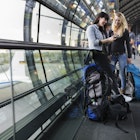
Aug 3, 2023 • 6 min read

Jul 28, 2023 • 3 min read
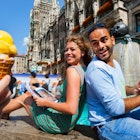
Jul 12, 2023 • 6 min read

Getting around Munich
Trains, trams and buses: Munich's public transport network is efficient and economical . Discover how best to get around the city with our handy guides.

Tickets & travelcards
You may also be interested in.
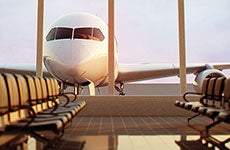
Munich Airport
Opened in 1992, Munich International Airport (MUC) is Germany's second busiest airport and has been rated as one of the best in the world.
Munich's underground railway network, the U-Bahn, has 8 lines serving almost 100 different stations around the city. Discover how to get around on it!
If you see this, your Adblocker is possibly misconfigured.
Sie haben JavaScript abgestellt! Hier können Sie über die Vorteile und Unbedenklichkeit von JavaScript auf for a visit lesen.
- Jump to the Mainmenu
- Jump to the Pagemenu
- Jump to Footermenu
- Jump to the Content
You are using an outdated browser. Please upgrade your browser to improve your security and experience.
You can replace the displayed maps from Google with an interactive map by clicking on the map image. A connection to the Google servers is only established with this click. Please read our information on Privacy Policy .
Tickets & Tariffs - Overview
The public transport network in Munich is divided in zones and rings and the tariff system can be even complicated for Munich locals. You can get lots of informations on the Homepage of the MVV
You can purchase your ticket at ticket machines at nearly every station. In Buses and Trams you can buy your ticket inside. You also can purchase your ticket online and print it out.
When you are exploring the city of Munich the Day Ticket is the perfect ticket, as it is valid for as many trips as you like until 6 a.m. the following day.
For trips inside the city the inner district is sufficient (Innenraum). This ticket is also available for 3 days. On the map for the S-Bahn network this area is marked in white. If you want to visit Munich suburbs, too, we advice you the day ticket Munich XXL (München XXL), this is valid in the white and green zones on the map for the S-Bahn network.
Who only wants to visit the outer district of Munich, this is the green, yellow and red zone on the map for the S-Bahn network, should buy a day ticket for the outer district (Außenraum) which can be combined with a day ticket for the inner district.
Of course there is a day ticket for the entire public transport network in Munich, too. The "Gesamtnetz".
Partner-Day-Ticket & Group-Day-Tickets
All day tickets are also available as Partner- and Group-Day-Tickets. The Group-Day-Ticket is valid for up to 5 adults and 10 children between the age of 6 and 14.
Children under 6 years old travel free of charge.
Furthermore the day ticket and the day ticket for the outer circle are available as single and partner day tickets.
CityTourCard
The CityTourCard is a special offer for tourists in Munich. It includes a discount card that can be used at over 70 tourist attractions. The CityTourCard is also available for 3 or 4 days, too. You will find more infos on the website of the CityTourCard
Stripe ticket & Single Tickets
The stripe ticket is frequently used by Munich locals, too, as it can be used for all trips using the MVV (S-Bahn, U-Bahn, Tram, Bus). You just need to validate the respective number of stripes – for one person or more people. One trip in the inner district of Munich is 2 stripes for one adult. For each further zone two more stripes have to be validated. You are allowed to change and interrupt your trip. Return and round trips are are not allowed.
Exceptions are short trips (Kurzstrecke): Up to 4 stops with bus and trams and 2 stops with S- and U-Bahn validate just one stripe. Children between 6 and 14 years old only validate one stripe per trip, no matter how far the travel.
Single Tickets can be bought accordingly for 1, 2 or 4 Stripes.
Both ticket types must be validated before getting into the vehicles.
Validate tickets
All tickets that do not show a date have to be validated. Small blue boxes are usually situated by the stairs that lead to the platforms. Here you can validate your ticket. In the trams and buses you can validate the ticket inside the vehicle, watch out for the blue boxes, too.
When buying a ticket at S-Bahn you will have to pay VAT. The MVG sells tickets without VAT. This is interesting for traveling businessmen and woman who use Munich public transport for business reasons.
Tickets & Tariffs at a glance!

A ticket machine in München Pasing
Toolbar-Menu
Listen to informations of tickets & tariffs as audio.
Hear text as audio
- 1. Tickets & Tariffs - Overview
- 2. Day Ticket
- 3. Partner-Day-Ticket & Group-Day-Tickets
- 4. CityTourCard
- 5. Stripe ticket & Single Tickets
- 6. Validate tickets
QR-Code Mobile-Version
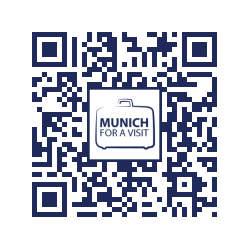
This Website is currently under maintainance, information could be outdated.
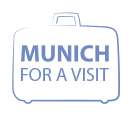
- Premium offers
- 1 room apartments
- 2 room apartments
- 3 room apartments
- 4+ room apartments
- Serviced Apartments
- How to rent - next steps
- Premium Offers
- 3 room aparments
- Client Inquiry
- Returning the Apartment
- Tenant Feedback
- How to find an apartment
- Registration in Munich
- Parking in Munich
- Public Transport in Munich
- Energy saving tips
- Waste Disposal
- Create Search Profile
- Real Estate Prices
- FAQ for buyers
- Sales Process
- Reference Objects
- How to sell
- Real Estate Valuation
- Home Staging
- Real Estate Photography
- Register new object
- Cost overview
- Rental Process
- "The Ideal Property"
- Reference Projects
- General Terms and Conditions
- Determination of the Rental Price
- Interior Design
- Technical Service
- Photo & Video Service
- Cleaning Service
- Energy-saving equipment
- Headquaters in Munich
- Office Rottach-Egern
- The Company
- Real Estate Market
- The Network
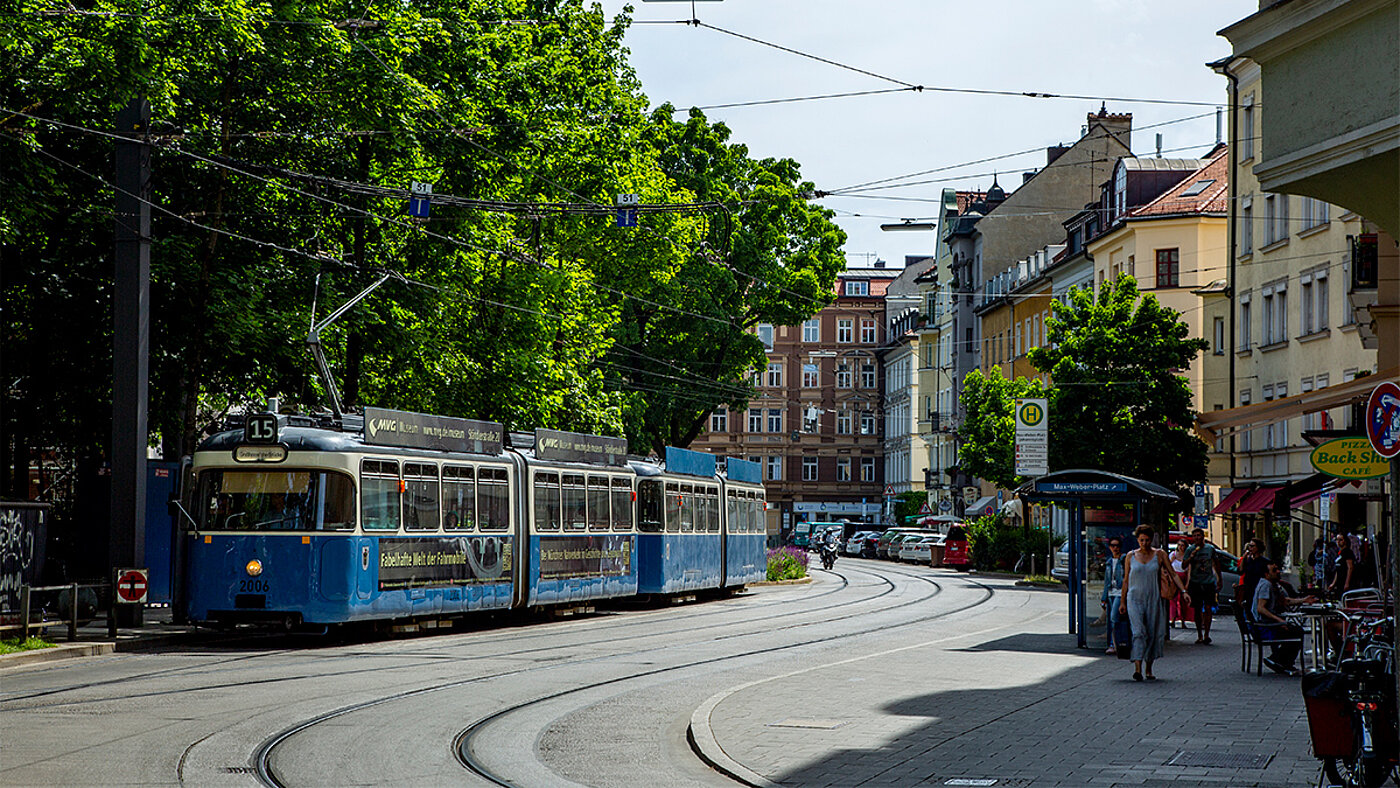
Munich’s Transport Network – MVV
With public transit through munich.
The city of Munich has a large pu blic transport network consisting of S-Bahn, U-Bahn tram and bus and is made up of the Munich city area with zone M, as well as zones 1-6 for the municipalities outside Munich.
An overview of all zones can be found here , where all routes of the different means of transportation are marked. There are also individual network plans for U-Bahn & S-Bahn, tram & bus and the night line network.
The Tariff System
- The Munich urban area is grouped together in Zone M. Adjacent municipalities are divided into zones 1-6. Here you can check in which zone your station is located and which ticket you need for your journey.
- Single tickets, day tickets and 3-day tickets can be purchased either for zone M only, for selected zones 1-6 only or for zone M plus any number of zones.
- A “Kurzstrecke” means a short trip up to the 4 th stop, but only 2 stops with S-Bahn, U-Bahn or X-bus. The ticket for a short zone is valid for a maximum of 1 hour, the journey may be interrupted within the permitted stops. Return trips are excluded. A short trip can be bought with a single ticket or with a “Streifenkarte”, a strip ticket. The strip ticket is valid for several trips and zones and can be used at different times.
- Single and stripe cards can be stamped either for zone M, individual zones 1-6 or zones M-1 to M-6. You can find the exact tariff information here . Please note that single and strip tickets are limited in time after stamping and are valid only in one direction. Day tickets, weekly tickets and monthly tickets are valid for any number of journeys.
- Day tickets and 3-day tickets can also be purchased as group tickets for up to 5 persons.
- There is a so-called IsarCard for weekly and monthly tickets. This is also available at a reduced rate for journeys from 9 a.m. or for persons aged 60 and over. There are also special training tariffs for pupils, students and trainees.
- Carrying hand luggage, prams and taking your dog with you is free of charge.
- Bicycles may be taken along for €3.00-, but not on weekdays from 6 a.m. to 9 a.m. and 4 p.m. to 6.p.m.
The Deutschlandticket
Since May 2023, the "Deutschlandticket" has been valid nationwide on local and regional transport and, with a monthly subscription of €49, is a cheaper alternative to monthly tickets, especially in the greater Munich area. For students, trainees or those doing voluntary service, a discounted subscription of €29 is even possible. The subscription also automatically extends, so you don't have to worry about purchasing a new ticket every month. It can also be canceled monthly.
The ticket is valid for the entire local public transport, i.e. bus, streetcar, subway, S-Bahn and regional trains (2nd class). It may not, however, be used for long-distance services or private providers. Furthermore, it is non-transferable, only children under the age of six may travel free of charge.
The MVG recommends you use the "Deutschlandticket" as a mobile-ticket in the MVGO app. Alternatively, the ticket is also available as a chip-card.
More information can be found here .
Tips for a comfortable journey
- In order to be able to see the next connection possibility, we recommend the timetable information of the MVV .
- You can also check this while on the move with the MVV-App .
- If you don't have the right amount of change, you can also buy the MVV-MobileTicket .
Mr. Lodge wishes you lots of fun exploring the city of Munich and a good trip!
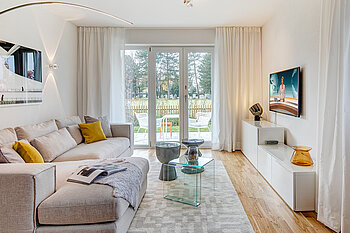
- Mr. Lodge GmbH | Search. Find. Live.
- Tips for New Munich Residents

40+ Munich Travel Tips for First Timers & Must Knows Before You Go
*FYI - this post may contain affiliate links, which means we earn a commission at no extra cost to you if you purchase from them. Also, as an Amazon Associate I earn from qualifying purchases. Check out our Privacy Policy and Disclosure. for more info.
Famed for Oktoberfest, giant pretzels & fun leather pants, the beautiful city of Munich, Germany is a picturesque wonderland that is (in my very biased opinion) one of the best cities to visit in Europe.
But it’s not all beer-fuelled frolics and comically carby treats. Navigating Munich for first-timers isn’t the easiest task, especially if you want to do the city justice and explore more than just the biggest tourist sights.
So, allow me to share all my best Munich must knows with you as someone who lived there for over five years.
In this post, I’ll be sharing all my best Munich tips to make sure you fall head over heels for this former home city of mine. Get ready – it’s a long one!

Save this list of Munich Travel Tips for later!
You’ll be very glad you did.
1. Steal my ready-made Munich itineraries
Before we dive into my detailed rabbit hole of Munich travel tips, I’d first like to scare you off with some prior fruits of my fangirly labour.
Over the years, I’ve entertained so many visitors and fielded so many Munich queries that I’ve already pre-assembled some itineraries for the city that I consider pretty perfect.
So, before you read on, save yourself some work and steal these itineraries for…
- Munich in one day
- Munich in two days
- Munich in three days
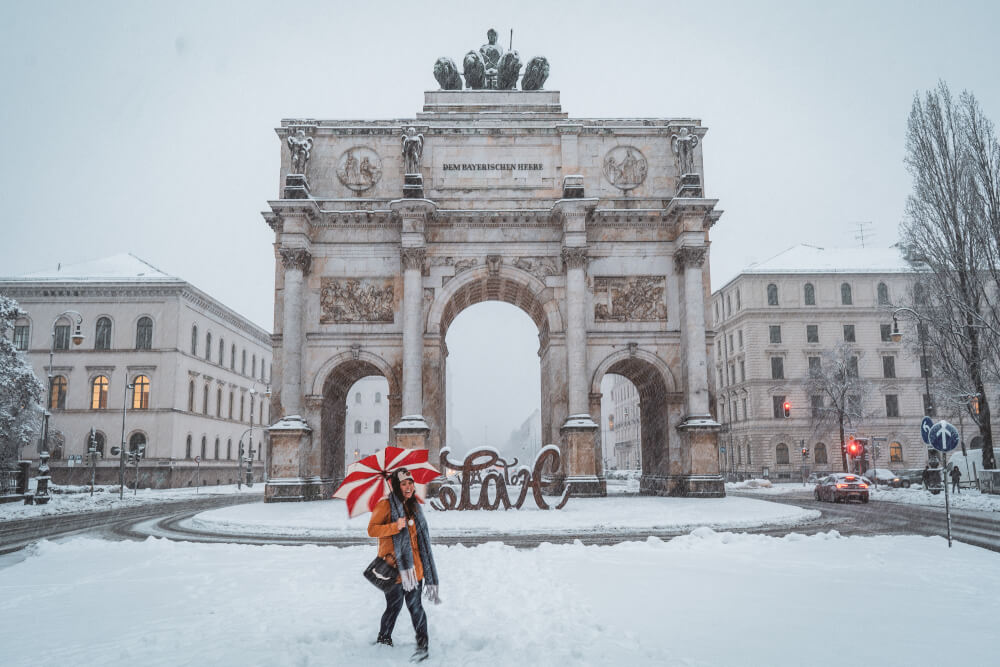
2. Understand Munich’s year-round offerings
Alright, now onto the real Munich tips!
First off, let’s tackle when to visit. While millions flock to Munich every year for Oktoberfest, there are really are solid reasons to visit year-round, like…
- November/December: Munich Christmas Markets
- February: Fasching
- March – April: Starkbierfest
- April – May: Frühlingsfest
- Summer: Beer garden season and small local folk festivals
- September – November: Oktoberfest , Fall Foliage, etc.
So, don’t limit yourself to just visiting for Oktoberfest – there are plenty of enticing incentives no matter the season.
NOTE: If I were to pick months to avoid though, they would probably be November and January, when the weather is iffy and there are fewer big events happenings.
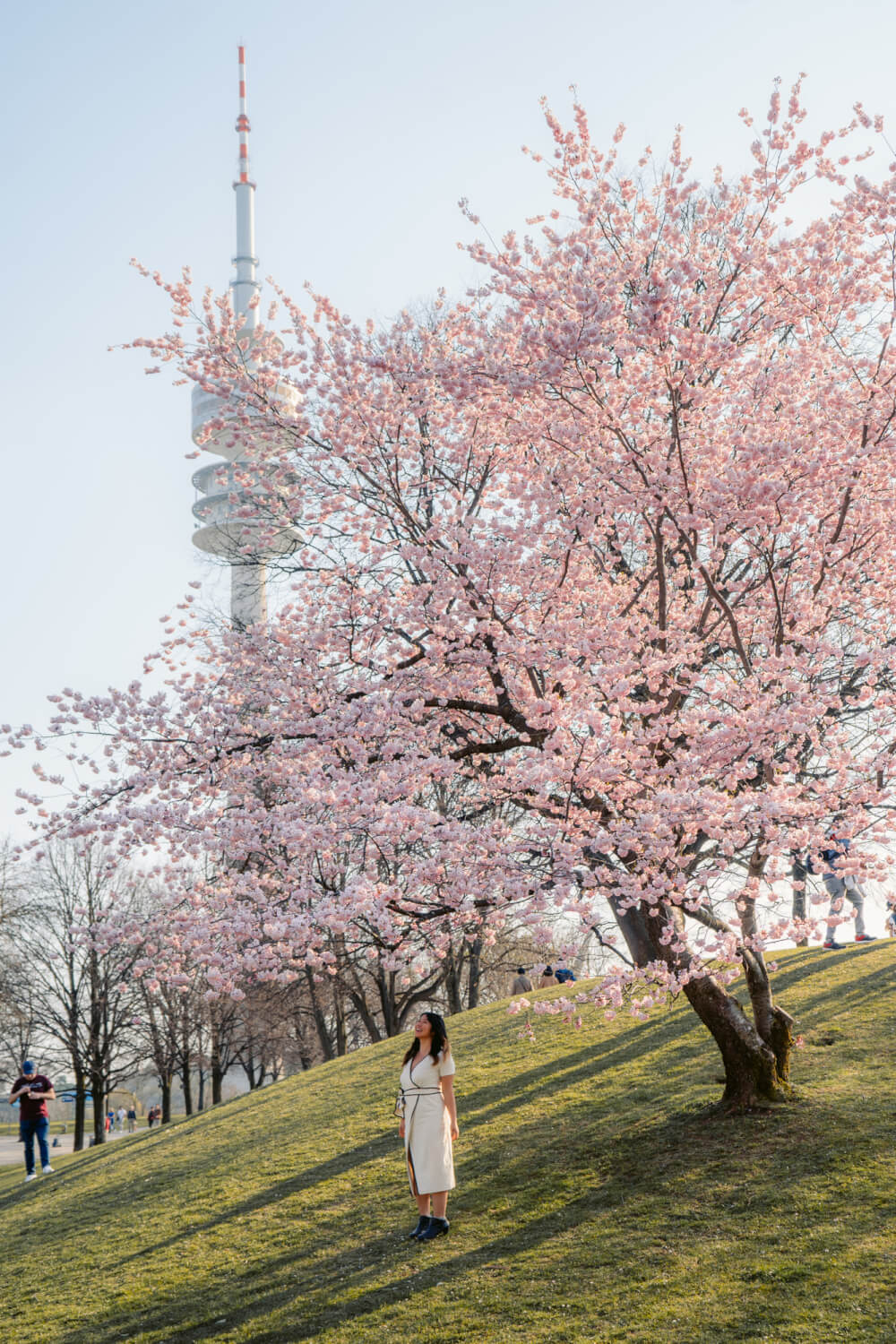
2. Plan to spend more than just a day or two in Munich
In terms of how long to spend in Munich, I get wildly offended when people think you can complete the city in a day or two.
Sure, you can tackle most of the main sights in that time but I’d really advise four days minimum to properly cover the city and maybe do a day trip or two to some of the amazing spots nearby.
One of the best ways to enjoy Munich is relaxing in a beer hall/beer garden, gulping down a beer or five, and just generally soaking up the immaculate vibes of this liveable city.
So, don’t rush through Munich. Give yourself some extra time and I promise you’ll have a much better experience.
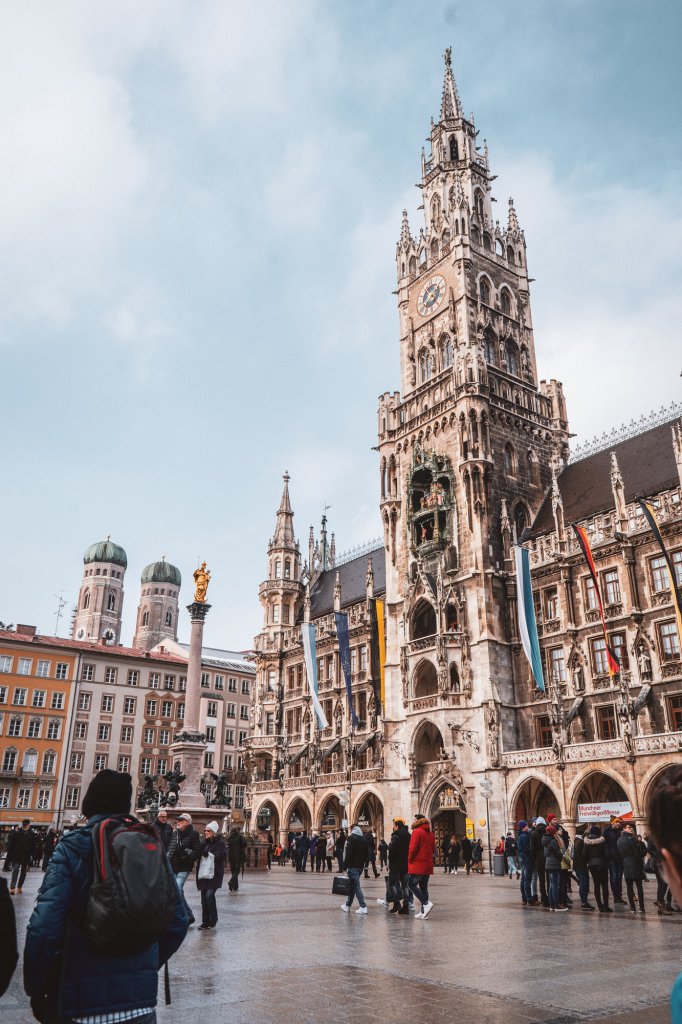
3. Learn the pros and cons of staying in different areas
Now, let’s chat about where to stay in Munich.
Generally, anything within the M-Zone (the white area in this map ) and near an U-Bahn station is convenient enough for most visitors. Munich is small and it doesn’t take too long to get anywhere.
If money is no object however, ideally you’ll want to stay within the Altstadt (Old Town), which puts you within walking distance of Munich’s major attractions.
If you want to be a bit out of the tourist core, then some other potential neighbourhoods include…
- Lehel : Quiet and pretty, but pricey. This was my old neighbourhood and I loved being able to walk into town without dealing with the crowds of Altstadt.
- Glockenbachviertel: A very vibrant neighbourhood full of cool restaurants and bars, with easy transport links into the center of town.
- Haidhausen: Very pretty little neighbourhood with a village-like feel, and still well connected to the centre by public transport.
Lastly, there’s the area around Olympiapark which I love but honestly it’s not the closest to Munich’s main attractions so I wouldn’t necessarily recommend it for first time visitors.
NOTE: You’ll often find that hotels are cheaper near Munich’s main train stations, but just beware that these are generally less “pretty” areas of the city. If budget is a key priority though, they’re not bad, especially if you need to be in the area for catching a train or going to events like Oktoberfest for instance.
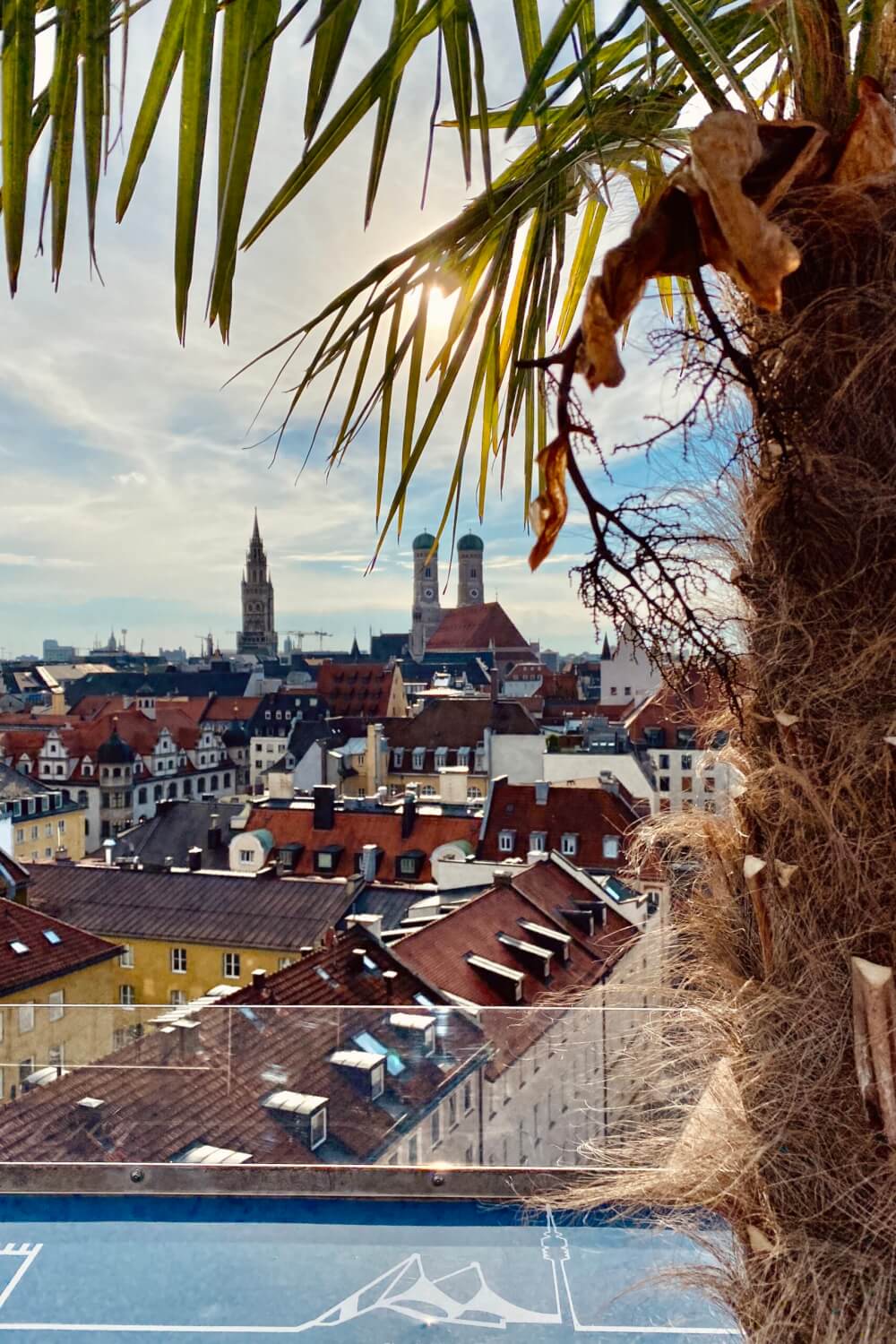
4. Don’t miss Munich Airport’s Brewery!
One of my favourite Munich fun facts is that it’s home to the world’s first airport brewery – Airbräu, located at Munich Franz Josef Strauss Airport (AKA Munich International Airport).
Besides the novelty of it being an airport brewery , unlike most airport options, the food and drink here is both delicious and reasonably priced (a 1L Maß of beer for only €5.90!!!)
So, if you have a later flight, then it’s definitely worth getting to the airport early for some pre-flight indulgence, or to grab a leisurely bite after your flight before heading into the city.
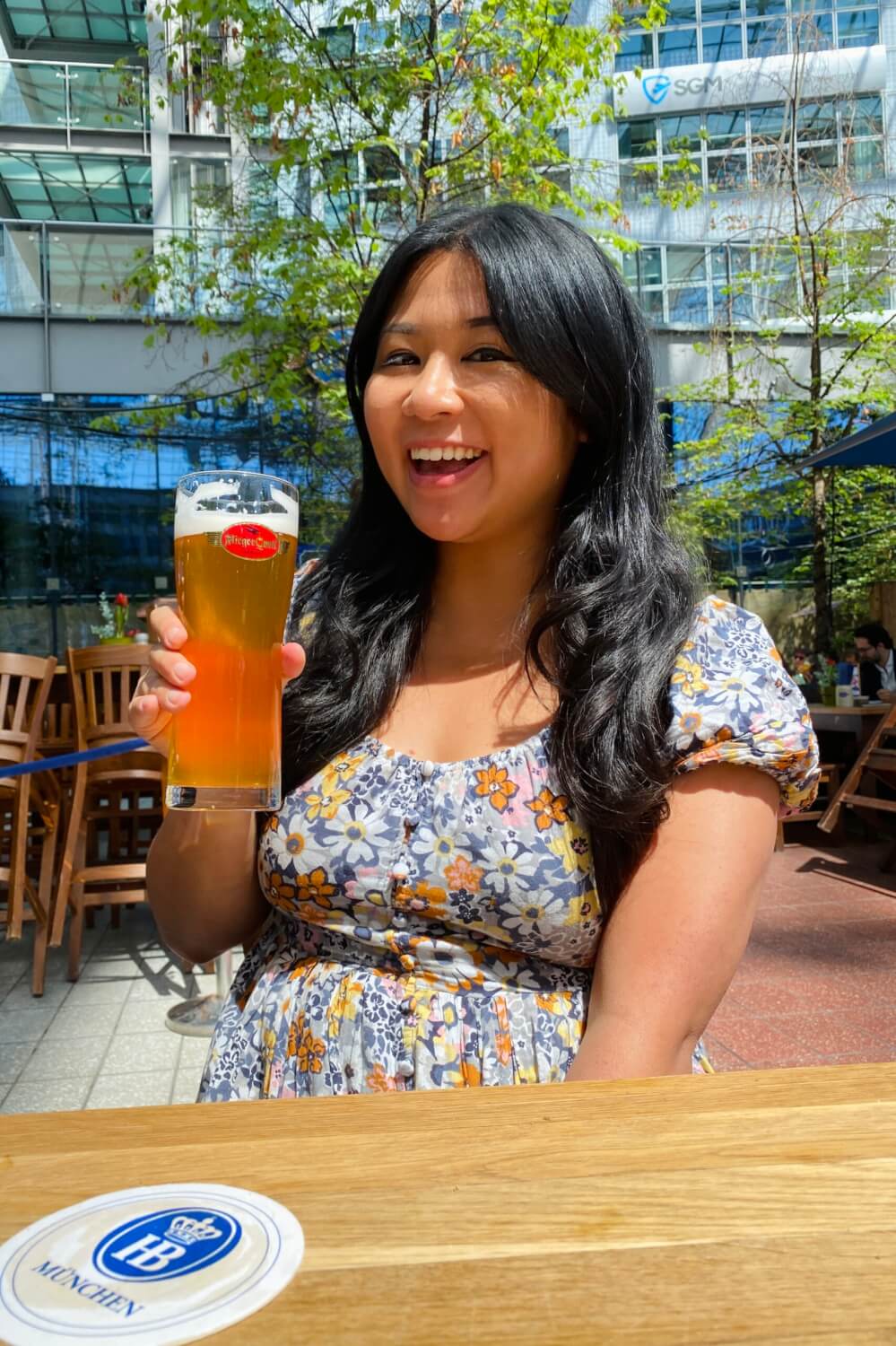
5. Beware of “Munich West” Airport
Now, while Munich Airport is an excellent airport and the most likely point of entry for most international visitors, another “local” airport to beware of is the one known as Memmingen Airport or Allgäu Airport, sometimes billing itself as “Munich West” when servicing budget carriers like Ryanair , Wizz Air or easyJet.
While this name is becoming increasingly less common (likely due to complaints), it’s important to note that “west” in this instance really does mean west… as in, 1.5 hours west from Munich’s city centre.
So, just keep that in mind if you’re booking flights and you see it pop up as an option. While it can often have very affordable flights, the trade-off is you need to hop on a paid shuttle for 1.5 hours before arriving into town.

6. Public transport is the best way to get around
In terms of getting around Munich, public transport is a convenient and cost-effective option, so there’s no need to buy a pricey hop on/hop off bus tour or rent a car.
With a reliable and punctual network of buses and trams, in addition to the U-Bahn (the underground metro system) and the S-Bahn (the suburban train system), Munich’s public transport will get you pretty much anywhere you need to go.
I have a full guide to Munich’s public transport that explains everything fully, but here’s a quick overview:
- Transport on Munich’s local network all use the same tickets so you can mix and match different modes of transport as needed
- There are no fare gates. Instead you’re expected to buy and validate your own ticket, then show it if a ticket controller comes on board
- Tickets can be purchased in-person at machines (press the UK flag to activate the English menu) OR more conveniently, you can download the MVG app which allows you to search routes and buy the correct tickets really easily
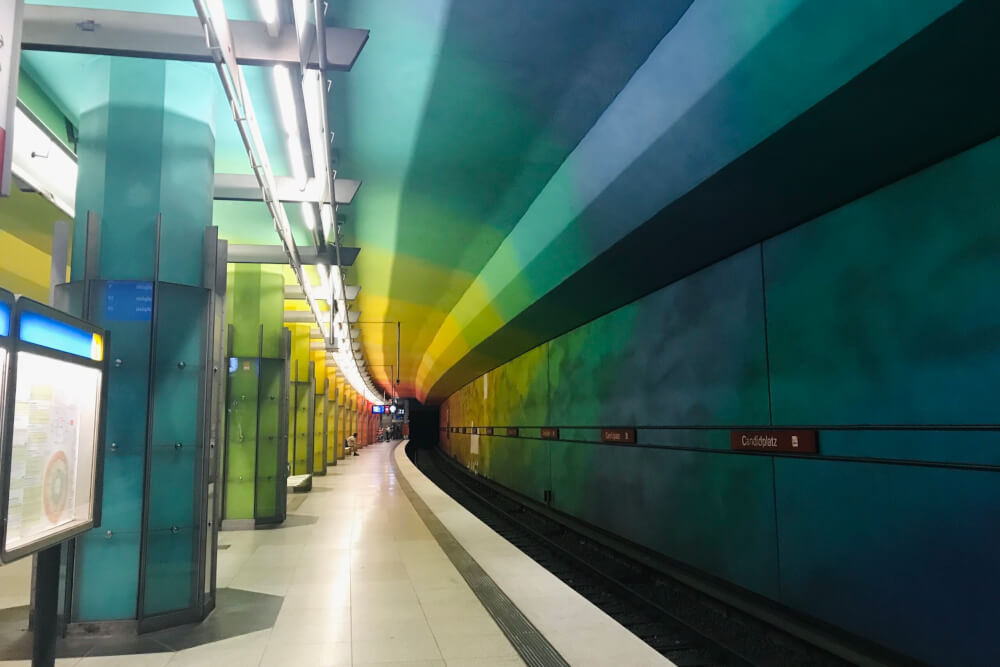
7. Remember to validate your ticket correctly
If you plan to use public transport during your Munich trip, one of THE most important must-knows is that you need to validate your ticket properly to avoid getting fined. Just having a ticket isn’t enough.
You can validate your tickets though machines that look like this:
Alternatively, if you use the MVG app, you can just buy/validate tickets right on your phone, and you’re much less likely to mess up.
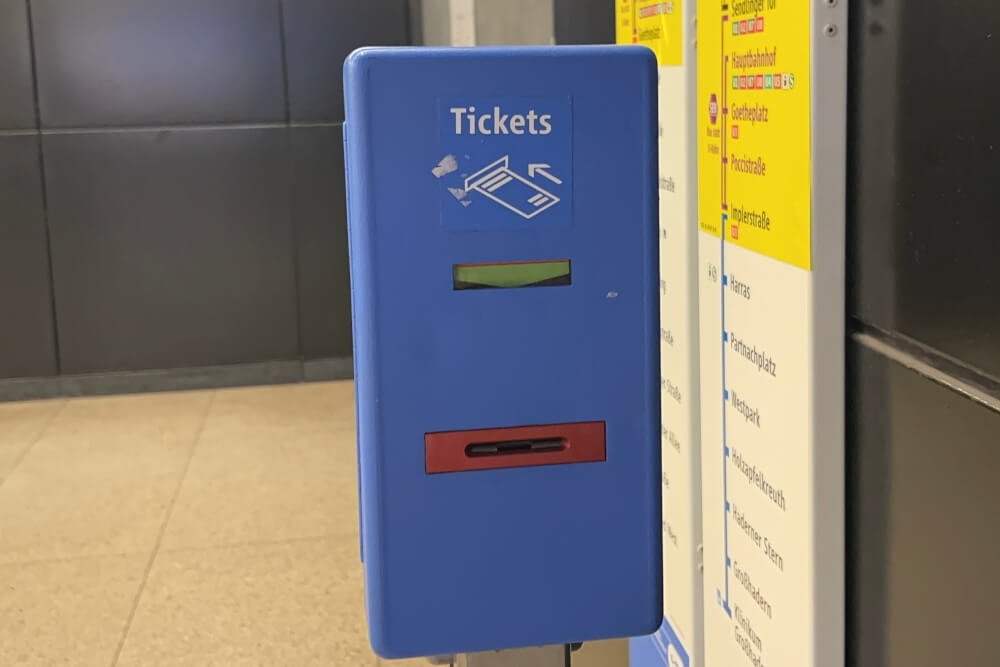
8. Look into special tickets to save money
Another important Munich must-know is this: very rarely will buying a single one-way ticket be the best option.
There are tons of different ticket types and discounts that are suitable for visitors, so if you’re looking to save money, here are some public transport tickets to consider:
CityTourCard: This is a made-for-tourists offer that bundles unlimited public transport for set days with travel to/from the airport along with some discounts for paid attractions. Only really worth it if you plan to visit a lot of the included attractions/want peace of mind.
Stripe Tickets: This is often the best value for visitors who are using public transport sparingly. With a stripe ticket, you buy 10 stripes that you redeem as you go. The # of stripes you must redeem depends on how far you’re going, but most journeys within one zone are worth 2 stripes. Overall, this works out to be cheaper than buying single tickets every time.
Day Tickets: This allows you unlimited travel for the day, and is usually worth it if you plan to do three or more trips on public transport that day. You can even get a group day ticket that covers journeys for multiple people.
Short Trip Tickets: There’s also the short ticket so if you’re only going 2 stops or less on the Ubahn or 4 stops or less on the bus/tram, you can buy a short ticket which is much cheaper.
IsarCards: These are weekly/monthly passes that give you unlimited travel during the period of validity and may be worth it if you’re in Munich for a longer time.
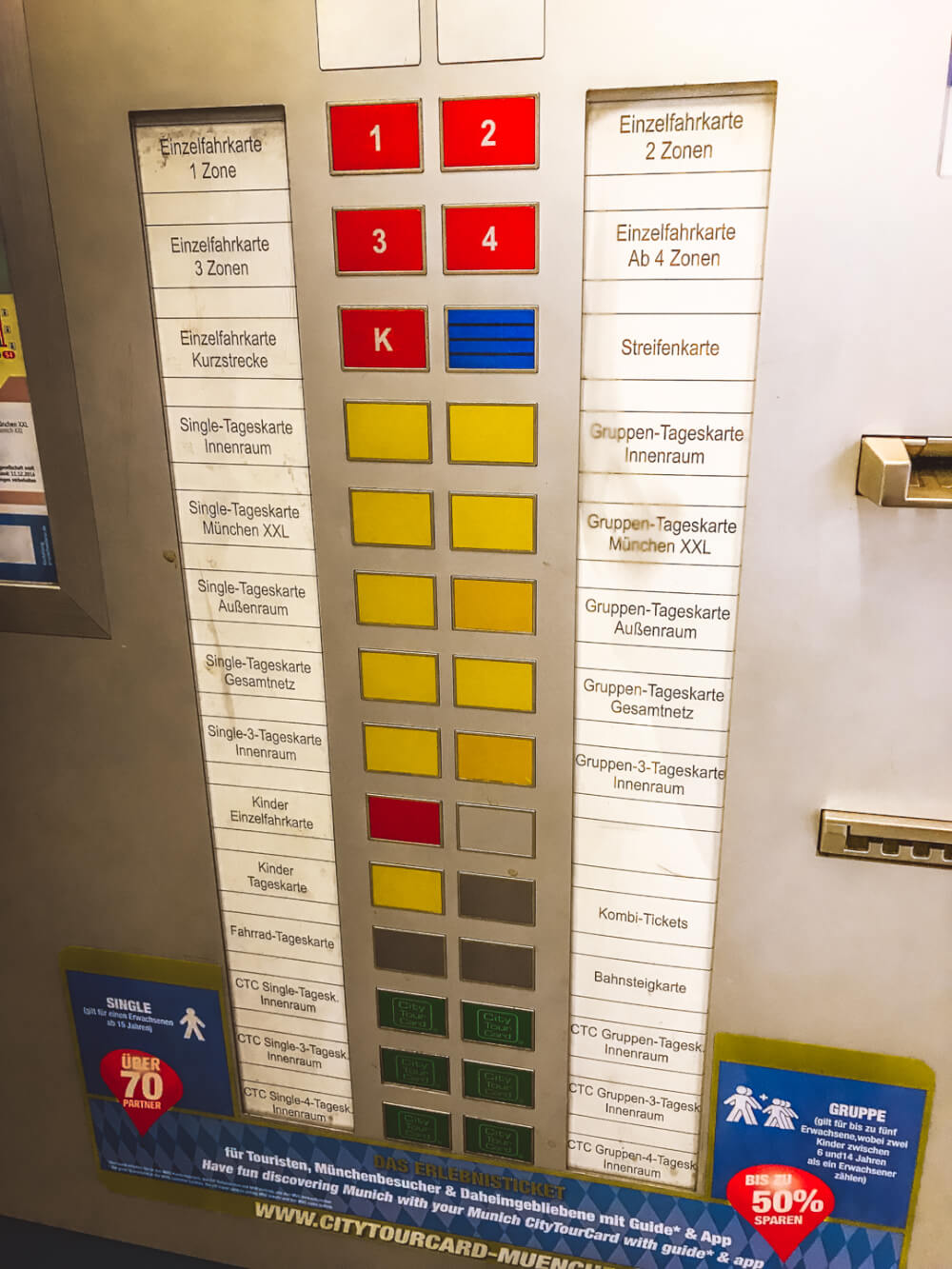
9. Buy a Bayern Ticket (AKA Bavaria Ticket) for day trips
Besides local transport offers, there’s another epic discount for state-wide train travel that I must alert you to: the amazing Bayern Ticket (AKA Bavaria Ticket).
This ticket gives you unlimited travel on regional trains and public transport within Bavaria for one whole day, making it perfect for day trips… especially if you’re travelling with others, because the per person cost is cheaper for every additional person you add.
Best of all, it works on local public transport too! The amount of money I’ve saved using this ticket over the years is truly mind-boggling, so I hope you get good use out of it too!
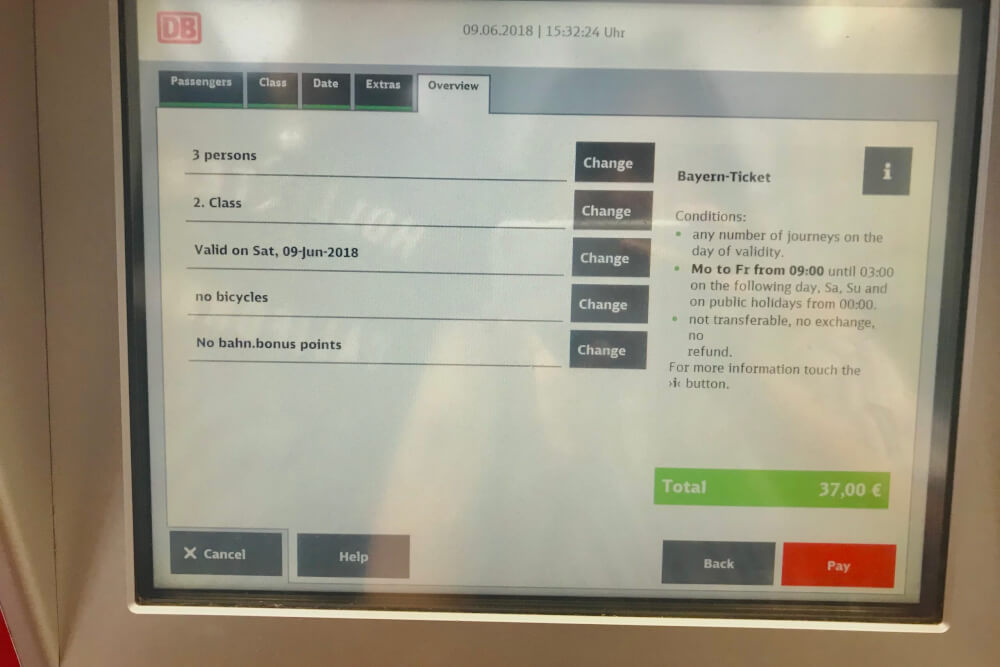
10. Do at least one day trip during your visit
On that note, Munich is an amazing base for various day trips, so if time permits, I’d highly recommend venturing out of the city to see some of the amazing spots nearby.
Here are some popular ones that I’ve written day trip guides for:
- Neuschwantein Castle
- Kehlsteinhaus (Eagle’s Nest)
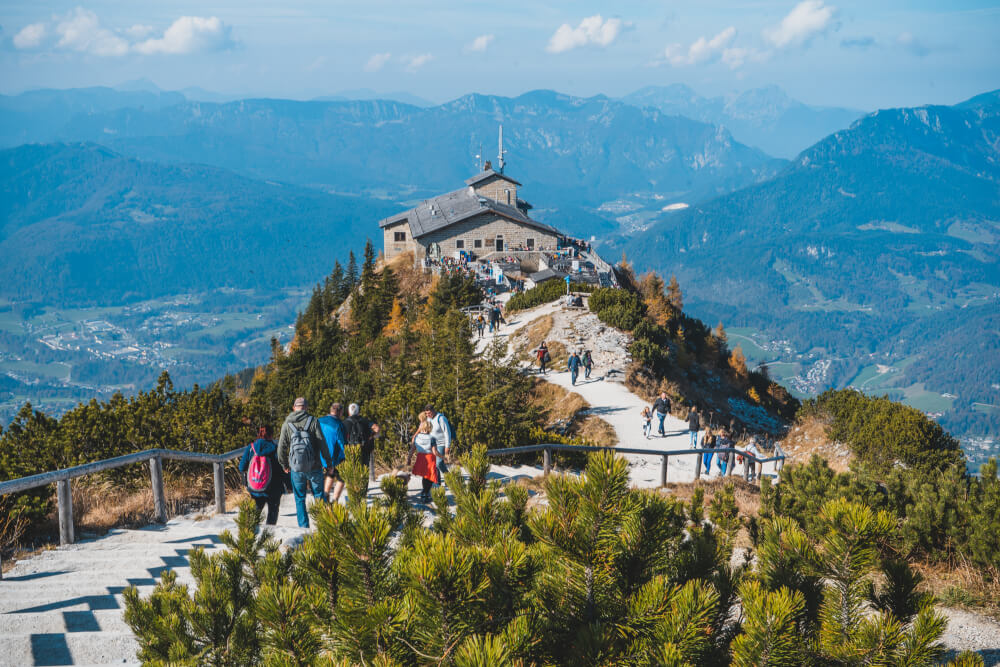
There are also many beautiful lakes close to Munich that I can recommend checking out:
- Starnberger See (Lake Starnberg)

11. Beware that there are several large train stations in Munich
When booking train travel, first-time visitors to Munich can often get confused by the different station names, SO beware that there are several large train stations in the city, and depending on where you’re staying, you may be closer to one over the other.
Here are the main stations to look out for:
- München Hauptbahnhof (HBF) – the Central Station
- München Ostbahnhof – the East Station
- München Pasing
So, again, when booking tickets, be sure to identify which station is closest to your accommodation rather than going in/out of the main central station (Hauptbahnhof) every time.
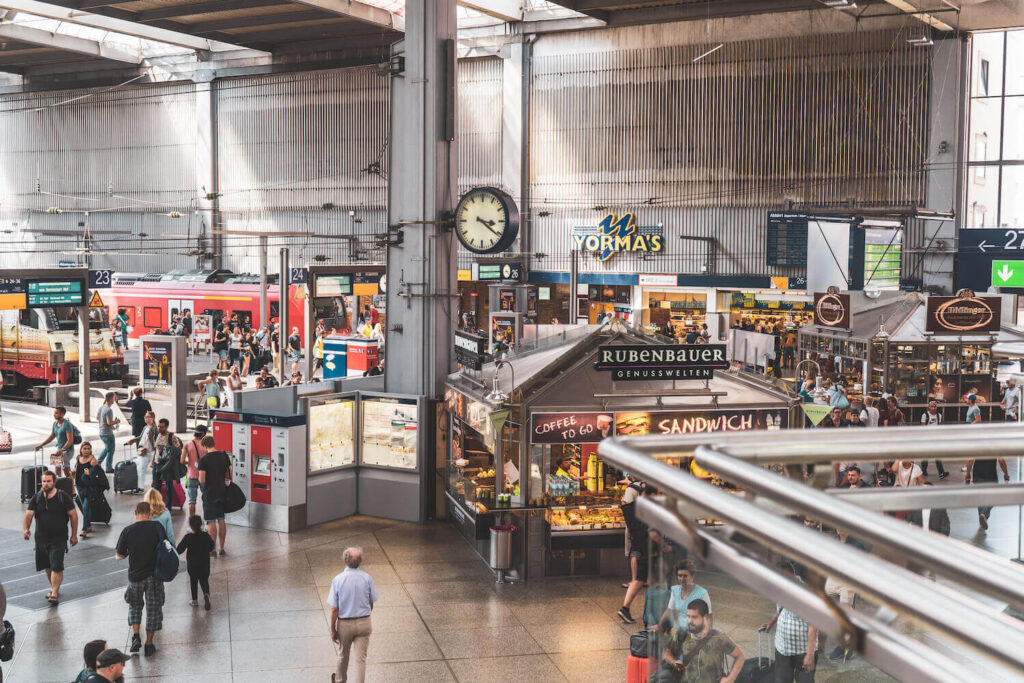
12. You can bring your own food to beer gardens
If you’re looking for Munich money-saving tricks, here’s one for you.
Many first time visitors don’t know this, but when it comes to large self-service beer gardens (like the Chinese Tower for instance), you can actually bring and consume your own food, a right protected by law in the Bayerische Biergartenverordnung (Bavarian Beer Garden Ordinance).
Under this ordinance, when you’re in a Bavarian Biergarten, so long as you buy a drink, you’re welcome to hang out and enjoy whatever snacks you smuggle in… within reason, meaning you’re not meant to bust out a BBQ and grill up a full hog roast, but bringing little nibbles like salads, dips, salads, sandwiches, etc. is all fair game.
Of course, this general rule only applies to self-service areas of large beer gardens, and not individual restaurants that may have patio space. When in doubt, look for places that are labelled “Biergarten” rather than “Wirtsgarten”.
If you see servers, table service, or table cloths, these are generally red flags that you’re not allowed to bring and consume your own food.
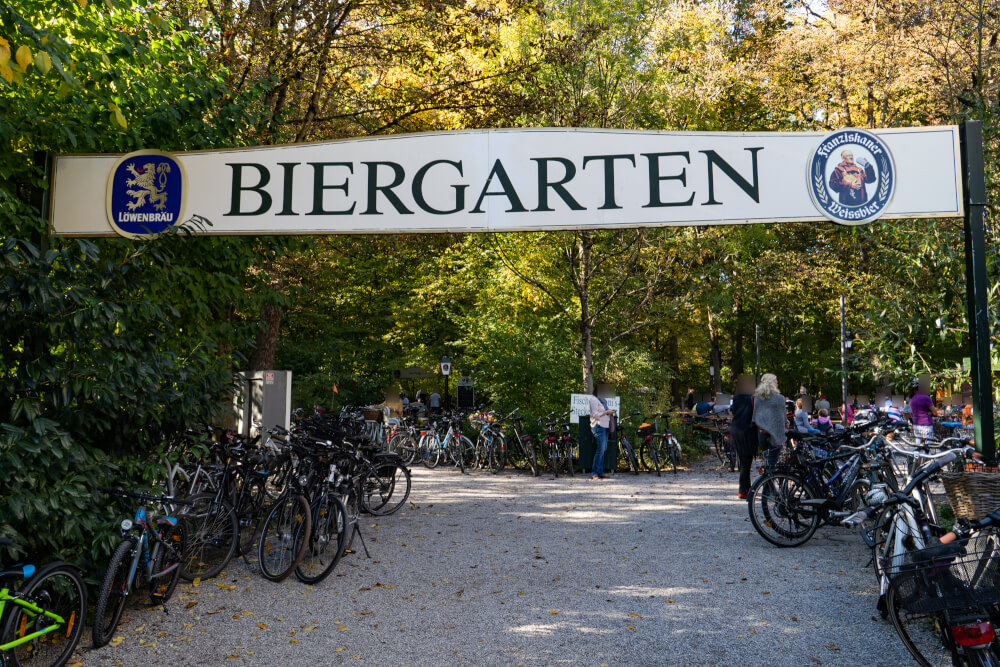
13. Most beer gardens are self-service
On the topic of beer gardens, you should know that beer gardens are mostly self service, so in most cases you’d walk in, grab your own beer, grab your own food, and then pay at the Kasse (or cashiers).
When in doubt, just observe what others seem to be doing.
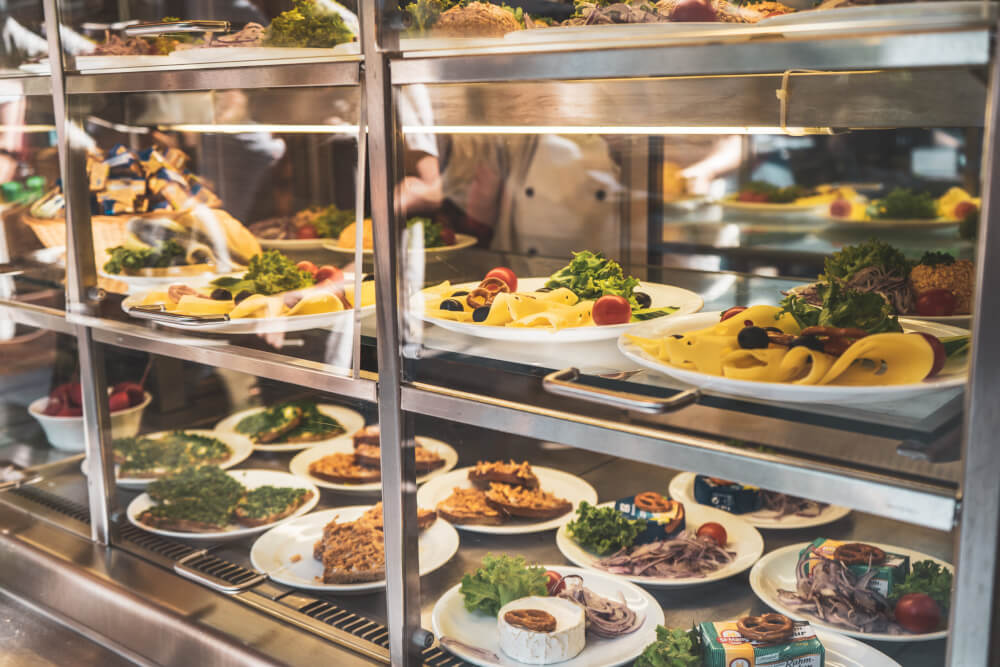
14. Beware that you must often pay a deposit for glassware
When visiting beer gardens or Christmas markets, first-time visitors are often surprised that their total bill is more than they anticipated.
This is more often than not due to the Pfand (or deposit) that they charge on glasses, which is an additional charge that you get back when you return them.
PS: If you are given a special coin or token when buying your refreshments, be sure to hang onto them because they must be returned with your glassware to get your deposit back.
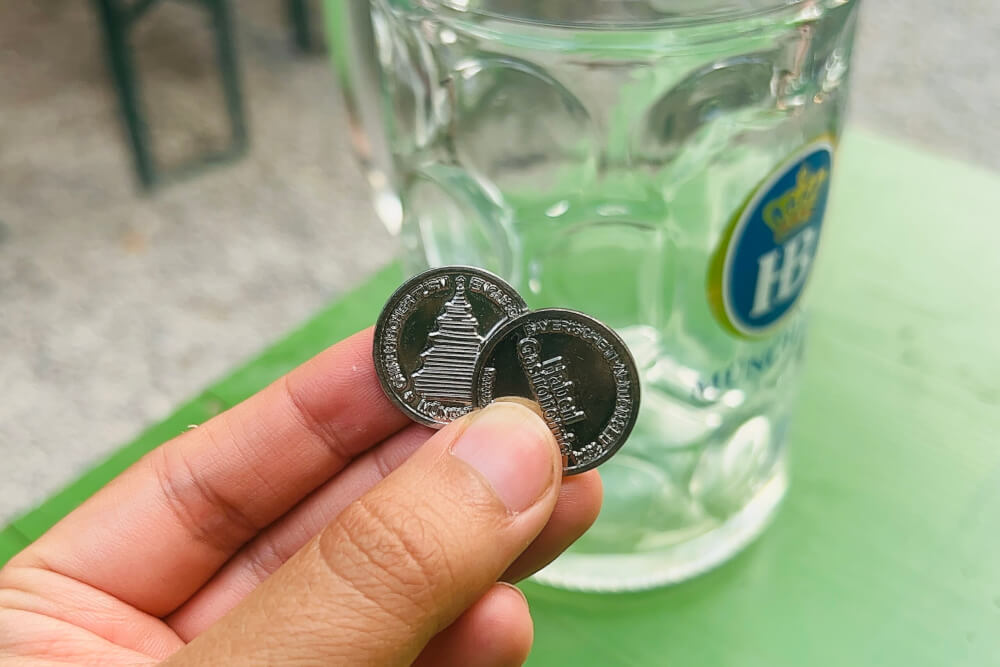
15. Familiarize yourself with Bavarian must-eats
Now let’s move onto one of my favourite topics… food !
Sadly, if I were to talk about all the best foods to try in Munich, this post would take you a decade to read, so for the sake of your attention span, I’ll be highlighting just my top choices below.
Schweinebraten or Schweinshaxe (Roast pork): Schweinshaxe is the more famous giant pork knuckle, but I personally prefer the Schweinebraten which is tender pork shoulder that usually comes with less skin. Whichever you choose, it has to be wolfed down with a potato dumpling (Knödel) and beer gravy.
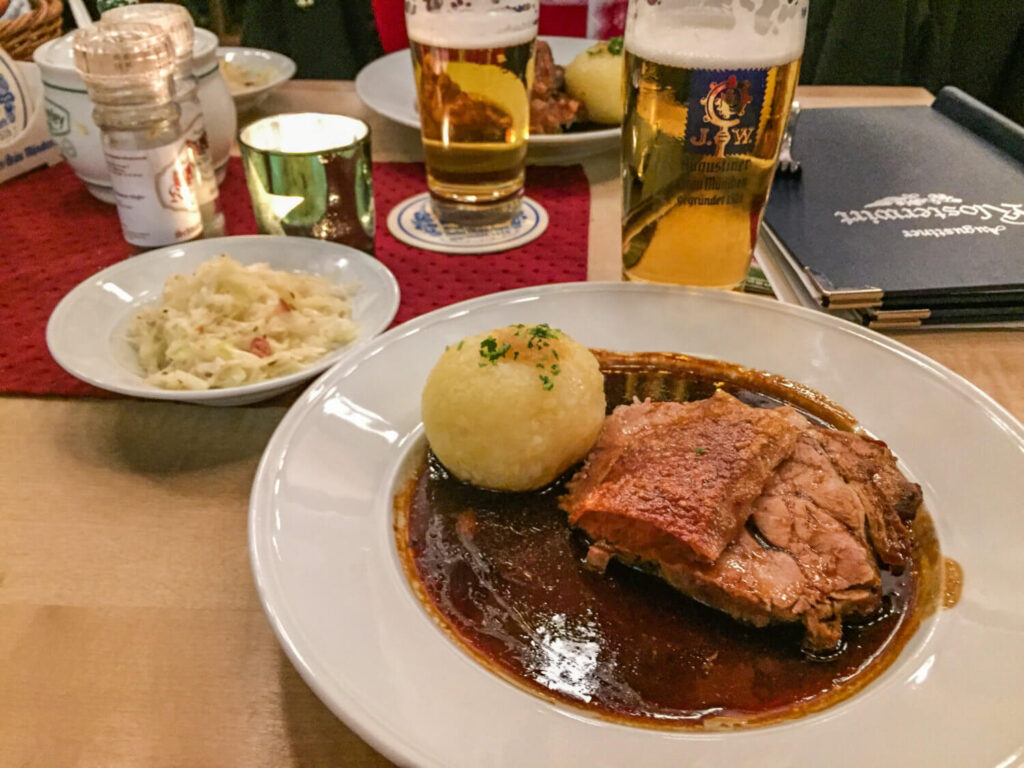
Obatzda: A delicious Bavarian dip that’s available at most beer gardens and beer halls. Made up of soft cheese, butter and various seasonings, this creamy orangey mound of heaven is best enjoyed with a giant doughy pretzel.

Hendl (Roast chicken): A rather self-explanatory specialty, but an important one consisting of perfectly roasted chicken. This is the best meal after you’ve had a few beers.
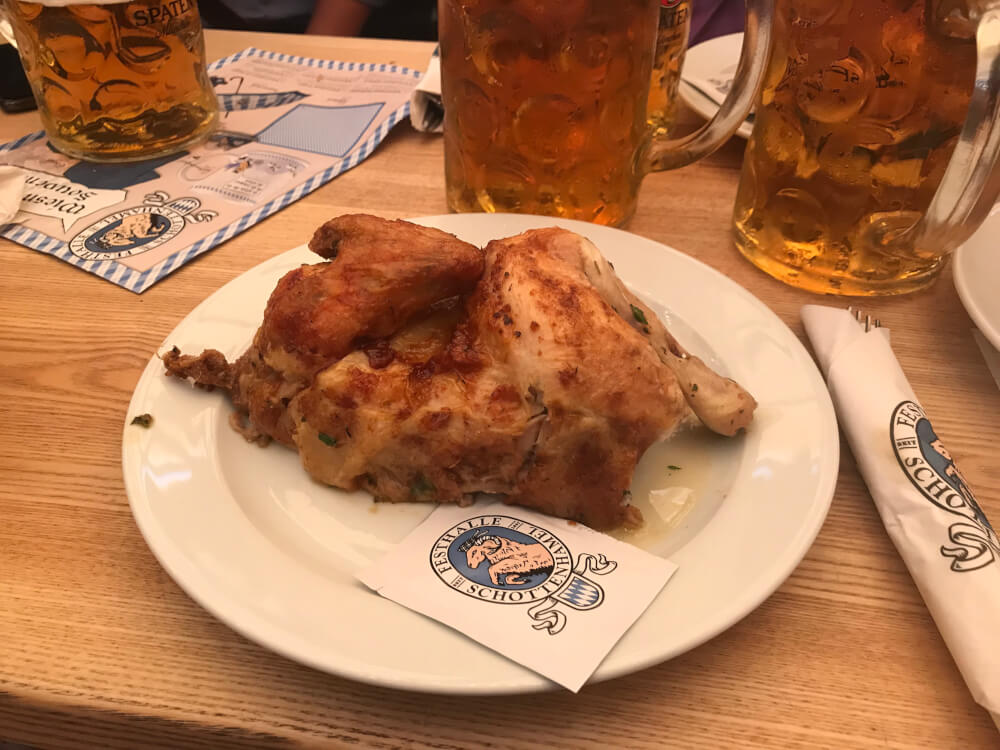
Käsespätzle : Bouncy little noodles served with melted cheese and crispy onion. SO good, and one of the best vegetarian-friendly Bavarian foods to try in Munich.
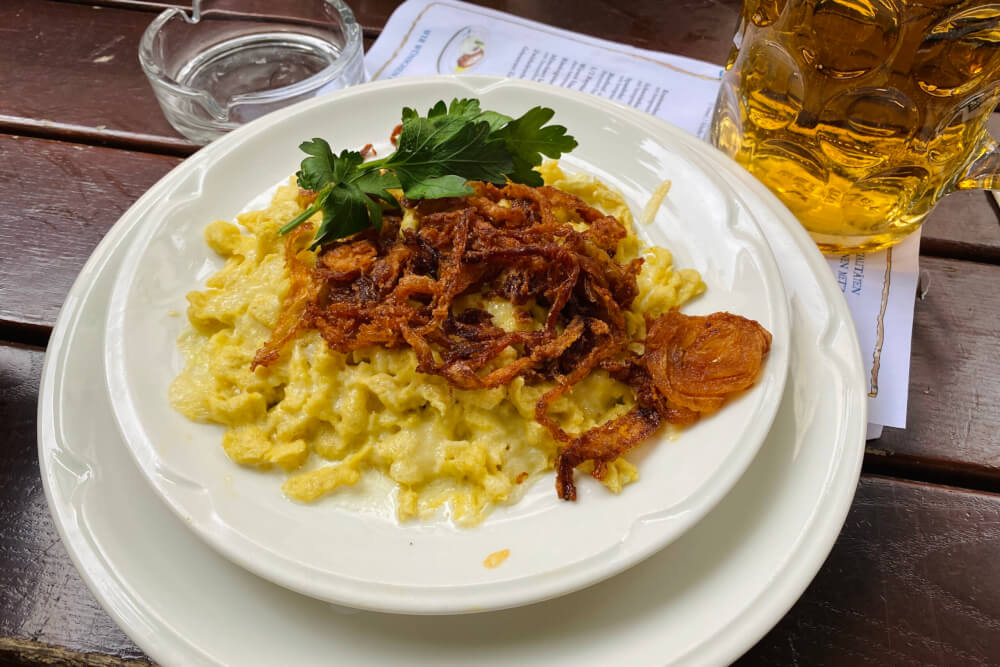
Kaiserschmarrn: A torn pancake dessert topped with sugar and served with jam or apple sauce.
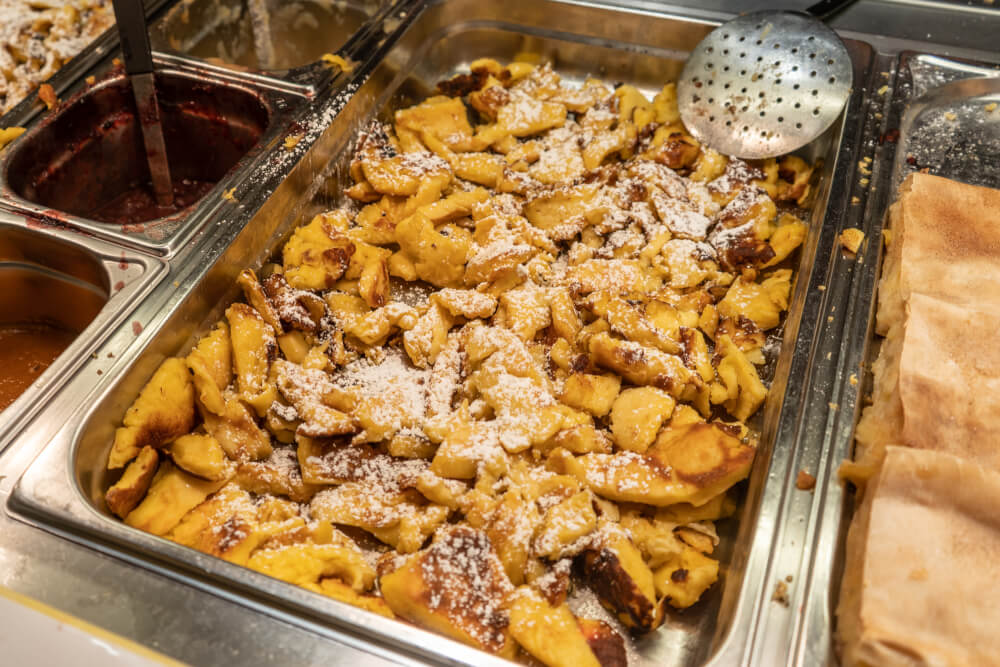
Dampfnudel: A steamed dumpling served in a pool of vanilla sauce.
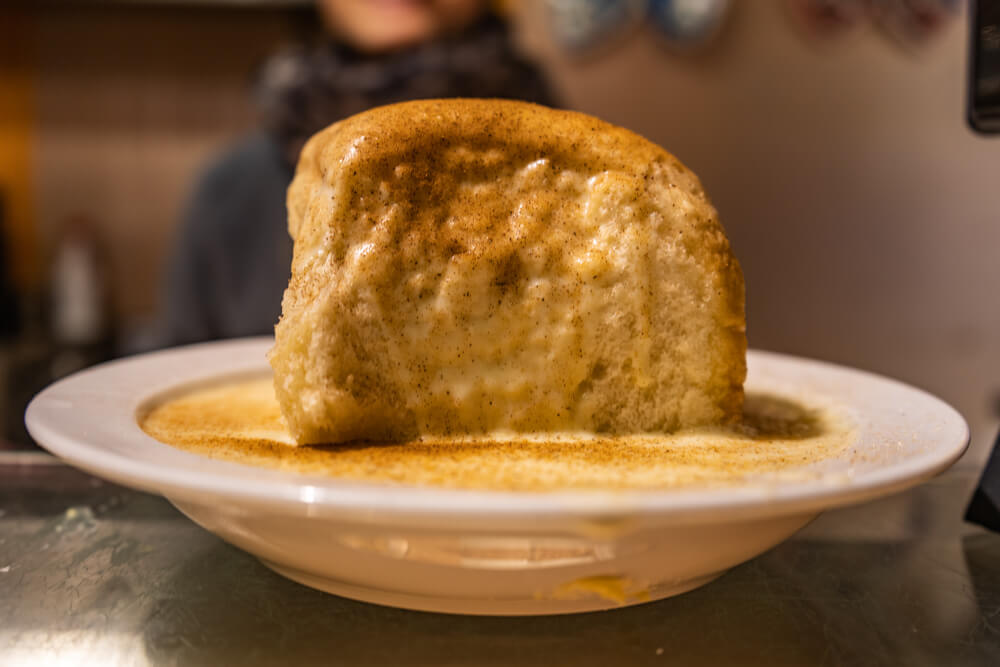
Bavarian breakfast: Involves Weißwurst (white sausage) with sweet mustard, a pretzel and wheat beer. Don’t knock it until you’ve tried it !
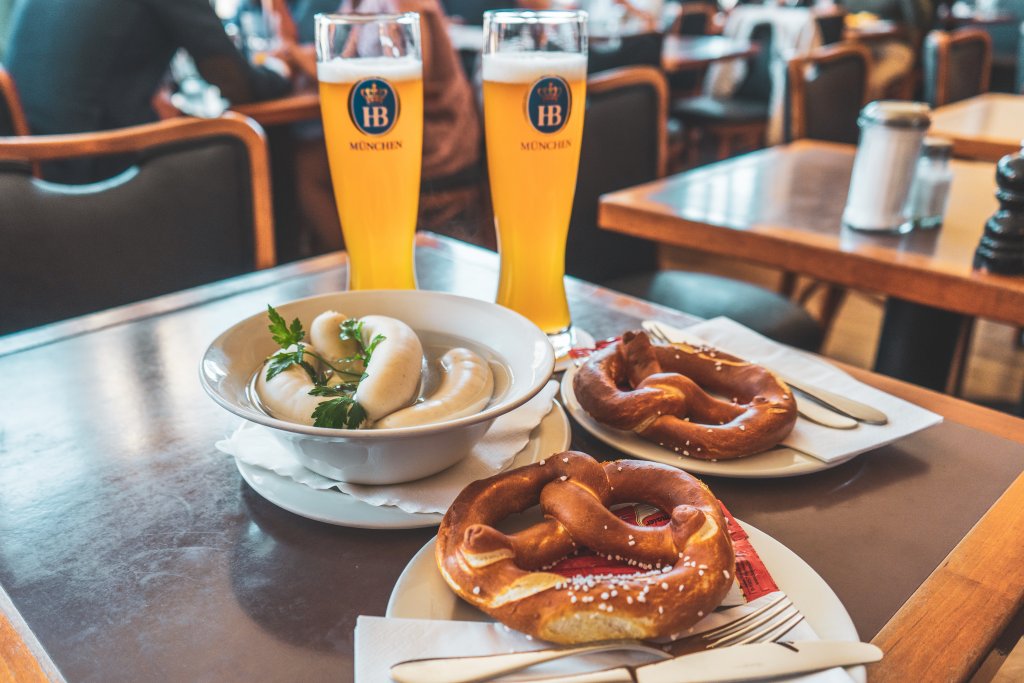
16. Don’t forget to peel your Weißwurst
On that note, one of my most important Munich tips is to peel your Weißwurst and eat it properly. I shudder to think of all the poor souls who have fallen victim to this confusing trap over the years.
When it comes to Weißwurst, do not… I repeat DO NOT eat the skin.
Make an incision down the middle, peel it off, then dip the questionable-looking (but tasty) contents into a pool of sweet mustard. It’s honestly amazing, so long as you eat it properly.

17. Do NOT eat the gingerbread hearts
Speaking of silly Munich food mistakes to avoid: do not under any circumstance eat the adorable gingerbread heart cookies you see on display all over the city.
They are not meant to be eaten and are more decorative souvenirs than anything else. Bite into one and you may well break a tooth (or at least suffer with a mouthful of crumbly sadness). You’ve been warned.

18. Try beer from each of Munich’s ‘big six’ breweries
Now, let’s move onto my second favourite topic: beer!
Unsurprisingly, the beer in Munich is fantastic and you won’t regret trying it. Brewed according to a 500 year old purity law that dictates beer may only be made of water, hops, barley and yeast, the beer here is consistently and dangerously drinkable.
There are 6 main breweries in Munich that brew beer within city limits. These are the only ones allowed to be served at Oktoberfest, and are generally speaking the main ones served at restaurants and beer halls across the city.
Unlike bars or restaurants in North America, most places here only serve beer from one brewery, which makes choosing easy. You say if you want a Helles (a light beer), a Dunkel (a dark beer) or a Weißbier (wheat beer) and they’ll bring you what they have.
It is rare that you’ll be able to pick from multiple breweries when you order, unless you’re going for wheat beer or something different, so take note of which brewery that restaurant or beer hall serves when you walk in by looking for signs like these hanging from the outside:

Trying a beer from each of the Big Six is a fun goal to have in Munich, but my personal favourite (and kind of the locals’ go-to) is Augustiner. It’s rarely exported so be sure to try it while you can!

19. Try some classic Munich soft drinks too
If you’re not into beer, then don’t worry, wine and soft drinks are also common.
The go-to soft drink in Munich is either an Apfelschorle which is half apple juice half sparkling water or a Spezi which is half cola and half orange soda. Both are delicious.
Besides Apfelschorle (which is made with apple juice), there’s a whole wide world of Schorle options, which pair sparkling water with different juices to make a spritzer. If you’re looking for a refreshing non-alcoholic beverage to enjoy while exploring Munich, make sure to test a few Schorle – they’re the best!
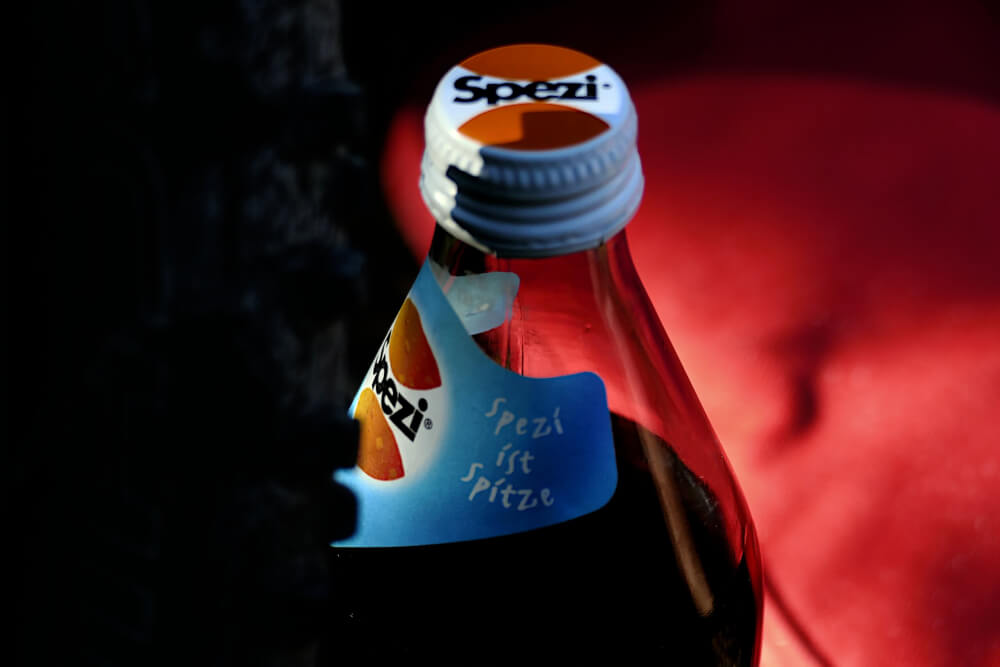
20. Steal my Munich restaurant recommendations for tourists
Now I know many of you will be wanting specific food recommendations and restaurants for Munich, and I do have a full list of the best Munich restaurants for tourists here , but here are some quick recommendations broken down by cuisine:
- Bavarian: Augustiner Klosterwirt – a great Bavarian beer hall type place with speedy service and delicious food
- Italian: L’Osteria – giant pizzas for an affordable price, with many locations around the city
- Ice Cream: Der Verrückte Eismacher – a legendary ice cream spot with very unique flavours including Augustiner beer and a rotation of strange ones like Döner Kebab or Sauerkraut. Definitely worth a sample (don’t worry – their main flavours are good too!)
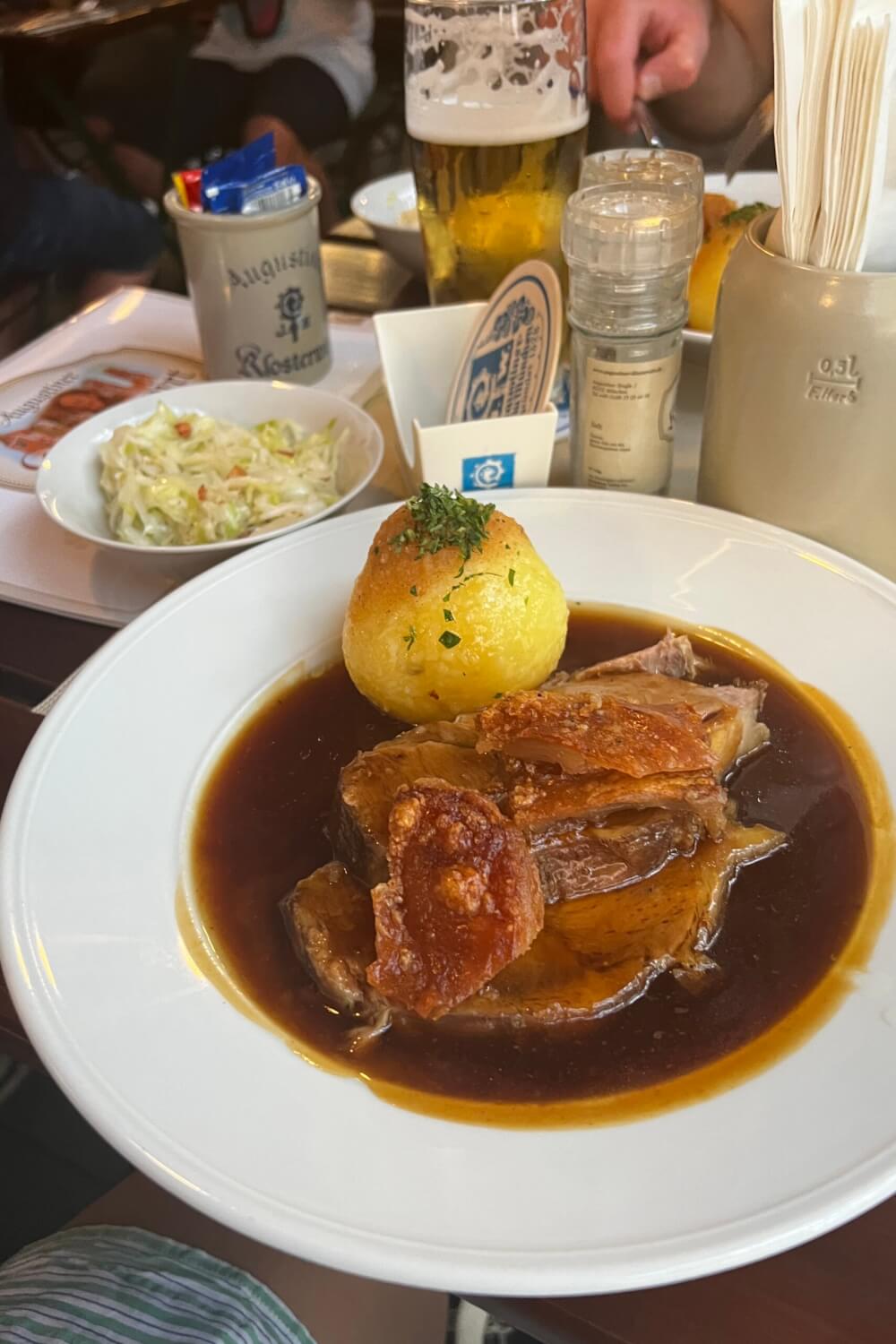
21. Take advantage of 1 euro museums on Sundays
One of my best money-saving tips for Munich is hands down the amazing fact that many of the city’s top museums offer 1 euro entry on Sundays.
So, if you time your visit for a Sunday, definitely take advantage of this. It’s such a cheap way to get some culture in, plus many of the museums are located close together so you can easily visit multiple in day.
If you’re looking for museums to visit, Maxvorstadt is THE neighbourhood to run to, with several amazing museums to choose from.
Of course, go to the ones that align with your interests but my personal favourite art museum is the Pinakothek Moderne (which focuses on modern art) and if you are interested in history, you’ll also find the NS Documentation Center in this area, which details the rise and fall of the Nazi Party which of course saw its start right here in Munich.
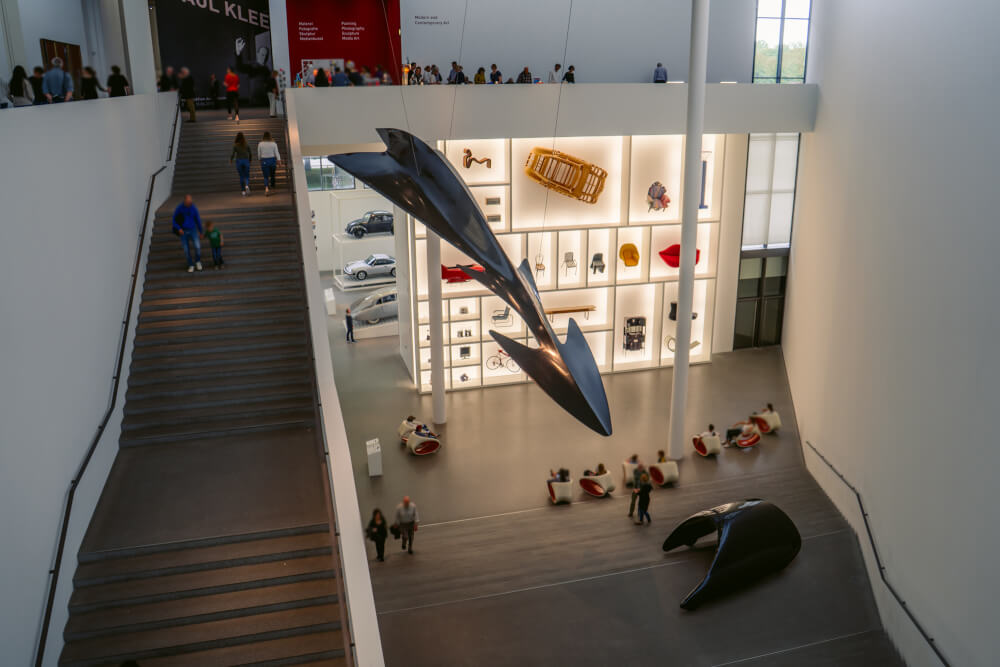
22. Consider a pass from the Bavarian Palaces Administration
Now if you’re really into castles and palaces, it may be worth buying a pass from the Bavarian Palaces Administration.
This one pass includes admission to over 30 palaces and castles across Bavaria, including big names like Neuschwanstein Castle , the Munich Residenz, and Herrenchiemsee.
Their annual pass is only €50 which is honestly a bargain if you visit multiple palaces. For most visitors however, the 14 day pass (€35) might make more sense.
They also have a €31 pass that covers Neuschwanstein, Linderhof and Herrenchiemsee.
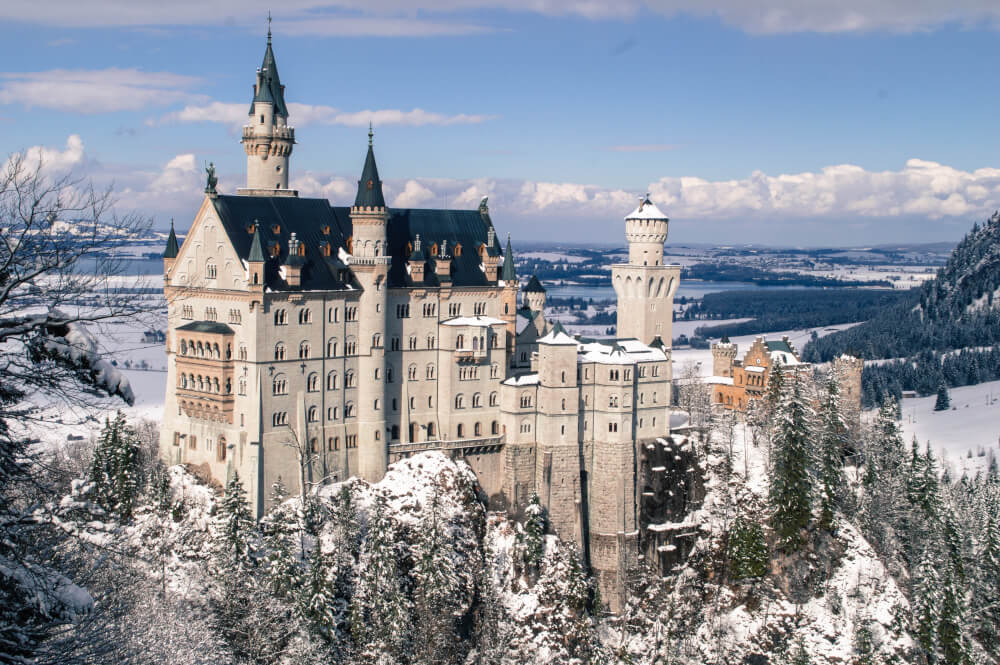
23. (Maybe) Consider a Munich Card or Munich City Pass
In terms of other sightseeing cards, the two main ones within Munich are the Munich Card and the Munich City Pass.
Despite their confusing name similarity, the cards are actually quite different.
In summary, the Munich Card is a cheaper card you buy that gets you discounts on attractions, whereas the Munich City Pass is a pricier card that includes entry to a bunch of attractions for one set price.
Are these cards worth it? I personally don’t think so unless you are planning to visit many museums and attractions at full price. Given that so many of the included attractions are only 1 euro on Sundays, there are definitely more cost-effective ways to see them.
But hey, if your trip doesn’t coincide with a Sunday and you plan to do a lot of the paid attractions included, then it can save you some money. Just make sure you do the math first to ensure you actually save!

24. Don’t miss Munich’s best hidden gems
Beyond Munich’s big paid attractions, there are a number of cool ‘hidden gems’ that many first-time visitors miss. Some are of course more well known than others these days, but here are a few to have on your radar just in case.
Neues Rathaus: This is the most photographed building in Munich, but few people realize they actually do public tours which include a visit the AMAZING Law Library, which is hands down one of the most beautiful libraries in the world.
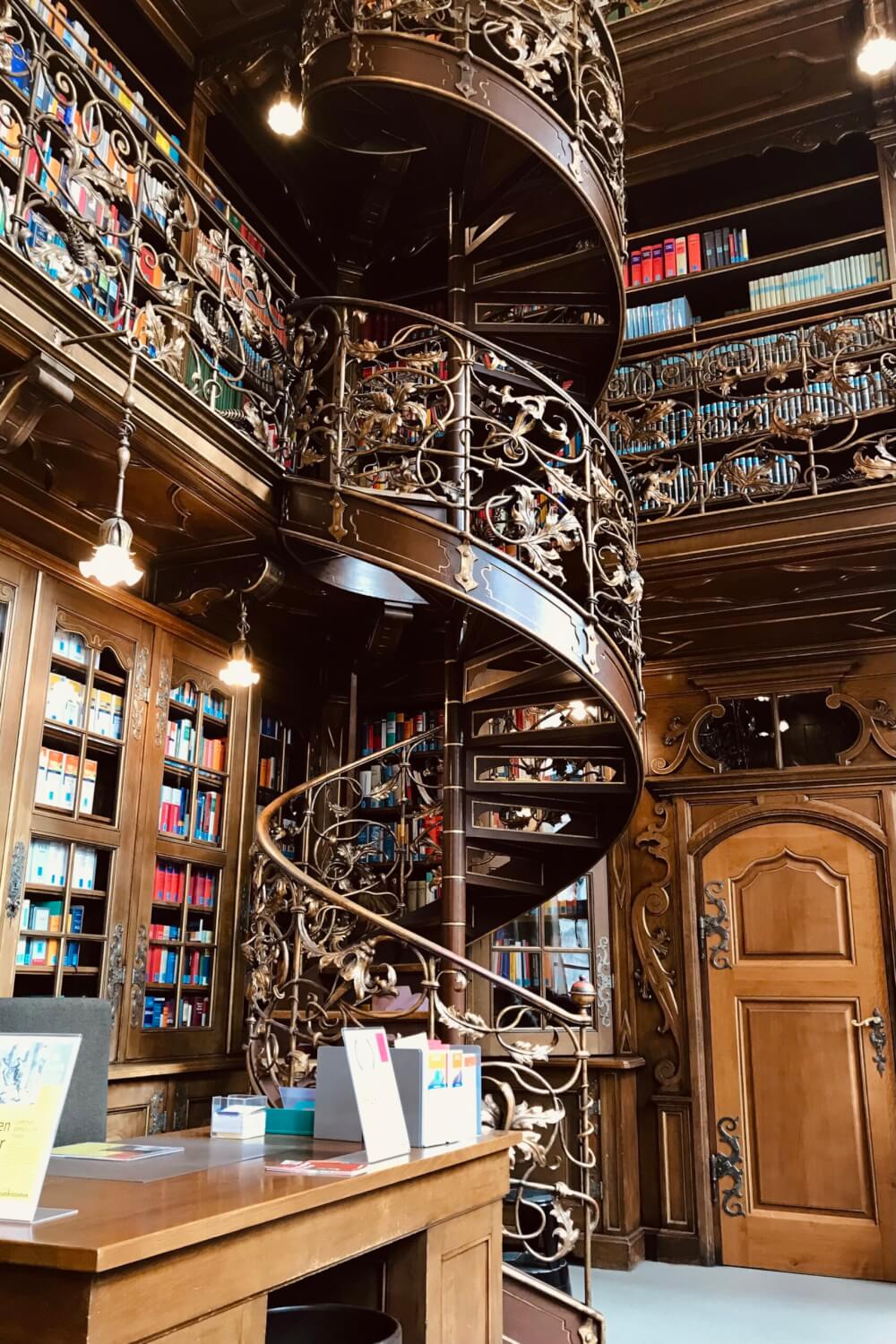
Justizpalast: Near Stachus, AKA Karlsplatz, there’s the Justizpalast which in my opinion is one of the prettiest interiors in Munich. It’s free to visit, you just need to pass an airport style security check and before long, you’re inside drooling over the magical interiors which look like this:
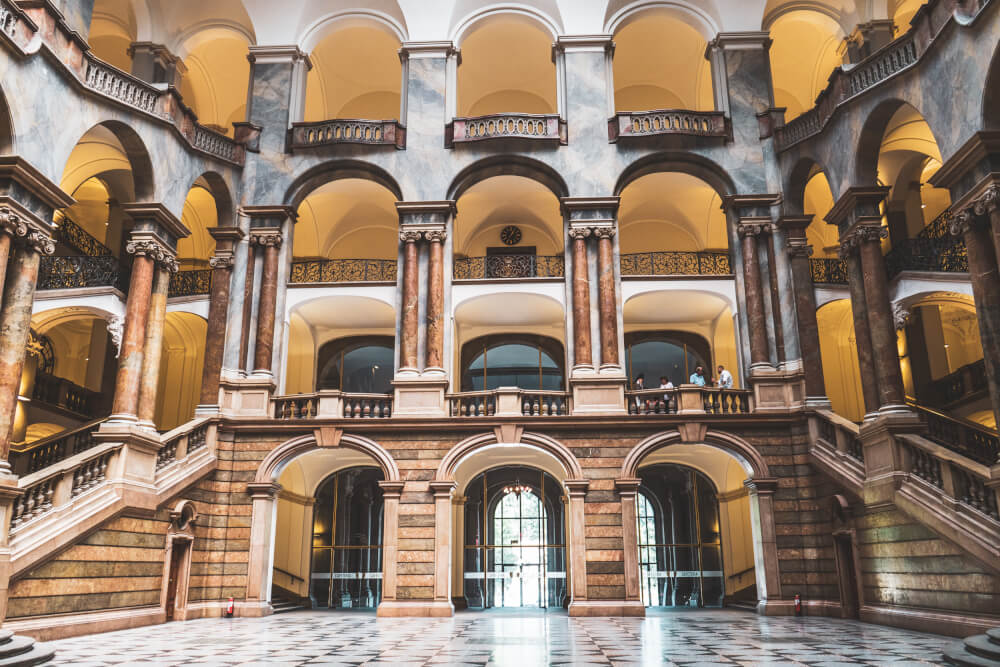
Asamkirche: This stunning little church near Sendlinger Tor is hardly a secret these days, but many visitors still pass by without taking a look inside, which is a huge shame because it looks like this:
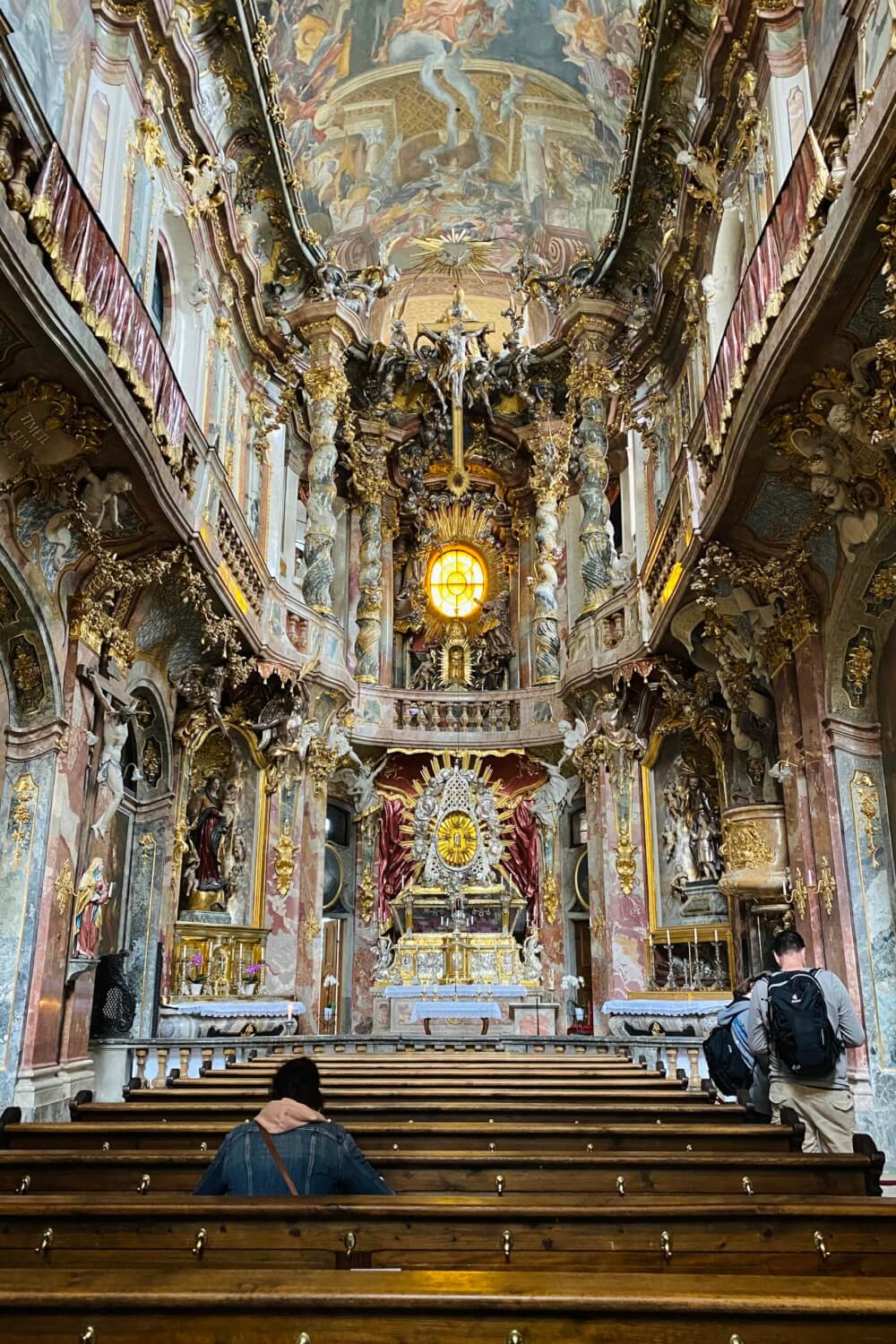
St Michael’s Church: This beauty is often overlooked because it’s surrounded by so many shops like Sportchek or TK Maxx, but the inside is well worth a visit, especially if you’re morbidly curious and want to see the crypt inside which houses some of the most famous names in Bavarian royal history like King Ludwig II, the guy responsible for Bavaria’s most famous fairytale castles.
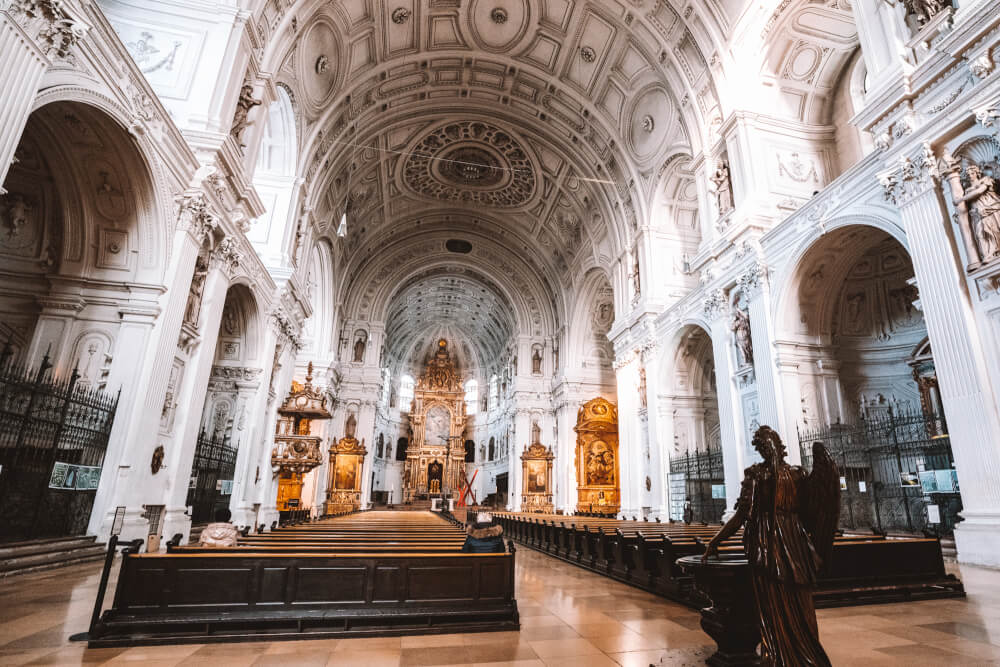
Olympiadorf: One of the most unique student accommodations in the world, featuring bungalows repurposed from Olympic athlete lodgings from the 1972 Olympics. The houses have since been re-painted by the students living there, making each individual place different. Biased side note: this was my first home in Munich and you can head to Bungalow L4 to admire my handiwork. Spoiler – it’s Lion King themed.
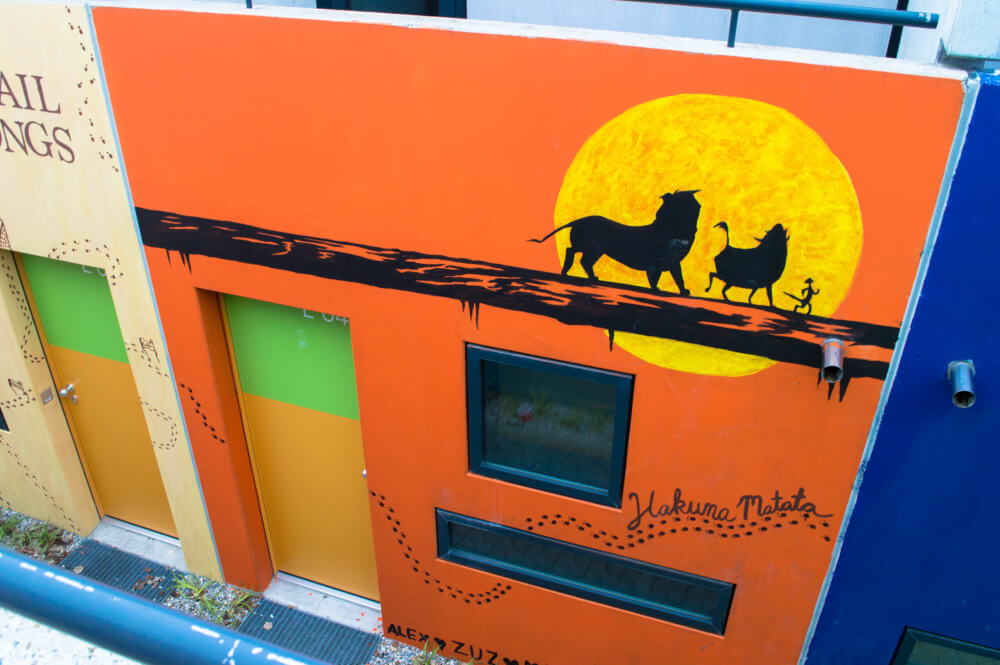
25. Explore Munich’s alternative side
I know that Munich and ‘alternative’ aren’t words that tend to go together, but there is a cool alternative side to Munich that most visitors miss.
So, if you want to discover some of it, here are some places to put on your radar:
- Werksviertel-Mitte: A cool area behind Ostbahnhof train station with lots of cool murals and unique small businesses housed in shipping containers.
- Bahnwärter Thiel: A hip hang out spot that hosts various parties and events, with different bars scattered across a large venue decorated with repurposed shipping containers and structures.
- MS Utting: Literally an old boat perched on a bridge that is now a hangout spot where you can get food and drink, plus they host fun events like a Christmas market every year.
Lastly, if you’re into street art, there are also big murals to admire all around the city, including around Hauptbahnhof, Giesing, Westend and in some tunnels along the Isar. Here’s a list of places to go street art hunting in Munich.
So, yeah… take that Berlin. We’ve got cool stuff too.

26. Enjoy Munich’s many amazing green spaces
One of the best things about Munich is its abundance of lush green space, so make sure you take advantage of it while you’re in town.
The English Garden is already well known as one of the top must-dos in the city, but there are many others scattered around the city with far fewer crowds and just as much beauty, like…
- Olympiapark: Not a hidden gem by any means, but a really cool park to visit with lots of modern structures and attractions
- Westpark: A pretty park on the west side of the city that’s home to a beautiful Japanese and Chinese Garden
- Nymphenburg Palace Park : A sprawling royal estate filled with unique attractions including a palace and botanical garden

27. Seek out alternative viewpoints
One of the most popular things to do in Munich is climbing up St Peter’s for a view over Marienplatz, but there are plenty of other nice views that don’t get nearly as much love.
Here are some I’d recommend:
- Neues Rathaus: A nice view over Marienplatz that has an ELEVATOR which means you don’t need to climb. My favourite lazy view in town!
- Frauenkirche: This view has only recently re-opened after 10 years of restorations. It’s an incredible panoramic view over the city that combines some steps with an elevator. Great if you want to see what it’s like inside one of the city’s most iconic structures!
- Olympiatower: Amazing views over the Olympic Park, accessible by elevator.
- Olympiaberg: A free alternative to the Olympiatower, with amazing views that’s especially nice at sunset.
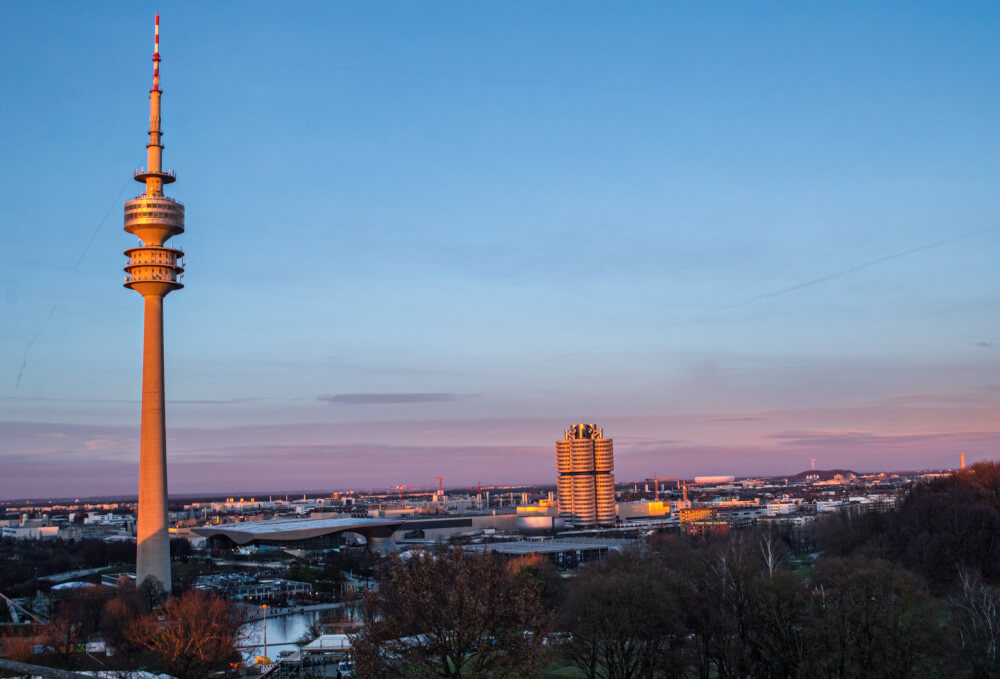
28. Explore more beer halls than just Hofbräuhaus
And speaking of breaking away from the usual must-dos, another key Munich tip is that Hofbräuhaus isn’t the only fun beer hall in town.
In fact, every big brewery in Munich has their own beer hall (if not multiple) so don’t limit yourself to just visiting this one!
I’m a big fan of the Augustiner Stammhaus:
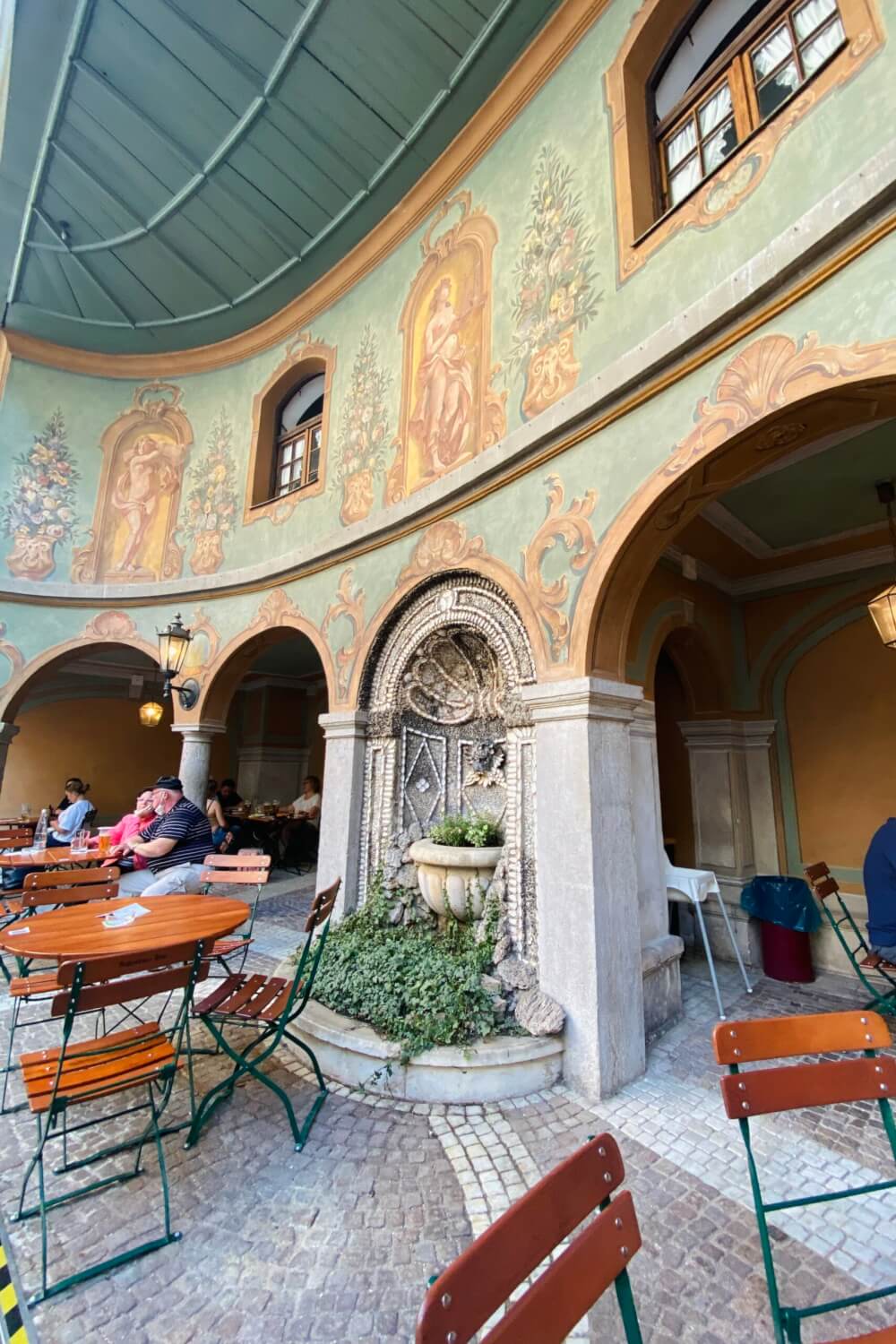
29. Don’t get your hopes up for the Glockenspiel
And to cap off my attraction-related Munich tips, I’m going to indulge in a bit of Glockenspiel slander.
Despite being advertised as one of the top things to do in Munich, the Glockenspiel performance in Marienplatz is honestly not that exciting so don’t get your hopes up too much.
NOTE: If you definitely want to see this performance but can’t be bothered to wait among the tourist mobs, one of the best places to watch it is from Café Glockenspiel if you can manage to get a table by the window.
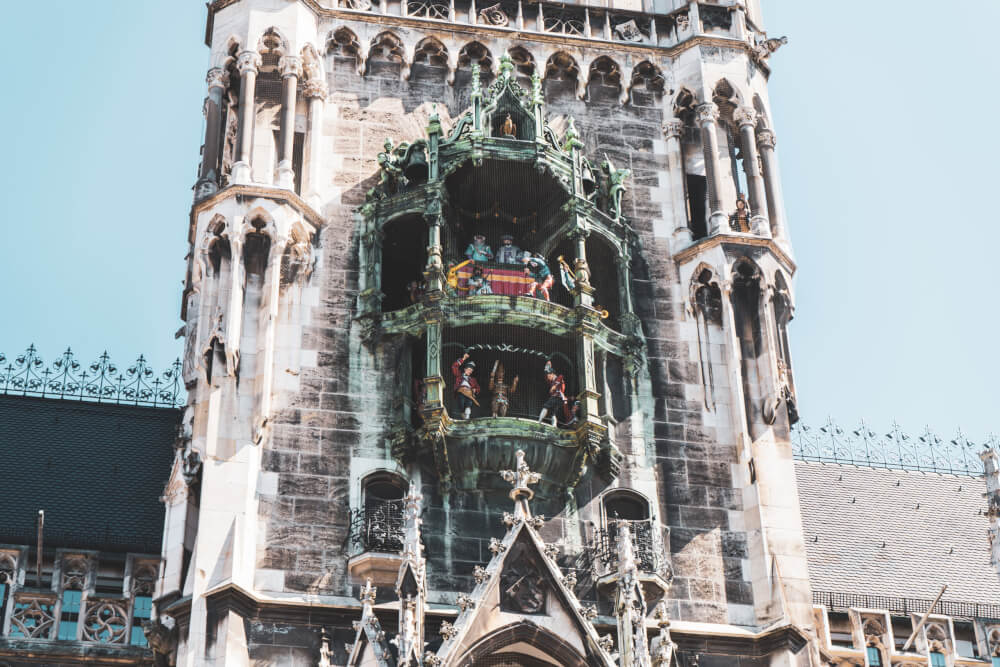
30. Remember: Munich is in Bavaria
Alright, now onto some culture and etiquette tips for Munich.
The first is to remember that Munich is the capital of Bavaria, and locals (known as Bavarians) are very proud of this fact.
Given that Bavaria was its own kingdom up until 1871 when it joined the German Empire, the culture here is considered by many to be distinct from the rest of the country, so when asking questions or speaking about local customs, be sure to specify ‘Bavarian’ rather than German, as some locals can be picky about this fact!
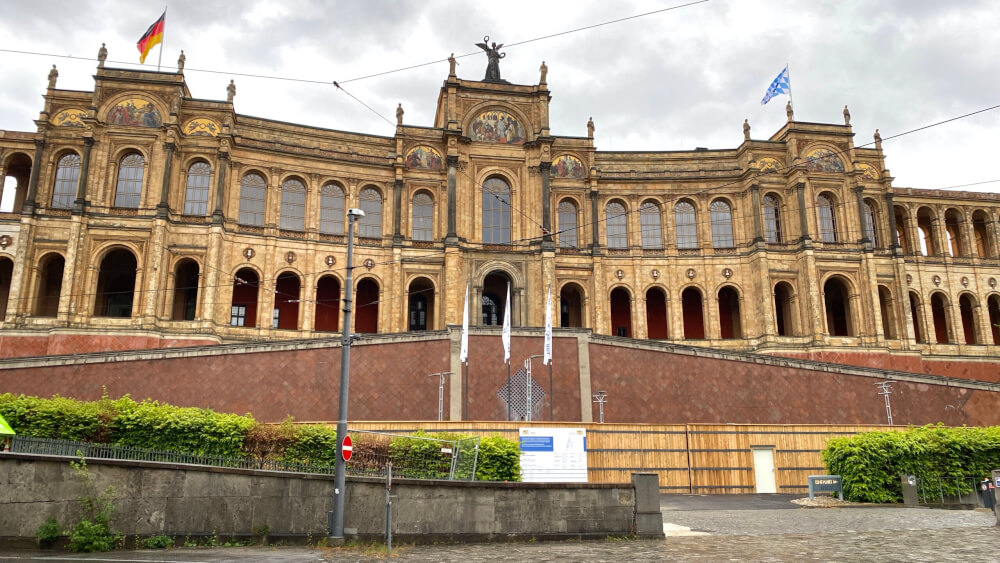
31. Bavarians have their own language but you won’t encounter it much in Munich
Alongside its unique cultural customs, Bavarians do also have their own unique language: Bavarian (or Bayrisch).
But before you panic about learning it for your trip, do know that you won’t find many people speaking Bayrisch in Munich.
As a tourist, you may encounter it on a few signs and menus here and there (Minga for instance is ‘Munich’ in Bayrisch), but generally speaking you’ll get by fine with basic German and of course English.
Now, venture out into the countryside and that may be a different story…

32. Learn some language basics before your visit
Of course, when you come to Munich, a bit of effort should be made to learn some basics in terms of the local language.
While you’ll get by fine with English in most touristy establishments, being able to say hello or thank you is a must, so commit the following phrases to memory:
- Hello (for any time of day): Servus or Grüß gott
- Thank you: Danke or Danke schön
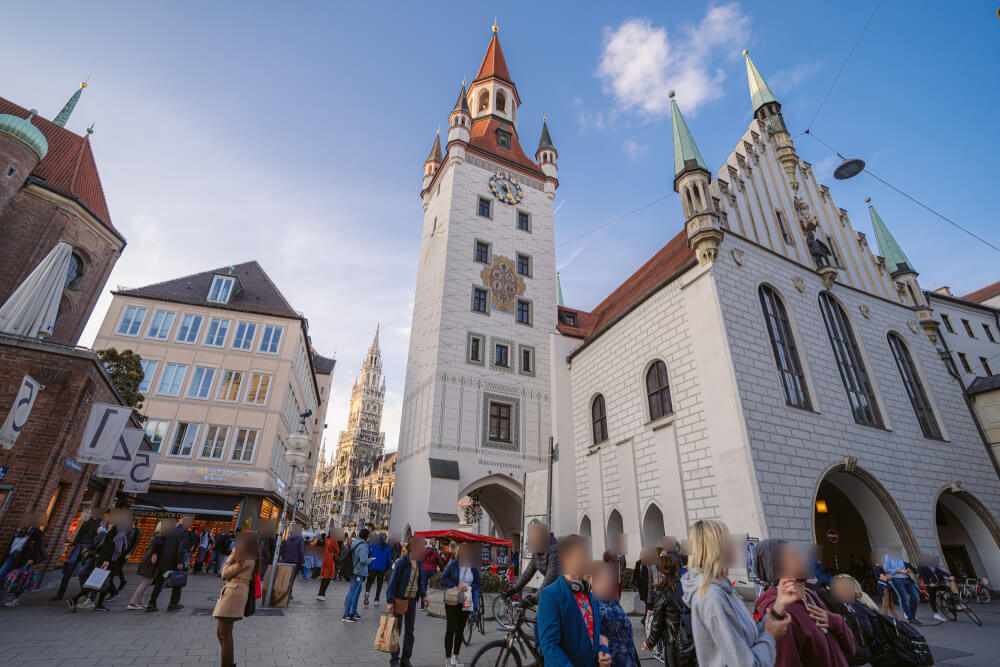
33. Don’t make fun of Lederhosen and Dirndls
Now, another important Munich etiquette tip is to not make fun of Lederhosen and Dirndls, otherwise known as Trachten (traditional clothing).
While the idea of leather pants may seem funny to you, these garments are actually Bavarian traditional dress, often worn for special occasions like weddings, church, and special festivals (as you may have seen at Oktoberfest).
So, remember: making fun of or wearing cheap versions of Trachten can be seen as rude or offensive to locals (though you’ll find the spectrum of caring is vast and varied).

34. Don’t take staring personally
Another important Munich tip: don’t be freaked out if people seem to be staring at you.
Culturally, Bavarians do not find it rude to stare at strangers. This is why they often won’t even look away when you stare right back at them.
This was a cultural quirk that I never adjusted to even after five years in the city, so let me warn you now: you will probably get stared at a lot in Munich.
Don’t let it ruin your trip though! Because they consider it no different than taking a glance to observe you, they do it to everyone, even each other.
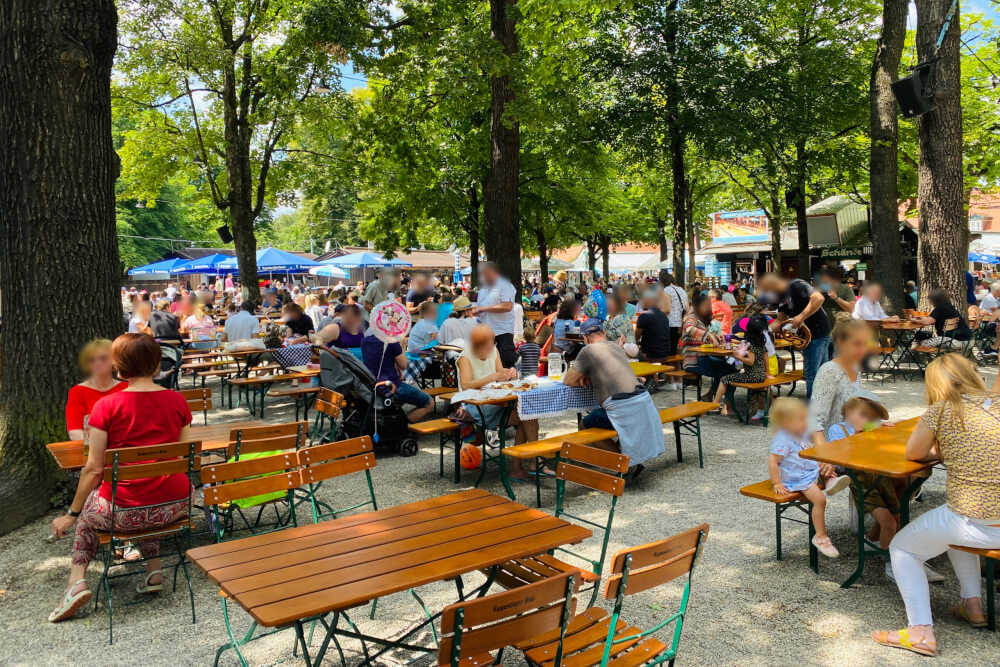
35. Do not jaywalk in Munich
Another cultural must-know to be mindful of in Munich is that Bavarians do not jaywalk for the most part, especially around children.
Unlike other parts of the world where jaywalking generally goes unpunished, it actually is policed here, both by actual police (who will happily issue you a fine if they catch you) and also by locals who love to point out any wrongdoing.
So, remember, avoid jaywalking unless you enjoy getting scolded by Bavarian Omas.
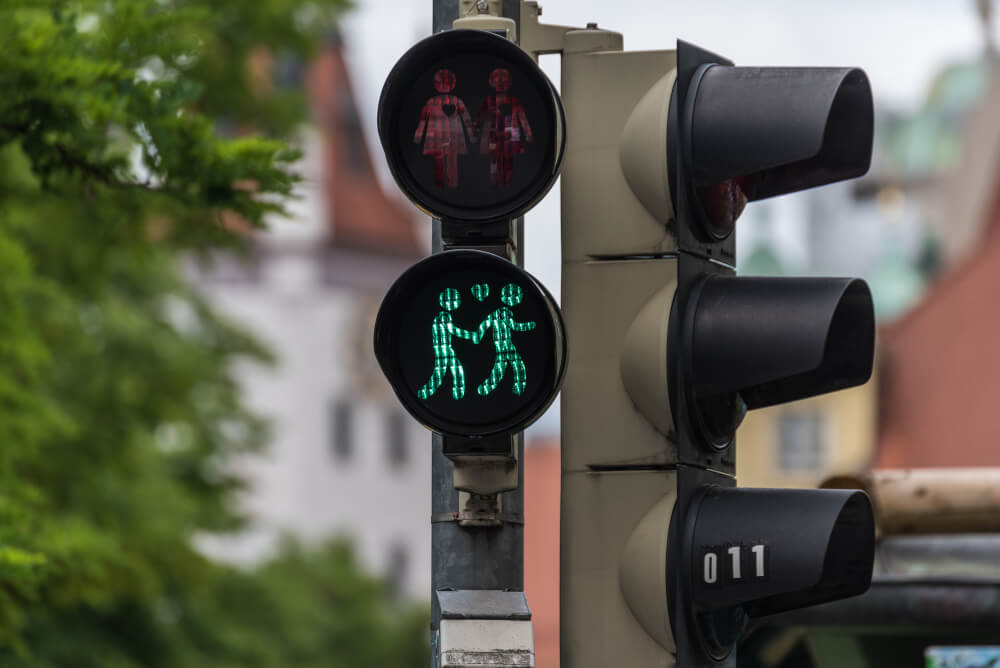
36. Beware of bike lanes in Munich
Munich is one of the safest cities I’ve ever been to, but a key danger that many first time visitors forget about is cyclists aaand bike lanes.
There are bike lanes all over the city that are side by side with pedestrian lanes, making it all too easy to walk into one by accident.
So, be careful, take note of any cycle symbols on the sidewalk and make sure you don’t get mowed down by a bike.
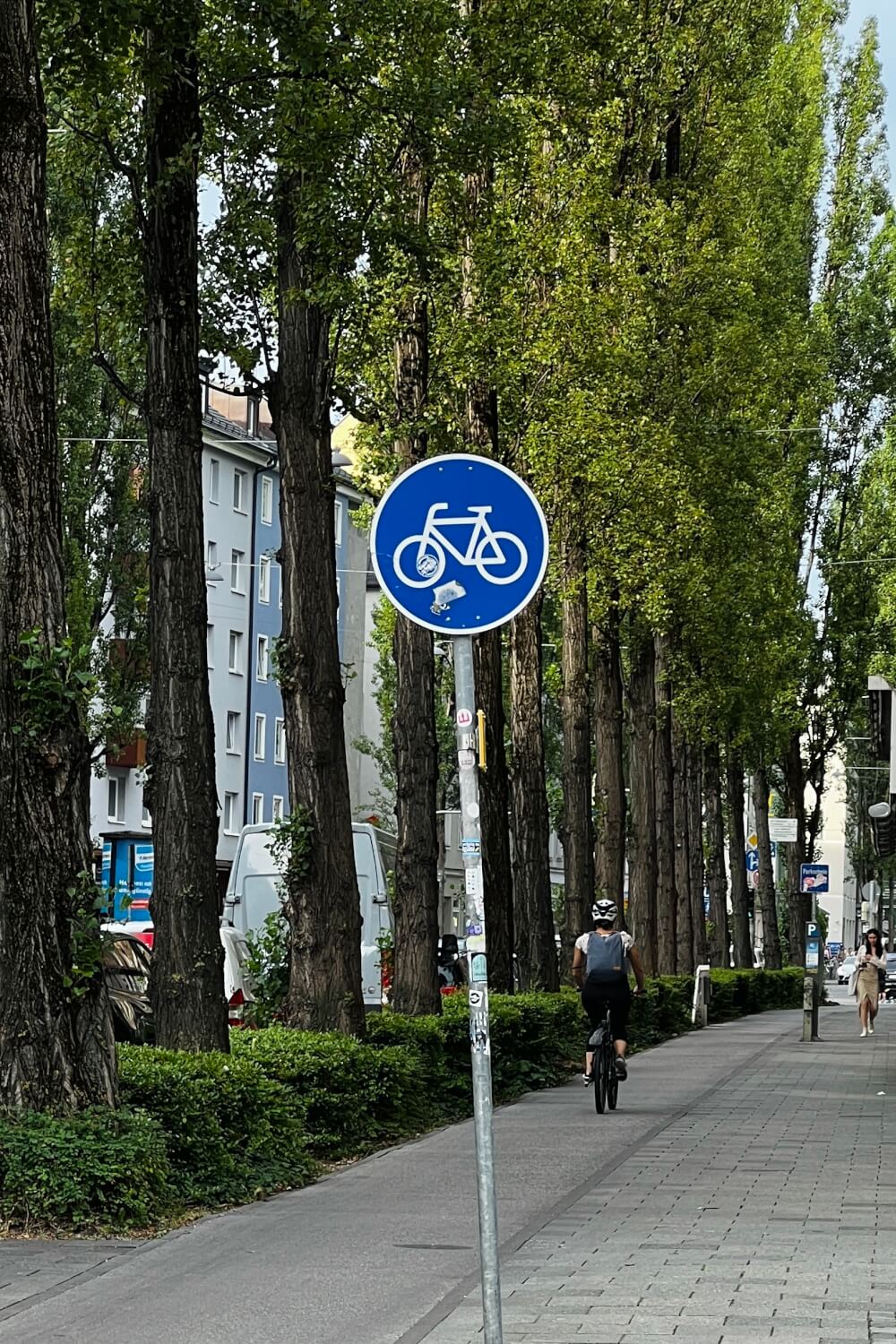
37. Make sure to bring cash and coins wherever you go
As I mention in my Germany travel tips article, while many places do accept card payments these days, cash is still king in many instances, so having small bills and coins on you is a must, especially because you need to…
38. Prepare to pay for bathrooms everywhere
Sadly, you do need to pay for public bathrooms in Munich, even in ordinarily free places like train stations or McDonalds, so having coins for this purpose is handy.
While some of the newer machines will take card, some of the older ones won’t, so having an emergency cash stash is a must.
NOTE: Besides paid toilets that have physical barriers, it’s also considered a norm to tip at many beer gardens and large beer halls, where there are bathroom attendants who keep the area clean. In these cases, it’s generally expected that you leave 50 cents or a euro as tip.
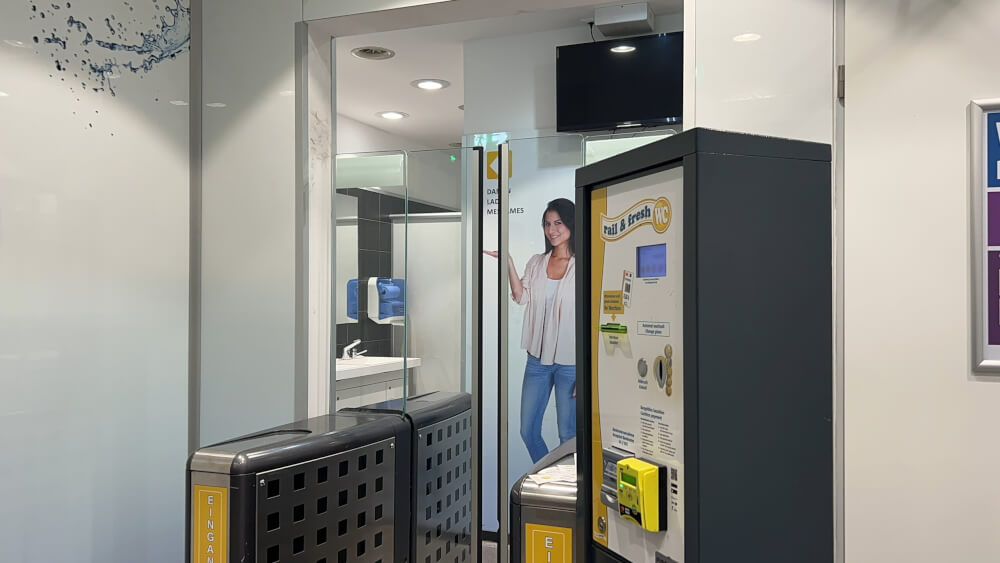
39. Beware that most shops are closed on Sundays
Sundays are a special day in Munich where museums are 1 euro and all shops are….. closed !
Yup – Sundays are generally a day of rest in Germany, so if you need to go shopping or get groceries, do so on any day but Sunday. While restaurants and cafes will still be open, most shops and supermarkets won’t be.
In a pinch though, shops at train stations, gas stations and the airport will still be open.
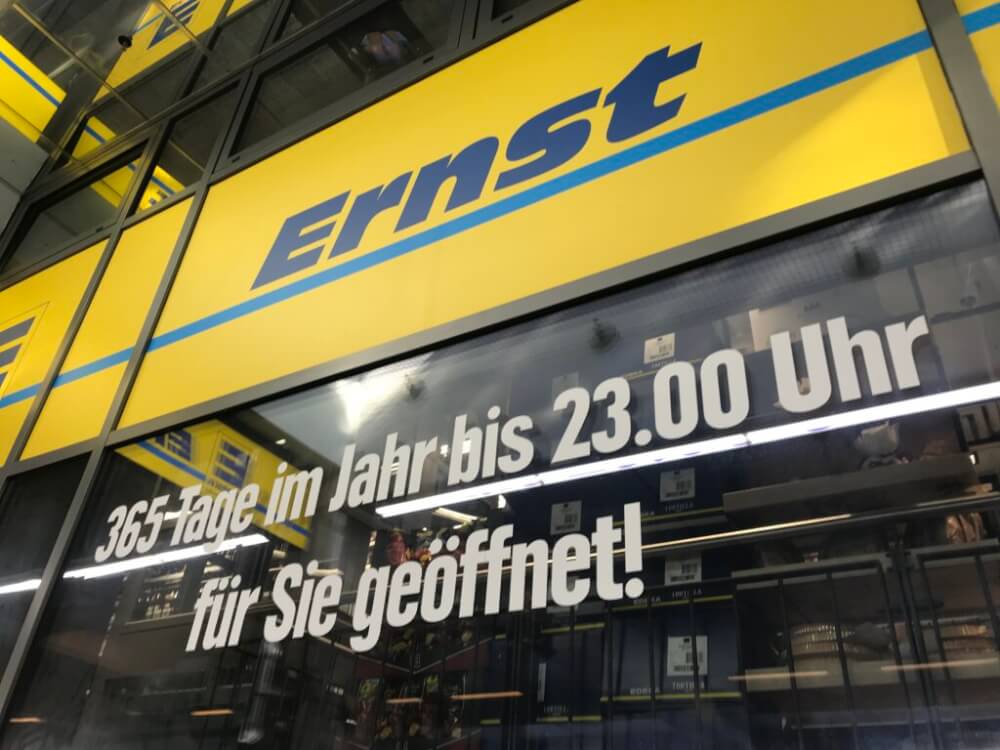
40. Dress for the season, not the weather
Now in terms of what to pack for Munich, here’s a random tip for you: Bavarians tend to dress for the season, rather than the weather. So, even on a hot balmy day in October, locals will be wrapped up in jackets, so if you want to blend in, keep that difference in mind!
At the end of the day though, I say just wear whatever’s comfortable… but be prepared for some additional stares coming your way. I’ve noticed they’re often especially shocked by the sight of bare legs outside of summer time.

41. Keep an eye out for fun, local events
Lastly, remember that there is tons to do in Munich outside of the typical touristy musts.
After all, the city is home to millions of locals, and there are often fun pop-ups and local events to take advantage of.
The Bored in Munich events calendar is a perfect resource for this. They also do weekly event roundups!
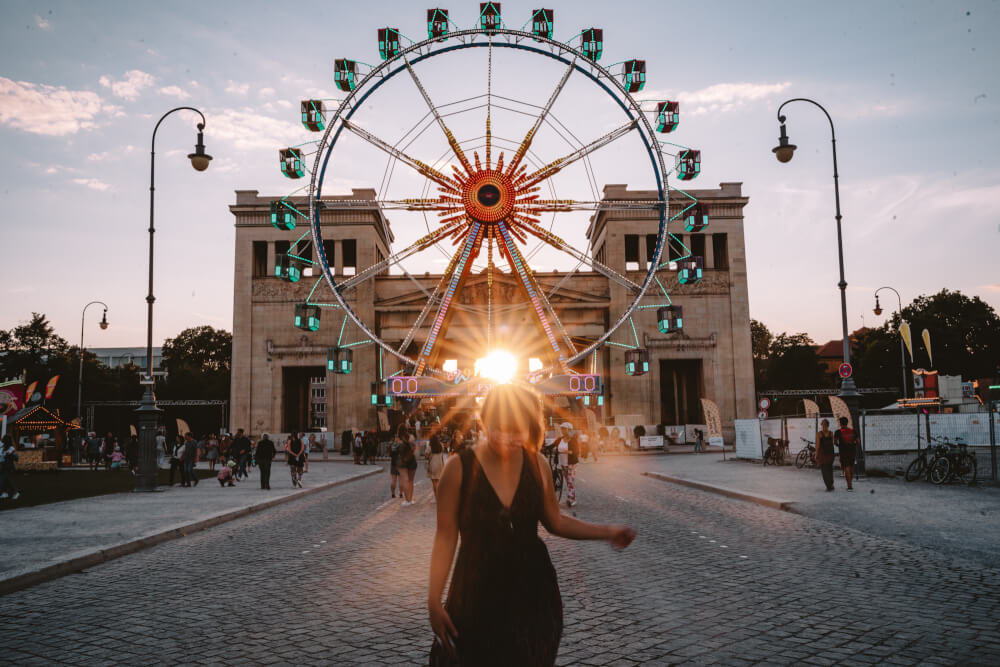
I hope this list of Munich travel tips was helpful!
If you’re here after all those Munich travel tips, congrats – I’m beyond proud of you! Hopefully by now, you’ll feel much more prepared for your big Munich trip, but if you have any more questions, let me know in the comments.
My Go-To Travel Favourites:
🧳 Eagle Creek: My favourite packing cubes
💳 Wise: For FREE travel friendly credit cards
🍯 Airalo: My go-to eSIM
🏨 Booking.com: For searching hotels
📷 Sony A7IV: My (amazing) camera
✈️ Google Flights : For finding flight deals
🌎 WorldNomads: For travel insurance
🎉 GetYourGuide: For booking activities
1 thought on “40+ Munich Travel Tips for First Timers & Must Knows Before You Go”
This is such a fun and interesting post. You have shared your experience and passion for Munich with your post. You have introduced me to some of the coolest things to do and see in Munich, such as admiring the Frauenkirche and joining the Oktoberfest. Your photos and videos are awesome, they show how much you enjoyed Munich.
Leave a Comment Cancel reply
By using this form you agree with the storage and handling of your data by this website. *
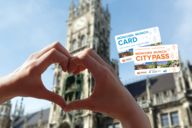
Munich Card & City Pass
Simply discover munich: with munich card and city pass.
There are two official guest cards for a relaxed and uncomplicated discovery of the diverse range of art, culture and leisure activities in Munich: the München Card and the München City Pass. All benefits at a glance.
Guest cards for Munich in comparison: Which card is worthwhile?
World-class museums and stages , famous palaces , many diverse attractions , supplemented by a large range of leisure activities , shopping and excellent cuisine : Munich offers everything that appeals to city travellers. With the guest cards, you can now experience Munich in all its facets and save big at the same time.
Guest cards at a glance
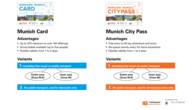
The Munich Card
Reduced admission from 8,90€.
The München Card offers a wide range of reductions and discounts on entrance fees to museums, exhibitions, sights and attractions. City tours can also be booked at a reduced price. Supplementary shopping and gastronomy offers complement the Munich Card. Another optional highlight is the included ticket for local public transport, which allows you to easily explore the city by metro, tram, bus and suburban train.
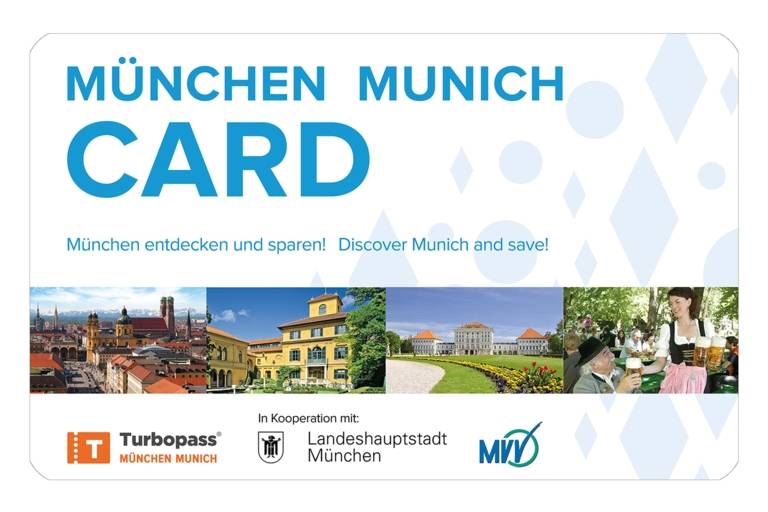
Now new: Enjoy all discounts even without a public transport ticket! You already have an annual ticket for Munich's public transport system or prefer to explore the city on foot? Then this option is just right for you.
Buy a Munich Card now!
Tip: The Munich Card is ideal for individuals and small groups / families who want to explore the city and save money at the same time!
The Munich City Pass
All inclusive from 24,90€.
With the Munich City Pass, everything is already included: the public transport ticket for Munich (optional), free admission to museums, exhibitions, tours and sights, and in some cases even priority admission without annoying waiting times. Supplementary offers for shopping and restaurants help to complement a fabulous visit to Munich.
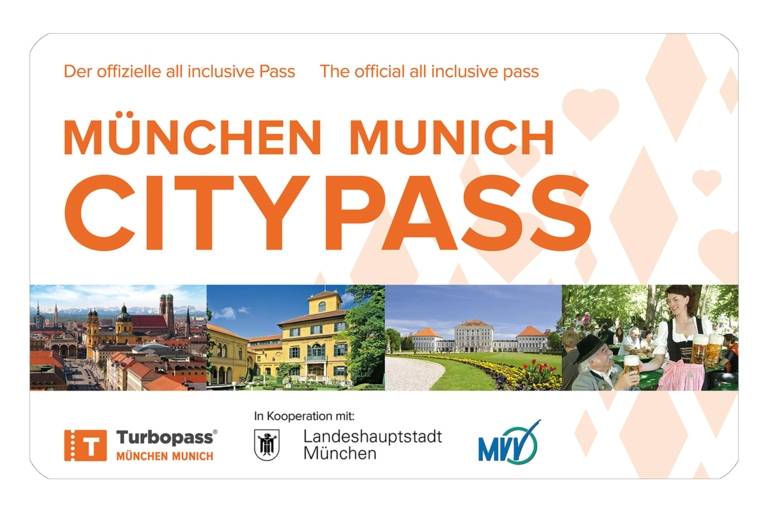
Now new: Munich City Pass without a public transport ticket! Ideal for anyone who already has a monthly or annual public transport ticket or simply prefers to discover the city on foot.
Buy a City Pass now!
Tip: The Munich City Pass is ideal for visitors who make their plans in a price-conscious way and who want to see as much as possible of the city and its cultural attractions!
What does the Munich Card cost? What does the Munich City Pass cost?
What does the Munich Card cost?
What does the Munich City Pass cost?
Adults (18+ years)
Children (6-14 years), youths (15-17 years), city area m, zone m-6 (including the airport) or without public transport, free use of local public transport.
Depending on the choice, holders of both the München Card and the München City Pass can use the Munich public transport system (MVV) free of charge.
Or now new: Both guest cards are now also available without a public transport ticket.
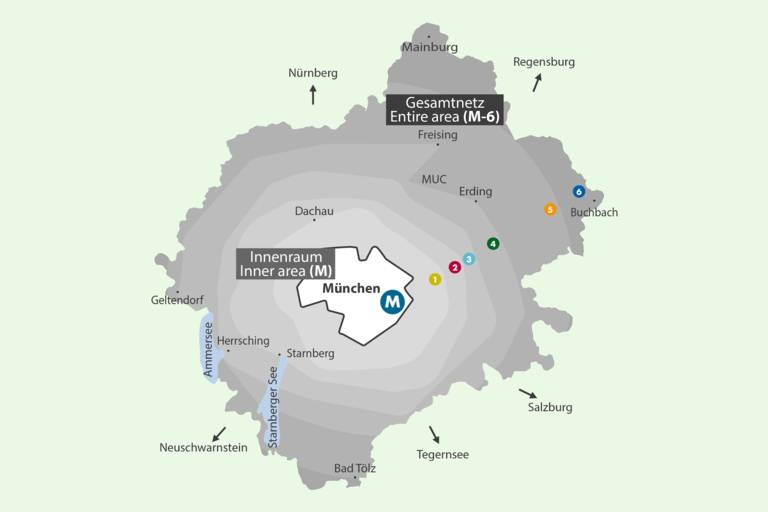
Of course, Card and Pass can still be booked either with the entire network (Zone M-6) or with Zone M only. If you book a card to cover the whole of the Munich public transport area, suburban railway travel to and from Munich Airport is included in the price. The validity can be individually adapted to your needs.
Frequently asked questions about the Munich guest cards
Where can I buy the Munich Card and the Munich City Pass?
Both tickets can be purchased online and at the tourist information offices at Marienplatz and Hauptbahnhof. The validity is already stated on the guest cards when they are purchased via the website or at the tourist information offices. In addition, the Munich Card is also available at the ticket machines of the Münchner Verkehrsgesellschaft (MVG).
Does the Munich Card/Munich City Pass have to be validated?
Only the Munich City Card , which is purchased at the ticket machines of the MVG (Münchner Verkehrsgesellschaft), must be validated before first use. On the guest cards, which can be purchased online or at the tourist information offices at Marienplatz or Hauptbahnhof, the valid period is already printed on the card.
The Munich Card is available from €5.90, the Munich City Pass from €39.90.
What are the benefits of the Munich Card and the Munich City Pass?
The Munich Card offers discounts on over 100 offers. In most cases, discounts of 10 to 30 per cent can be obtained, but in some cases the discounts are even higher. The Munich Card is also available as a group ticket for up to five people and can be booked flexibly for a length of stay of 24 hours to five days. Here you can find all the benefits as a PDF .
The Munich City Pass allows free entry or discounts at 45 top attractions and tours. In some cases, Munich City Pass holders are given priority admission and do not have to queue. The Munich City Pass can also be booked flexibly for 24 hours up to five days. Here you can find all the benefits as a PDF .
What is the difference between the Munich Card and the Munich City Pass?
The Munich Card offers discounts and reductions on museums, exhibitions and attractions. With the Munich City Pass , you pay no admission fee at many participating institutions and in some cases even get priority admission without waiting.
From when and for how long is the Munich Card/Munich City Pass valid?
The Munich Card and Munich City Pass are valid from midnight on the first day of validity until 6 a.m. the next day after expiry. The Munich Card 24h is an exception. Here, the validity of 24 hours can be determined individually, e.g. 7.30 a.m. until 7.30 a.m. on the following day.
Who is the Munich Card suitable for? Who is the Munich City Pass for?
The Munich Card is ideal for flexible singles or groups who want to explore the city and save money at the same time! The Munich City Pass is ideal for all those interested in culture who want to plan their stay in Munich well and take in as much of the city and its cultural offerings as possible.
How do I receive my guest card?
You will receive the guest cards as an attachment to your booking confirmation by email. Please note: If your purchase date is more than three months in the future, there will be no attachment - you will receive the guest cards directly from our partner Turbopass shortly before your trip.
Can the Munich Card / Munich City Pass be cancelled free of charge?
Both guest cards can be cancelled free of charge up to 24 hours before the start of validity.
Is it possible to give the Munich Card/Munich City Pass as a gift?
Yes, vouchers for the Munich Card Group 3 days Zone M or the Munich City Pass 1 day Zone M are available online.
The Munich Card ( all benefits in a PDF file ) and the Munich City Pass ( all benefits in a PDF file ) are distributed by Turbopass in cooperation with München Tourismus and the City of Munich. Both cards can be ordered online and at the Tourist Information at Marienplatz and Hauptbahnhof (central station).
Here you will find an overview of all our maps and brochures ready to download.
Photo: Turbopass; Graphics: Turbopass
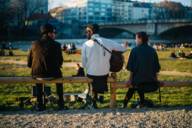
Local Love Munich
Munich's districts are diverse, contrasting and worth exploring. Immerse yourself!
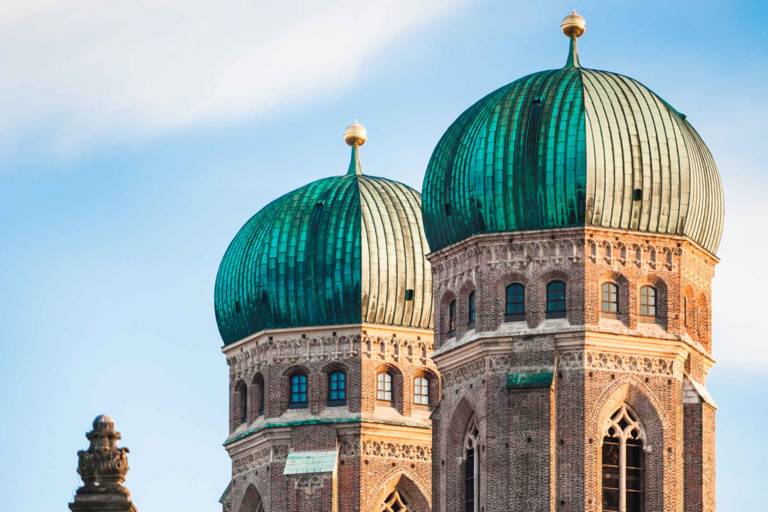
Frauenkirche: Visit of the South Tower
Book a visit to the observation deck of Munich's Frauenkirche and enjoy a 360-degree panoramic view of the city.
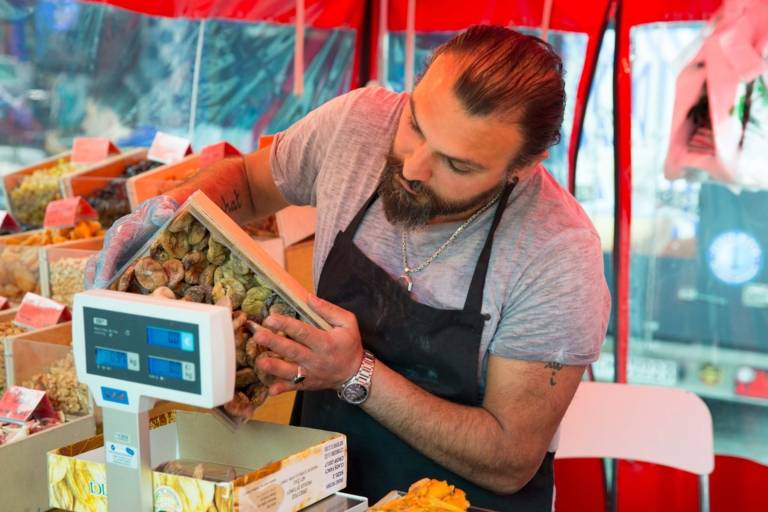
Viktualienmarkt Tasting Tour
Discover the most delicious delicacies of the city and learn all kinds of interesting facts about Munich's most famous food market.
Discover the most delicious delicacies of the city and learn all kinds of interesting historical facts about Munich's most famous food market.
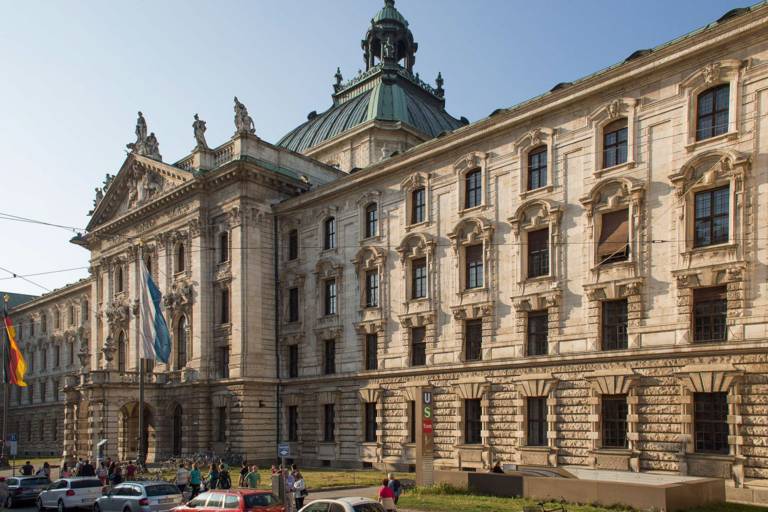
Justizpalast Tour
During the guided tour of the present-day seat of the Bavarian State Ministry of Justice, you will learn everything about the history and significance of the neo-baroque court and administrative building.
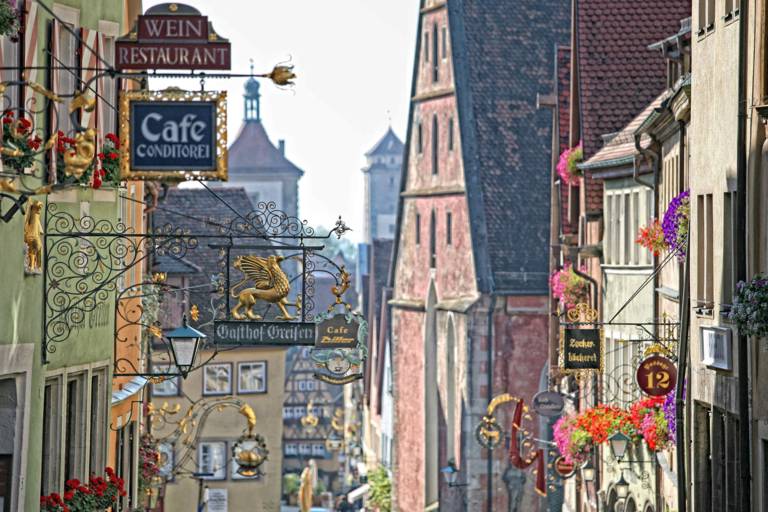
Romantic Road: Rothenburg and Harburg
Hop on and be whisked away by one of the world's most beautiful stretches of street: the Romantic Road to Rothenburg and Harburg.
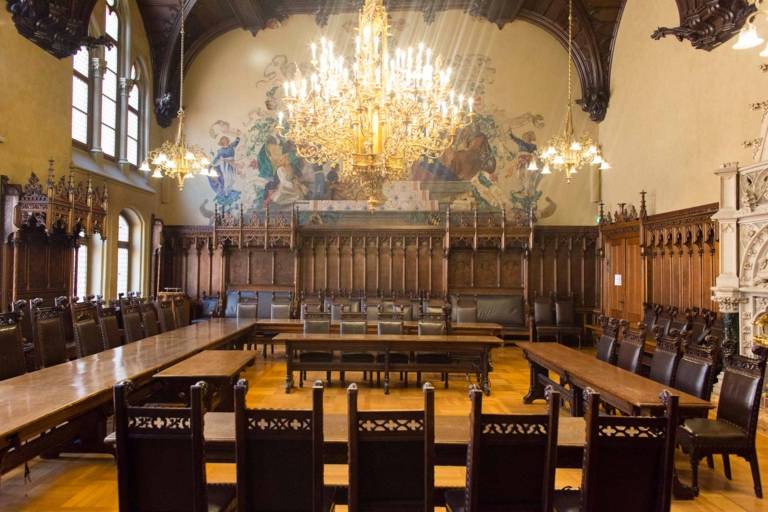
New Town Hall Tour
Explore the Neue Rathaus on Marienplatz with an official City of Munich tour guide. A visit of the famous law library is also included!
Explore the Neue Rathaus on Marienplatz with an official tour guide. A visit of the famous law library is also included!
Magistrates, Monachia and magnificent celebrations: explore the Neue Rathaus on Marienplatz with an official City of Munich tour guide. A visit of the famous law library is also included!
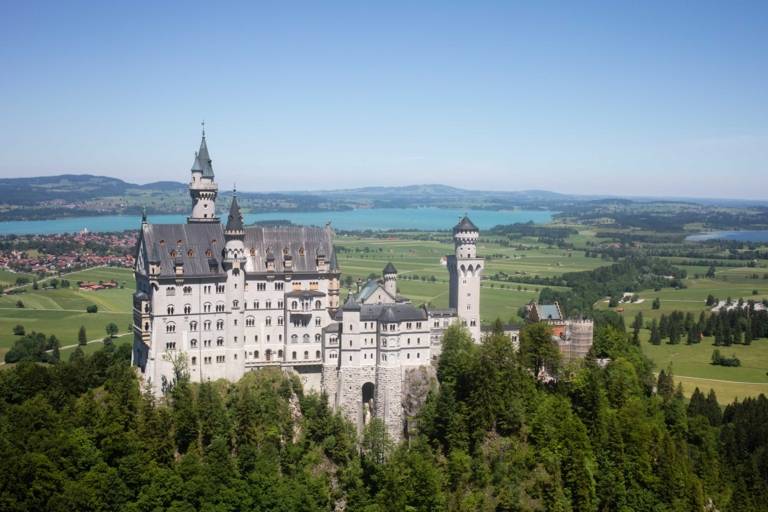
Dream castles Neuschwanstein & Linderhof
Immerse yourself in the world of the fairytale king!
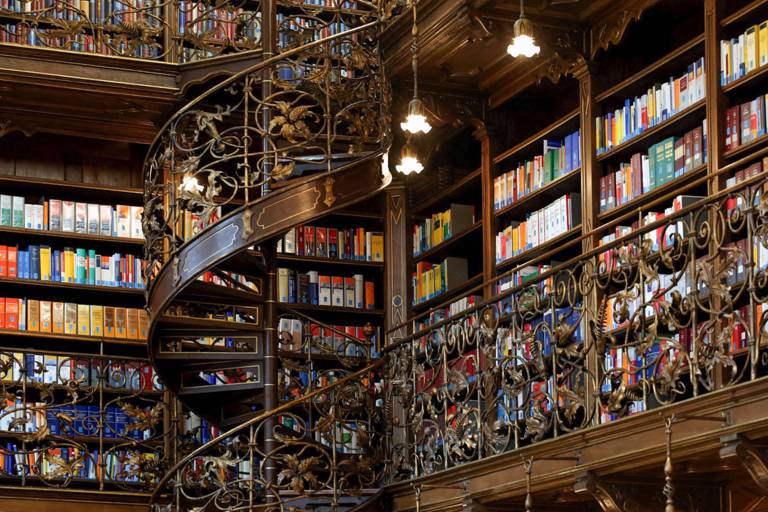
Visit of the Law Library: Juristische Bibliothek
Impressive architecture and unique ambience: discover the Law Library in the New Town Hall.
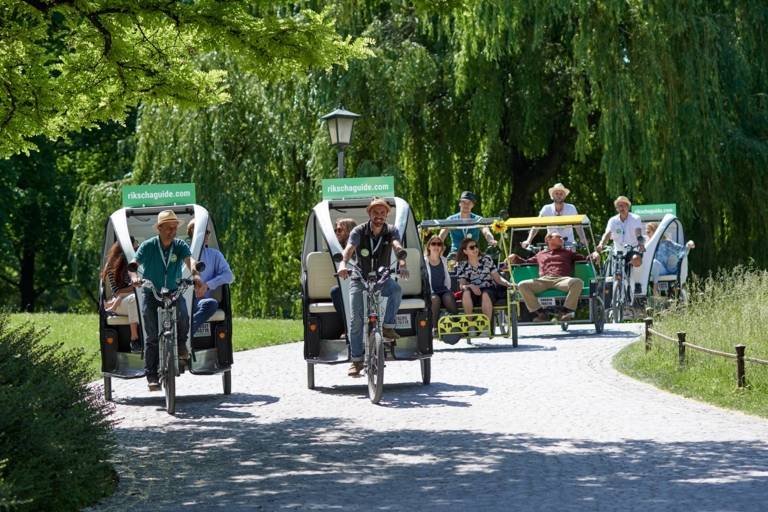
Pedicab tour through the old town and nature
Enjoy this special tour and pedicap ride past all the famous sights of Munich's old town and into the Englischer Garten.
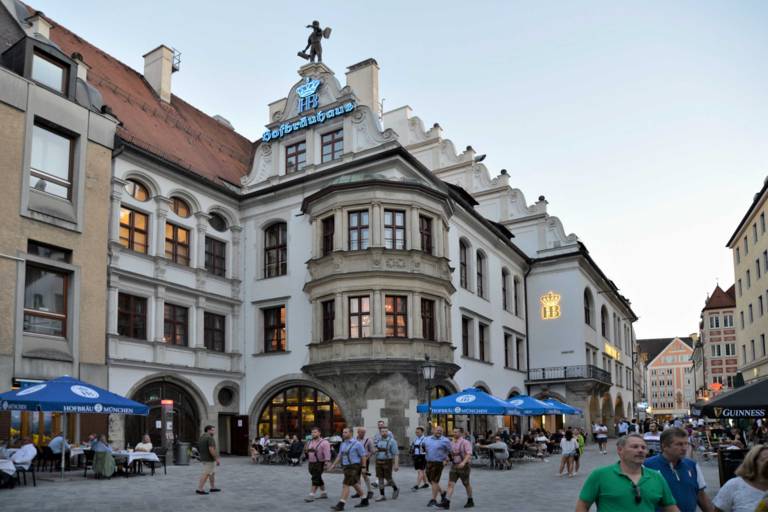
Hofbräuhaus Tour
Discover the most famous beer hall in the world with an official guide of the city of Munich and enjoy a fresh Mass of beer afterward!
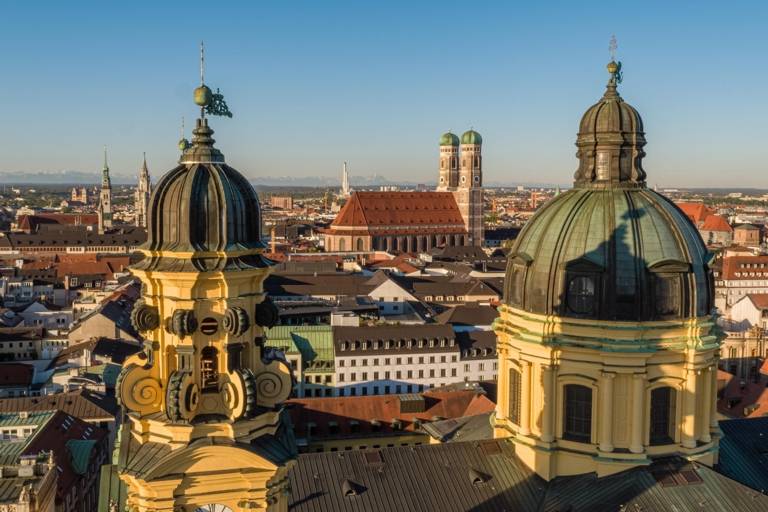
City trip incl. Munich Card and Tower Ascent
We look forward to seeing you again in Munich. Our tip: the exclusive travel package with Munich Card and Tower Ascent.
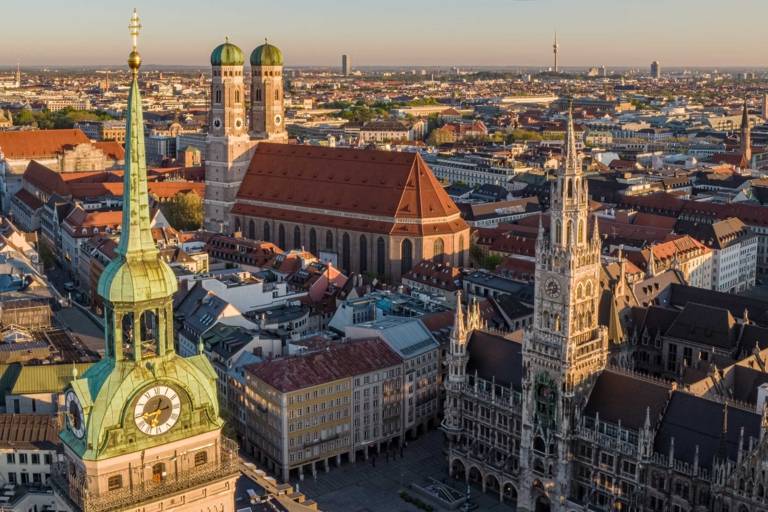
Old Town Tour
The city walk for everyone who wants to become acquainted with the most beautiful parts of Munich's city centre.
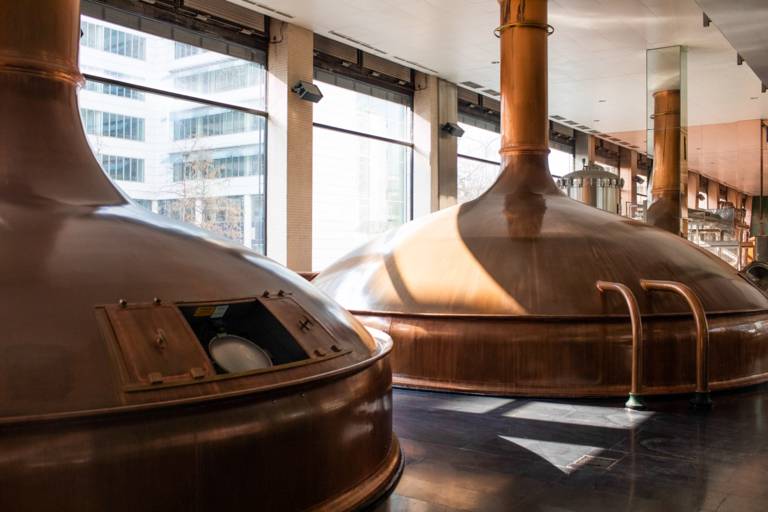
Spaten Brewery Tour
Experience a brewery tour at Spaten with a look behind the scenes, interesting facts about the company history and beer tasting in the brewery tower.
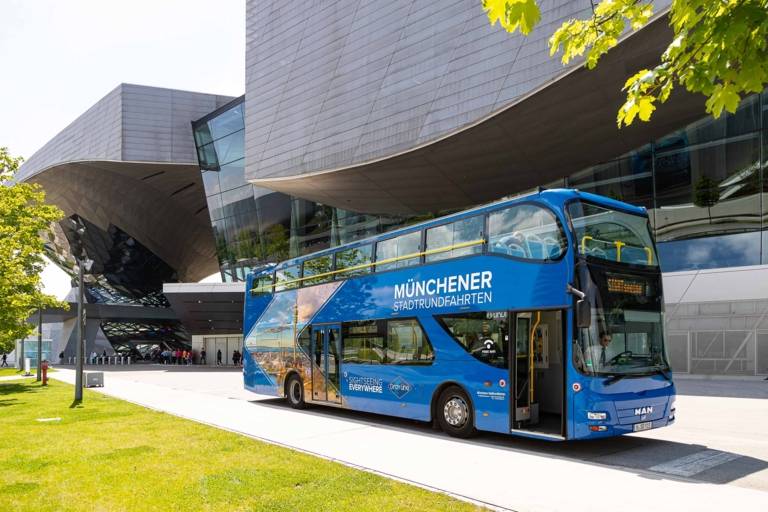
Hop-On Hop-Off Grand Circle 24h
The hop-on hop-off Grand Circle tour of Gray Line will let you collect unforgettable impressions of Munich.

Buy now vouchers for your visit in Munich. The ideal gift! Guided tours, guest cards and more...
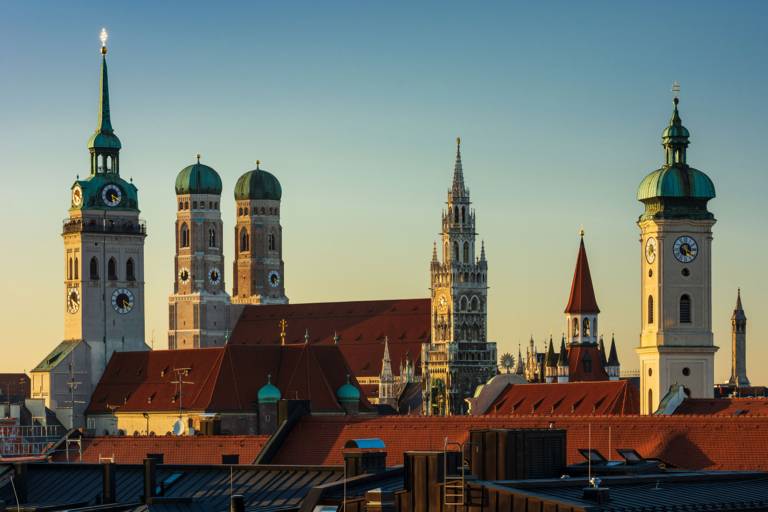
Private guided tour through Munich's Old Town
Exclusive and safe: Discover the most beautiful sights and corners of Munich's city centre with your official personal guide.
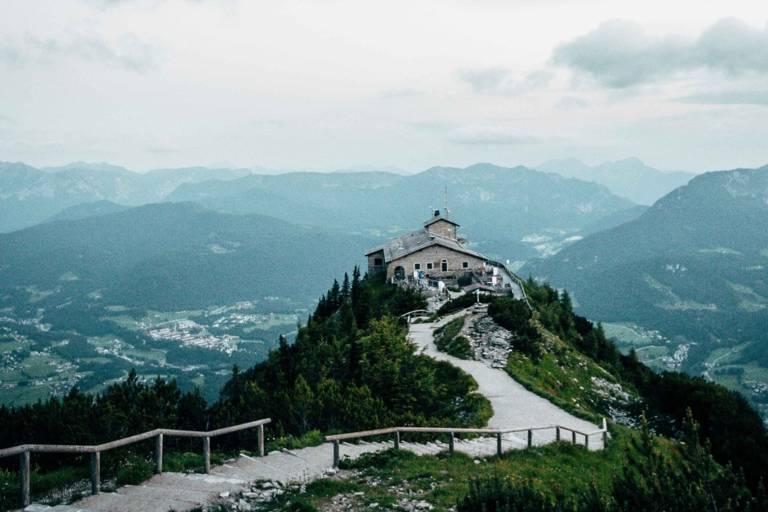
Berchtesgaden area and Eagle's Nest
The day trip takes you along the Alpine Road to Berchtesgaden area with its dreamlike scenery.
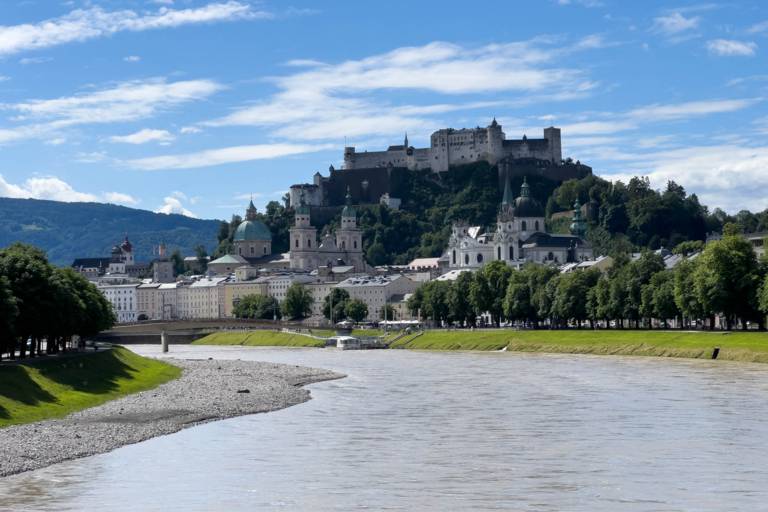
Salzburg and the Lake District
Visit the birthplace of Wolfgang Amadeus Mozart and relax on the journey to beautiful Lake Wolfgang.
Visit the birthplace of composer extraordinaire Wolfgang Amadeus Mozart, stroll through the Baroque old town and then relax on the journey to beautiful Lake Wolfgang.
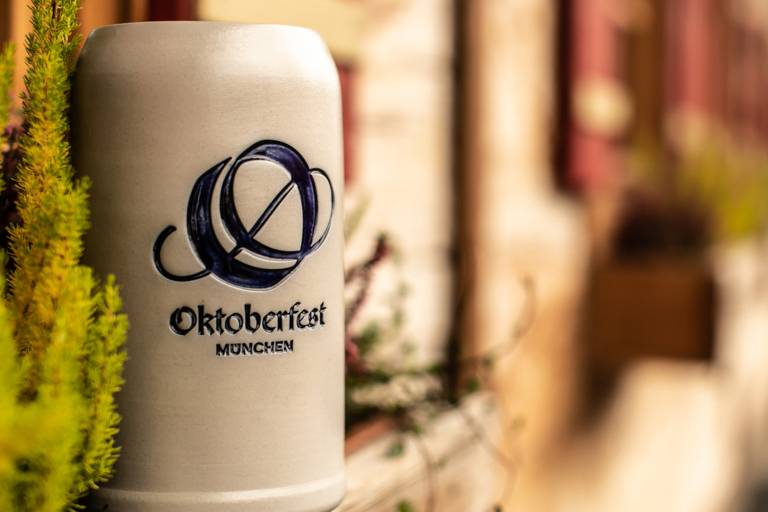
Oktoberfest Shop
Bring a piece of Oktoberfest home: Purchase official souvenirs such as the Wiesn poster or the Oktoberfest beer stein in the official Oktoberfest shop.

Dream castles Neuschwanstein & Linderhof VIP
As VIP in the footsteps of King Ludwig II. On this day tour in the luxurious long-distance coach of Gray Line Sightseeing you can visit both dream castles of the fairytale king.
A day tour in the luxurious long-distance coach of Gray Line Sightseeing.
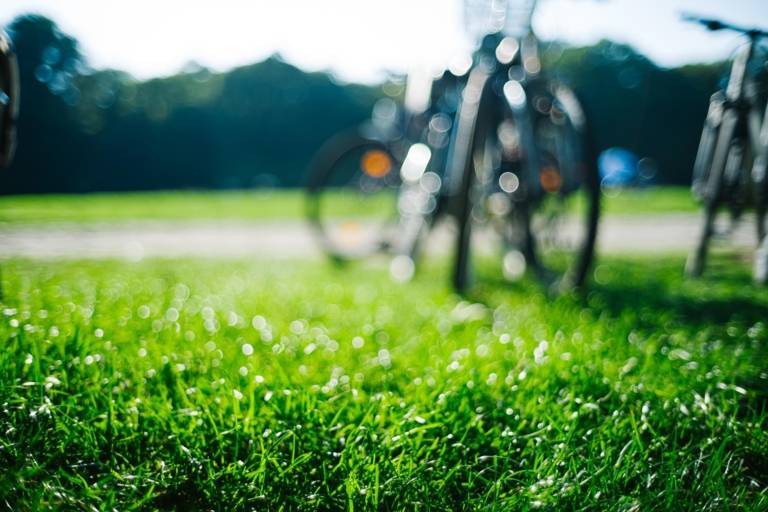
Rental bike 1 day
With a rental bike, you can experience Munich at your own personal pace. Discover hidden alleys and charming districts off the beaten track.

Discovery trip incl. City Pass
2 nights in your selected hotel and - thanks to the City Pass - free admission to 45 museums, sights and attractions: our travel package for explorers.

Guided Tours
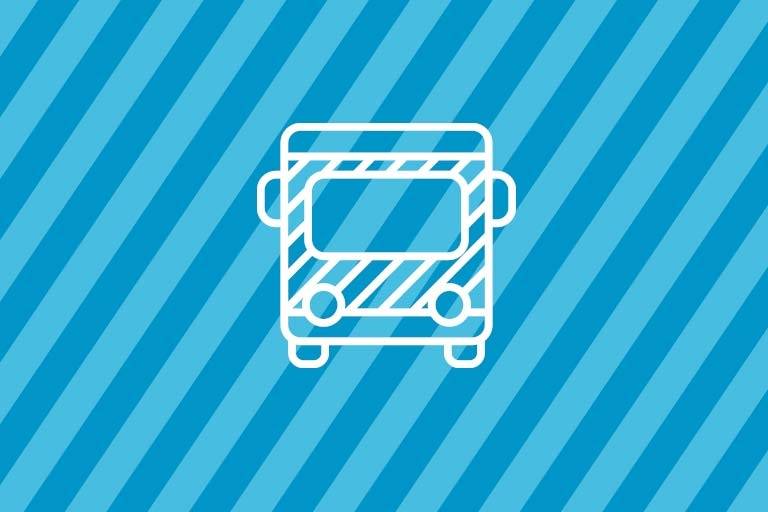
Travel Packages
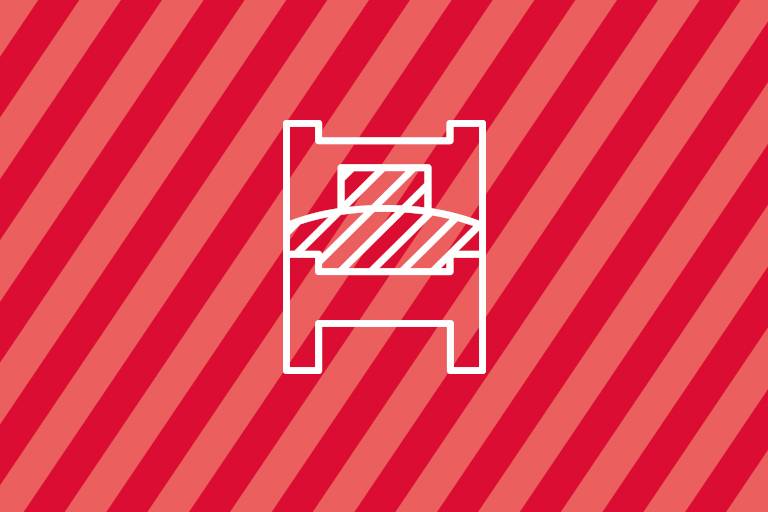
Accomodation
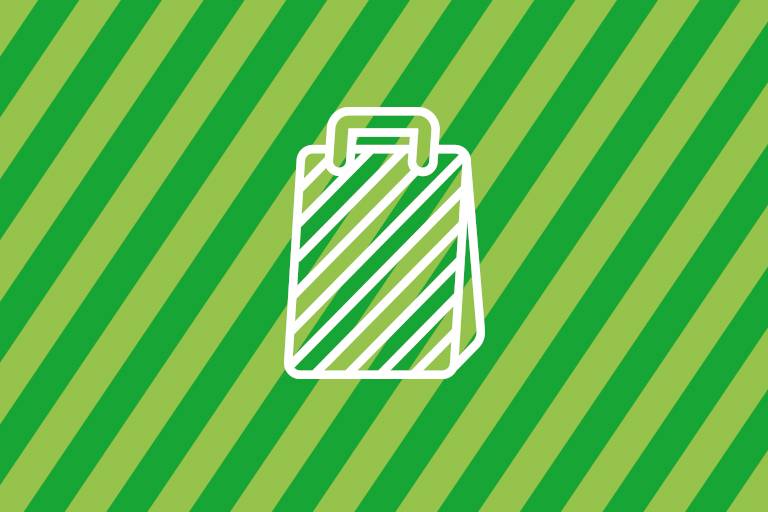
Give the gift of a special Munich voucher: we also offer vouchers for all our guided tours. Here you can book unique Munich experiences directly online, print them out and give them as a gift voucher to friends or family.

- Book excursions
- Book the Munich-Card
- Book guided tours
Find your hotel now
Travel date
You are using an outdated browser. Please upgrade your browser to improve your experience.
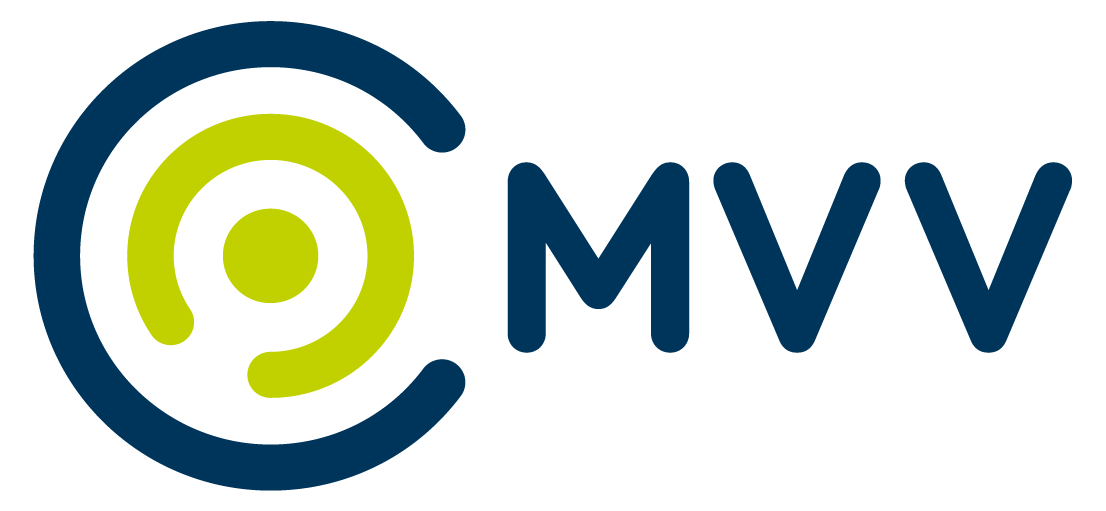
- Journey Planner
- Timetable changes
- Mobile Services
- MVV Cycle Planner
- MVV Ticketshop
- All tickets, all prices
- Tickets & Day Tickets
- Offers for frequent travellers
- Online- and Mobileticket
- Tariff structure
- Buy tickets (alternatives)
- Service centres
- Mobility services
- MVV without barriers
- Visitors to Munich trade fairs
- Air travellers
Single Ticket
The Single Ticket is for a single trip in the direction of the destination. You are allowed to change and interrupt your trip. Return trips, however, are not permitted.
The Single Ticket is ideal for spontaneous journeys with the MVV – and it is even cheaper when bought at a ticket machine by cashless payment. If you're planning more than 2 trips in the Munich city area per day, we recommend purchasing the Day Ticket.
At a glance
Questions & answers, how long is a single ticket valid.
Maximum travel time 1 hour Short Trip Ticket 2 hours Zone M or 2 Zones 3 hours starting at Zone M - 1 or starting at 3 Zones 5 hours starting at Zone M - 5 or starting at 7 Zones
Do I have to validate my ticket?
Yes, you do. All tickets must be stamped prior to the start of your journey. However: tickets bought at ticket machines on trams or buses are already validated at the time of purchase. When using the ticket machines of Deutsche Bahn, you can choose whether to buy pre-validated tickets or tickets which must be validated separately.
How do you count the zones?
If a single trip passes through the same zone twice, then you must pay for this zone only once.
What are return trips?
Return trips are journeys which go in the direction of your starting point and follow exactly the same route as the one you chose for your outward journey.

IMAGES
VIDEO
COMMENTS
Zones. The MVV area is divided into tariff zones for all ticket offers: Zone M covers the entire Munich city area and in some cases extends beyond it. Zones 1 to 12 cover the districts belonging to the MVV area. Munich Airport is located in zone 5. On the new network plans, each stop is also marked with the corresponding zone (e.g. Harthaus in ...
Munich Zone Map. As mentioned above, Munich is divided into 7 tariff zones. You can view a colour-coded map of the tariff zones here. The zones (and their colours) are as follows: M Zone (White): Encompasses the majority of the central Munich area; Zone 1 (Yellow) Zone 2 (Red) Zone 3 (Light Blue) Zone 4 (Green) Zone 5 (Orange): Where Munich ...
Children under the age of 6 travel for free. ... Map of the Munich tariff zones. A trip within one zone - for example in zone M - is the cheapest. A longer, cross-zone trip costs more.
Zone M covers the entire Munich city area and some neighbouring municipalities. Zones 1 to 12 are located in the area surrounding Munich. Munich Airport (S1 or S8), for example, is in zone 5, Herrsching am Ammersee in zone 3 (S8) and Tutzing on Lake Starnberg in zone 4 (S6). To travel from Munich Airport to the city centre, you therefore buy a ...
Figuring Out Munich's Public Transport Zones. Once upon a time, this was the most confusing part of the Munich public transport system but luckily, ever since the they rehauled the system in December 2019, it's a lot easier to understand. This aggressively overwhelming map breaks down Munich's new zone system, which includes 7 concentric ...
1 zone: € 3.90 (US$ 4.20) 2 zones: € 7.70 (US$ 8.30) 3 zones: € 9.70 (US$ 10.40) 4 zones: € 11.60 (US$ 12.40) Children between 6 and 14 years old only pay € 1.80 (US$ 1.90) per journey no matter how long the trip is. Stripe ticket. Stripe tickets are a strip of 10 single tickets that can be used for multiple people and journeys.
The main disadvantage to Munich's public transit system is the price, as it's expensive. A single ticket within the central zone is 3.30 Euros. You can save money by buying a "Streifenkarte" (striped ticket) for ten individual rides, a daily, weekly, monthly or even yearly pass if you will be using transit frequently.
S-Bahn: Eight lines that travel throughout the city and link Munich to the suburbs. This is what you'll take from the airport and transferring to the city center is easy on the S-Bahn on lines S1 and S8. ... Short Trip Ticket: 1 hour, 1 zone: 3 hours, 2 zones and Single Ticket for children/children (6-14 years): 4 hours; IsarCard: If you are ...
S-Bahn (aboveground city railway): 8 Lines for quick traveling. In contrast to the U-Bahn, tram and bus, the S-Bahn is not run by the MVG (Munich Transport Company), but instead by Deutsche Bahn ...
Munich Travel Guide. Munich, the largest city in southern Germany and the capital of Bavaria, is famous for its annual beer festival, Oktoberfest. But there's a lot more to visiting Munich than drinking steins of beer. The city is host to a beautiful historic city center, an old castle, large parks and gardens, hearty German food, and beer ...
Get around like a local on two wheels. Cycling is one of the best ways to get around Munich. The city has an extensive bike lane network, including several routes through parks and along the river. Many locals favor this mode of transport, opting for two wheels to commute to work, head out for dinner or ferry around kids.
The München Card is the official Munich guest card for your sightseeing experience. The ticket contains a day ticket for the public transport within the selected area of the MVV network and discounts of up to 70% at numerous sights, attractions, tours, shopping and gastronomy partners. The München Card is available for adults or children and ...
Trains, trams and buses: Munich's public transport network is efficient and economical. Discover how best to get around the city with our handy guides. Civitatis Munich. Travel Guide ... Fares for Munich's public transport network are the same for every mode of transport making it really easy to travel. See all the different tickets here! Read ...
Dachau is located in this zone, that is, a ticket to zone XXL is required to travel there. Entire zone called Ausserraum. Includes green, yellow and red zones. Gesamtnetz - All Four Areas. If you need to get from the center to Munich Airport, then buy a ticket for all zones. Tickets for public transport in Munich (prices for October 2019)
Tickets & Tariffs - Overview. The public transport network in Munich is divided in zones and rings and the tariff system can be even complicated for Munich locals. You can get lots of informations on the Homepage of the MVV. You can purchase your ticket at ticket machines at nearly every station. In Buses and Trams you can buy your ticket inside.
The Tariff System The Munich urban area is grouped together in Zone M. Adjacent municipalities are divided into zones 1-6. Here you can check in which zone your station is located and which ticket you need for your journey.; Single tickets, day tickets and 3-day tickets can be purchased either for zone M only, for selected zones 1-6 only or for zone M plus any number of zones.
21. Take advantage of 1 euro museums on Sundays. One of my best money-saving tips for Munich is hands down the amazing fact that many of the city's top museums offer 1 euro entry on Sundays. 1 euro! So, if you time your visit for a Sunday, definitely take advantage of this.
CityTourCard. The CityTourCard includes a day ticket for use on public transport in the MVV network within the selected area of validity, as well as discounts for more than 80 tourist attractions in Munich and the surrounding area. The CityTourCard is available as a Single or Group Ticket for a group of up to 5 adults, whereby any two children ...
The official travel guide Munich Pass: free admission to 45 attractions Card: discounts for over 100 offers Local public transport free Discover now! ... (Zone M-6) or with Zone M only. If you book a card to cover the whole of the Munich public transport area, suburban railway travel to and from Munich Airport is included in the price. The ...
If you're planning more than 2 trips in the Munich city area per day, we recommend purchasing the Day Ticket. At a glance Single Ticket Single Ticket for children aged 6-14 ... Fares with the Zone M 3,90 € 1,80 € Fares out of the Zone M ...